The era of atomic testing began in 1946 with Operation Crossroads. At the time it was the largest U.S. peacetime military operation ever conducted.
41,963 men, 37 women, 242 ships, 156 airplanes, 4 television transmitters, 750 cameras, 5,000 pressure gauges, 25,000 radiation recorders, 204 goats, 200 pigs, 5,000 rats, and the atomic bombs gathered to answer a simple question:
Was the U.S. Navy vulnerable to the new Atomic Bomb?
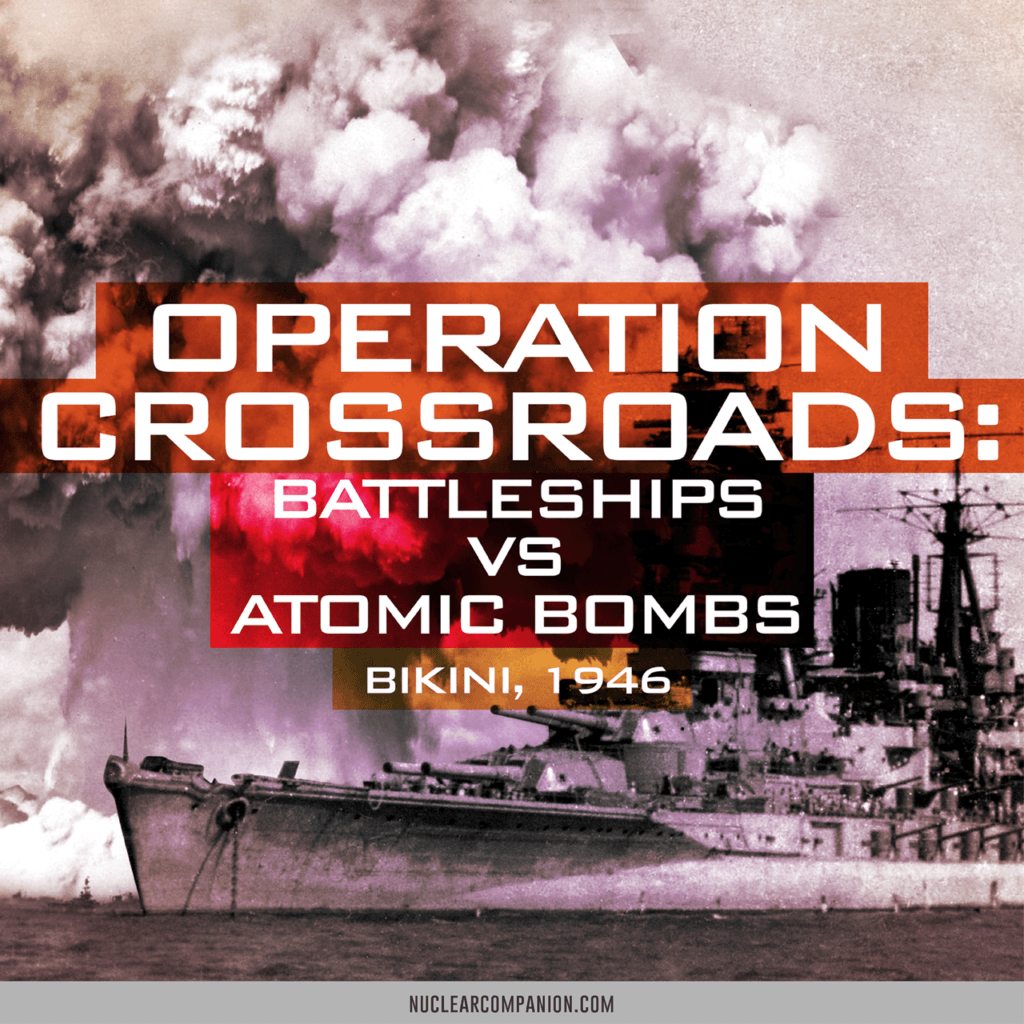
Introduction
The first atomic bomb exploded on July 16, 1945, but it was covered in secrecy. But then, twice, first at Hiroshima and then at Nagasaki, the whole world perceived that it had entered a new age.
Suddenly, the basis of the existence of many people was altered. If one atomic bomb can destroy an entire city, could it sink an entire fleet? Was the U.S. Navy obsolete? In the postwar world where the U.S. Navy had to secure funding, was it still relevant?
So, this is how the world’s fourth and fifth nuclear detonations in history were born. They were not used for weapons development as the major part of U.S. tests. But to test the effect of a nuclear bomb over a target fleet.
The U.S. Navy expected to sail the target fleet back to homeport to demonstrate the negligible effects of atomic weapons against naval vessels.
In the end, the U.S. Navy was much chastened by the tests, the U.S. Air Force was embarrassed, and Crossroads became the World’s first nuclear disaster.
Its story is what you’re going to learn right now…
The defeated Japanese fleet
By the beginning of World War 2, the Imperial Japanese Navy (IJN) was the third largest navy in the world.
In fact, at the start of the Pacific War:
- It was more powerful than the combined British and U.S. fleets in the Pacific area.
- It possessed the most powerful carrier force in the world.
- It included ten battleships, giving it the third-largest battle line in the world.
- It was at numerical parity with the USN regarding heavy cruisers. These had a reputation for superior size and firepower.
- Its destroyers were formidable opponents and were generally larger than their Allied counterparts and were better armed in most cases.
But, four years later at the time of Japan’s surrender, the IJN was reduced to a shadow of their former glory.
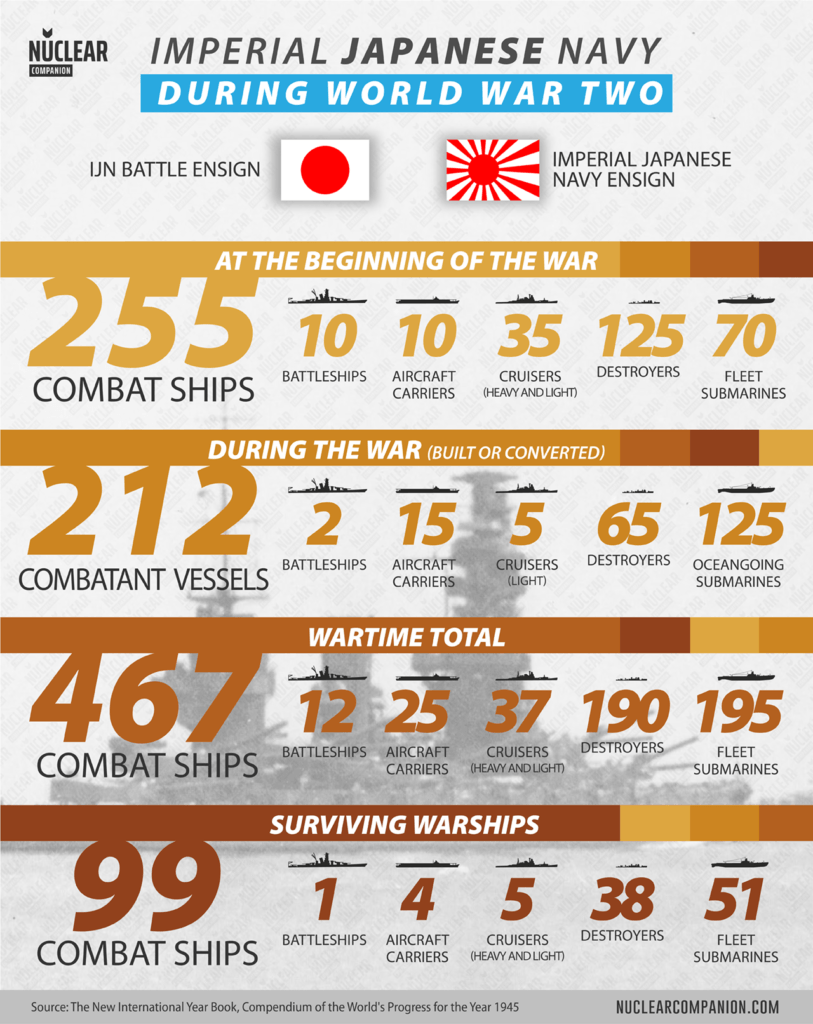
When the war ended, there was only one Japanese battleship still afloat. It was the pride of the IJN: Nagato.
She was the largest and most powerful battleship in the world when commissioned in 1920. And It had been Admiral Yamamoto’s flagship during the attack on Pearl Harbor.
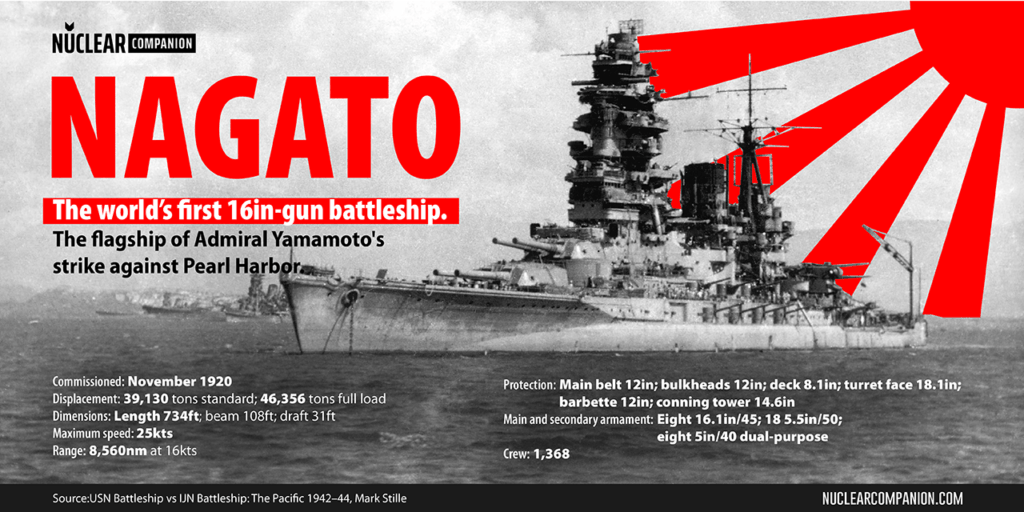
Nagato’s last action was the Battle of Leyte Gulf. After that, due to fuel shortage, it was assigned in 1945 to the Yokosuka Naval District. There, Nagato served as a floating antiaircraft battery until the war’s end.
In the end, the Japanese Navy would cease to exist. The 10 large warships would be scuttled and the smaller ones transferred to the United Nations powers.
However, Nagato’s fate would be a different one…
The U.S. Navy at the end of World War II
In contrast, at the end of World War II, the U.S. Navy was the strongest in the world.
In three and a half years the U.S. Navy had:
- Destroyed so much of the Imperial Japanese fleet that it had ended as an organized fighting force.
- Defeated the German U-boat threat during The Atlantic Battle
- Supported the greatest amphibious campaigns in history (MacArthur’s island-hopping)
To achieve that, the U.S. Navy in 1945 had grown to 3.4 million men, 1,200 combatant ships and 40,000 aircraft.
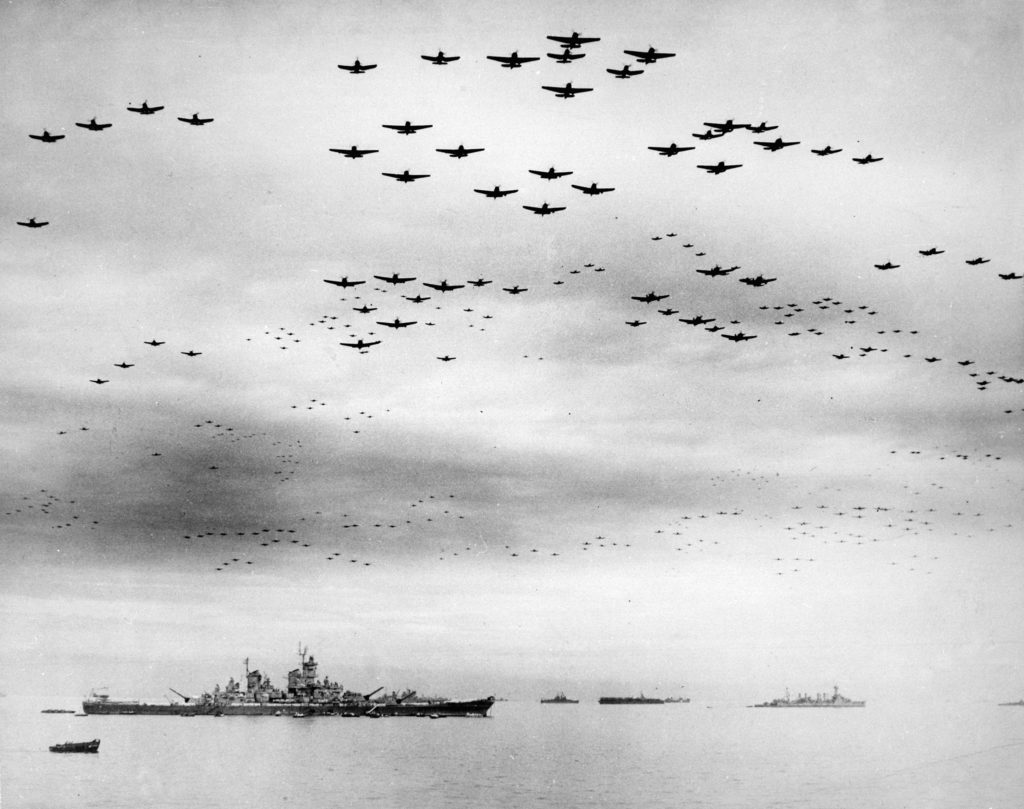
Despite its triumph and strength, the U.S. Navy faced a new threat. Not only U.S. Navy’s ships were vulnerable to an Atomic Attack but the U.S. Air Force had a monopoly on Atomic Weapons.
Also, with the end of the war, the U.S. Navy had to demobilize this enormous military capacity. In September 1945, Secretary of the Navy, James V. Forrestal predicted a peacetime navy of 400 combatant ships.
In the end, the war ended leaving the U.S. Navy with such a sense of uncertainty and an obscure future…
Road to Crossroads
But the U.S. Navy would respond quickly to this new threat.
Seven days after the atomic bombing of Nagasaki, Commodore Lewis L. Strauss sent a memorandum to his boss: James V. Forrestal, secretary of the Navy. Strauss, who was Forrestal’s Special Assistant and a navy member, had no role in the manhattan project. But, he would become later an important figure in the Atomic Energy Commission.
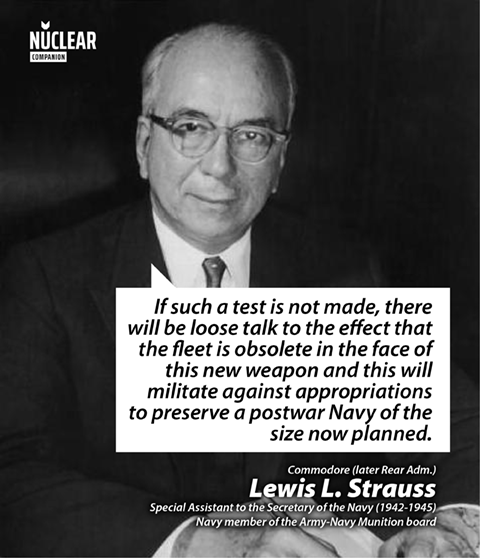
In his message he recommended test ships’ ability to withstand the atomic bomb:
“If such a test is not made, there will be loose talk to the effect that the fleet is obsolete in the face of this new weapon and this will militate against appropriations to preserve a postwar Navy of the size now planned.”
Lewis L. Strauss
Forrestal agreed. But for him, the question was not if the ships could survive against atomic bombs but how the navy could employ atomic weapons. He was sure the U.S. Navy needed its own program of research and development together with cooperation with private university laboratories.
The Sinking of the Ostfriesland (1921)
This was not the first time that the U.S. Navy faced the threat of new technology.
In June 1921, U.S. Army Air Corps general, William “Billy” Mitchell was able to arrange a series of tests of bombers versus battleships off the Virginia Capes. It resulted in the sinking of the elderly German Jutland veteran dreadnought Ostfriesland.
The U.S. Navy had responded to the threat of aviation by incorporating it into its service in the 1920s and 30s.
By November 1945, Forrestal had established the Office of Special Weapons (OP-06) under Vice Adm. William H. P. Blandy. Not only had Blandy responsible for developing nuclear energy but also missiles and all other foreseen new Weapons.
But the U.S. Navy atomic worries were only the tip of the iceberg…
The Nimitz proposal
On August 28, 1945, Fleet Admiral Chester Nimitz, Commander in Chief Pacific (CICNPAC), recommended that the surviving Japanese warships be destroyed.
Chief of Naval Operations (CNO) Fleet Admiral Ernest King submitted Nimitz’s proposal to the Joint Chiefs of Staff (JCS). But the JCS had to wait until the return of Secretary of State, James F. Byrnes, to take any action. Destroying the Japanese ships was not only of interest to the U.S. but also the Russians, British, and Chinese.
Byrnes was participating in the first post-war conference of foreign ministers in London. He would not return until the 4th of October.
A provocative question
In 1945, Senator Brien McMahon had been in Congress barely a year. But he was an ambitious freshman Democrat from Connecticut. Later, he would better be known for introducing the first bill dealing with atomic energy into the Senate.
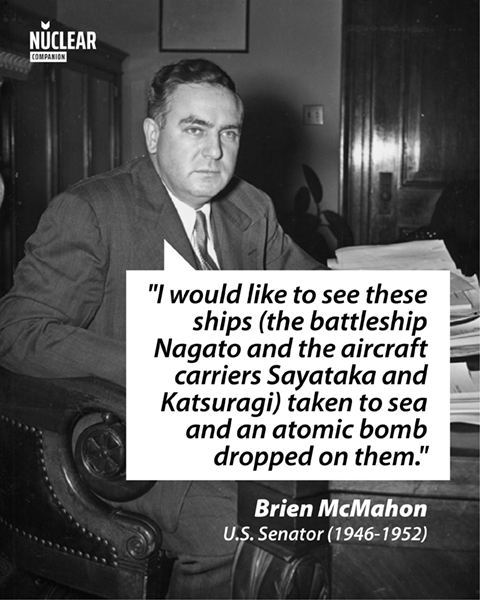
On August 25, 1945, during the Annual Jefferson Day dinner of the Connecticut Democratic Party in New Haven, he suggested:
“I would like to see these ships (the battleship Nagato and the aircraft carriers Sayataka and Katsuragi) taken to sea and an atomic bomb dropped on them.”
“The resulting explosion should prove to us just how effective the atomic bomb is when used against the giant naval ships. I can think of no better use for these Jap ships.”
Senator Brien McMahon
McMahon insisted that the Atomic bombs used in Japan did not provide enough evidence of the bomb’s true power. Quickly his voice echoed among several members of the military…
The Giles proposal
On September 14, 1945, Lt Gen Barney Giles, acting Commander of United States Army Strategic Air Forces (USASTAF), echoing Senator Brien McMahon elevates the idea to his superior, General Hap Arnold of the AAF:
“We now have full information on the Atomic bomb on land targets. Strongly recommend that we use at least two more atomic bombs in the destruction of remnants of the Japanese fleet.
One atomic bomb should be statically discharged below the surface. I have discussed the matter with General MacArthur and he is in full agreement.“
Four days later, Arnold raised the proposal to the Joint Chiefs of Staff. He proposed the chiefs to determine military requirements for Japanese ships “suitable for future experimentation with conventional bombs, atomic bombs, guided missiles, and other possible new weapons”. Thus, opening these ships for use in tests involving atomic bombs.
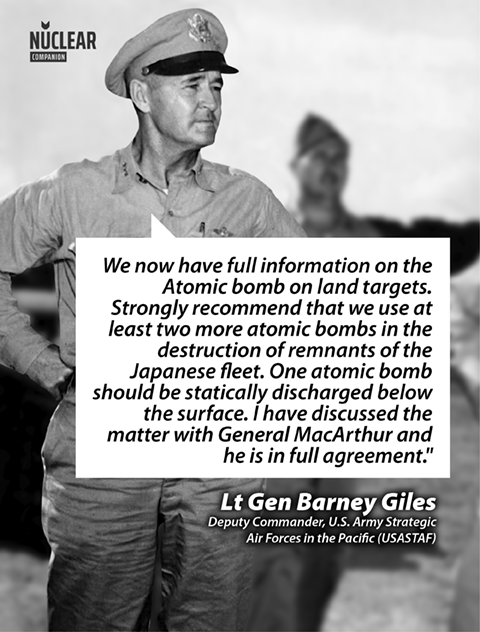
The Joint Chiefs of Staff decreed that some of the Japanese ships to be preserved for experimentation. It was to General of the Army Douglas McArthur, the Supreme Allied Commander in Japan, to inventor and report back the status of such vessels. They still have to wait for the Secretary of State James F. Byrnes to return at the beginning of October for a formal agreement.
So, Nimitz’s idea of sinking the remaining Japanese ships became one with Giles’s idea of using them as atomic targets.
On 16th October, after Byrnes’s approval on the plan, Admiral Ernest King expanded the idea. He urged the test to be enlarged with U.S. surplus warships and suggested using the Carolina Islands as the test site.
Fortunately for them, the American, British, Chinese, and Russian governments got to an agreement on 31 October. Japanese remaining combat ships would be destroyed. Only thirty-eight destroyers would be divided among the allies.
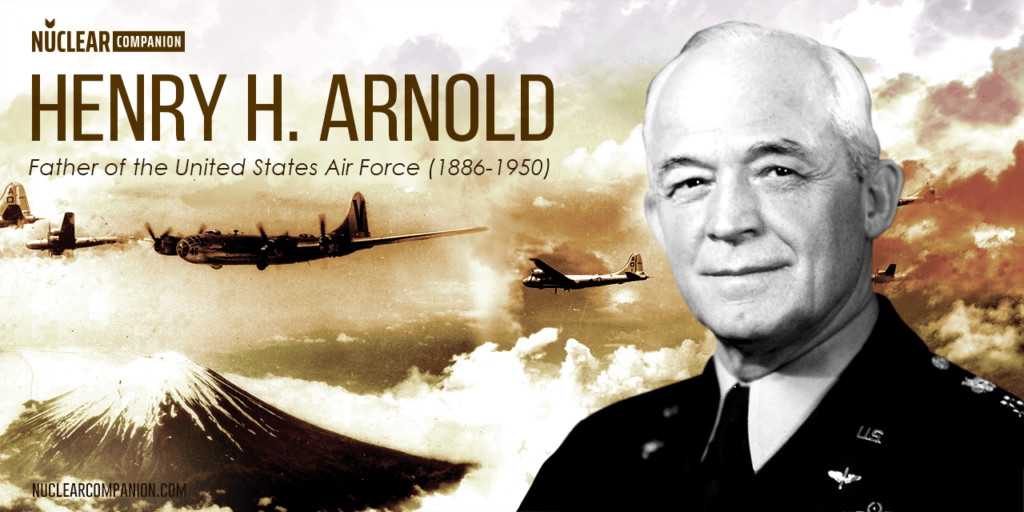
On that same day, General Arnold gave his support to Admiral King’s idea of 16 October. With this agreement, the Joint Chiefs of Staff directs its planners (Joint Staff Planners) to create a plan to present to the president. This plan should be an outline of the type of tests, requirements, and recommended the agency to implement the tests.
On 9 November the Joint Staff Planners turned over their work to a sub-committee of experts. This sub-committee chaired by Major General Curtis E. LeMay would show the first conflicts between the U.S. Navy and the Army Air Forces.
Sidenote. Members of the Joint Chiefs of Staff at the moment were: General H. H. Arnold, General G. C. Marshall, Admiral E. J. King, Admiral W.D. Leahy
LeMay Subcommittee
The “LeMay Subcommittee” was key in the planning phase of Operation Crossroads. It had the job to coordinate and decide on critical aspects of the scheduled tests, including whether or not target ships were to have fuel and ammo. Appointed by the Joint Chiefs’ Joint Planning Staff, it was also the subcommittee doing to chose those to be in command of the operation.
- Major General C. E. LeMay (Steering Member)
- Brigadier-General W. A. Borden
- Colonel C. H. Bonesteel
- Captain G. W. Anderson, Jr. (Navy)
- Captain V. L. Pottle (Navy)
- Commodore (later Rear Admiral) W. S. Parsons
In front of the subcommittee was Major General Curtis E. LeMay from the U.S. Air Force. Representing the U.S. Navy, on the other hand, was Commodore William S. “Deak” Parsons. He was the weaponeer inside aircraft Enola Gay when the nuclear drop on Hiroshima took place.
But aside from the technical aspects of the operation, Parsons also had the responsibility of defending the U.S. Navy’s interests. The committee became part of a sort of dispute between him and LeMay himself.
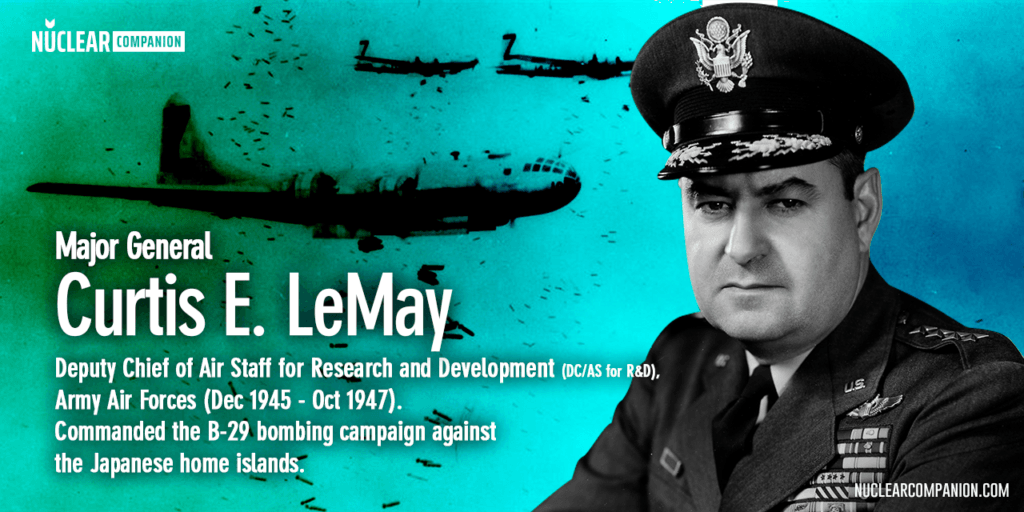
LeMay wanted the U.S. Air Force to have control as they were providing the only capable aircraft of delivering a nuclear bomb at that time. He even went to met with U.S. President Truman to express his concerns about the operation.
Parsons, for its part, argued that despite the U.S. Air Force’s relevant role, it was the U.S. Navy who held most of the operation’s assets. Not to mention it also had officers expert in the nuclear field.
Parsons wanted the U.S. Navy to have the last word on making the decisions for the test. In this sense, the U.S. Navy had the Navy Atomic Bomb Group, which would take care of the preliminary arranges for the operation.
In Dec., LeMay proposed General Groves, previously head of Manhattan Project, to be at the command of the operation. Joint Chiefs, nonetheless, were fond of having a Joint Task Force One commander from the U.S. Navy.
Joint Chiefs agreed on Parsons in that most of the assets and human resources for the operation were indeed from the U.S. Navy. As such, they chose, on Parsons’ recommendation, Vice Adm. William H. P. Blandy for the position.
But this wasn’t the end of the dispute. The U.S. Air Force wanted to be in charge of the preparation, deployment and subsequent scientific analysis of the nuclear bomb’s effects. In this last regard, they wanted the bomb to be tested on U.S. Air Force materials.
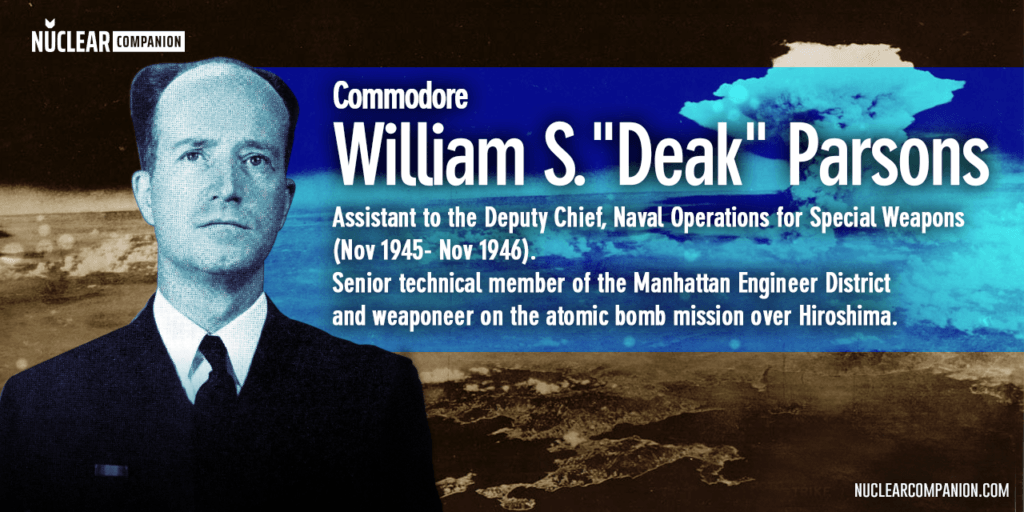
That very same month, the U.S. president recommended the Congress to unify the armed services as a way to make them more flexible. As cooperation became an obligation, the dispute was settled.
On Dec 22. the Joint Chiefs received the test outline from the Joint Planning Staff. There were going to be three tests, each at a different explosive plain:
- One would be dropped from a plane. This would have as target all sorts of navy boats, arranged to receive different grades of damage. In this way, the army could reliably measure the damage at different ranges and to kind of targets. They would be able to measure the damage from the explosion itself and its radioactive effect.
- Other detonated at ground level and the third and final detonated thousands of feet underwater. The second and third explosions, for their part, had as objective to show ships’s reaction to them. Mostly, to measure at what range did ships sank or became inoperable. To identify these damages, ships would be inspected trough divers, and later on, on a drydock.
Lastly, the committee requested Joint Chiefs to appoint a military evaluation board for the operation. It was integrated by members of the U.S. Army and U.S. Navy, as well as participants of the Manhattan Project and civilian scientists.
The Joint Chiefs of Staff approved the report on 28 December.
The outline of the testing was ready. It was time to execute it.
A Joint Task Force
On Dec. 29, 1945, President Truman appointed Vice-Admiral W.H.P. Blandy, USN, Commander of the Join task Force. This force would be in charge of executing the testing plan. Due to the importance of this operation, the Navy officer was to answer directly to the Joint Chiefs of Staff.
Alongside Blandy, two other names joined as well for advising him on technical subjects. One man from the U.S. Navy and another from the Air Force: Commodore William S. Parsons and Air Force Colonel Paul Tibbets Jr.
Preparations started immediately with namings for the main staff positions just a few days later. Brigadier General William E. Kepner joined first as Deputy Commander for Army and U.S. Navy Aviation. Brigadier General Thomas S. Power followed as Assistant Deputy Commander.
On Jan. 5, Blandy submitted his plan for the operation to the Joint Chiefs of Staff. This was but a week after his appointment and even before the operation itself had presidential approval.
In his plan, Blandy suggested the name “Joint Task Force One” for his operational force. Likewise, he proposed naming the operation “Crossroads”. The name corresponded to the operation’s transcendence as the first public nuclear weapon test.
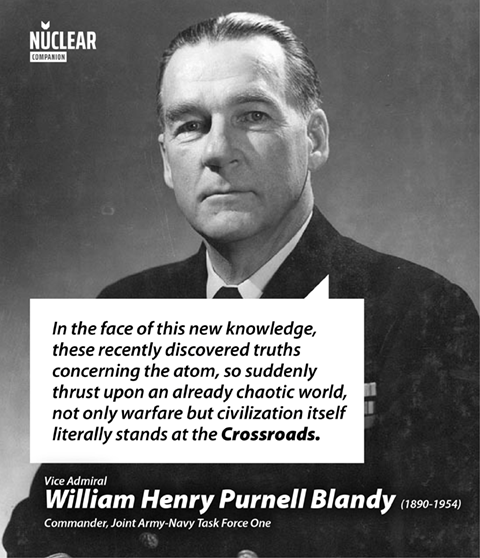
In choosing the dropping location, Blandy viewed the Marshall Islands as a sound choice. It was an isolated U.S. trust territory far from any considerably populated area that the bomb could compromise.
Within the Marshall Islands, Blandy studied Bikini Atoll as the ideal location for the explosions. For one thing, the local population was barely 200 people, so relocating couldn’t be an issue. However, this would prove to be more troublesome than initially considered.
Besides, Bikini atoll’s lagoon was perfect for harboring Joint Task Force 1’s ships. Not so much for aircraft landing, though. Still, close atolls Kwajalein and Eniwetok were large enough for fitting the B-29s and drone aircraft B-17s for the test.
Now that Blandy had his staff and place, it was time for him to get into the details of the two initial explosions.
Blandy alphabetically named the tests “Able” and “Baker”. The first one would be a dropping; the second, a detonation at ground level. There was also the possibility of a third one, named “Charlie”.
Blandy’s plan recommended a dropping altitude of 30,000 ft for Test Able. Falling from there, the bomb would explode 600 ft before reaching the ground.
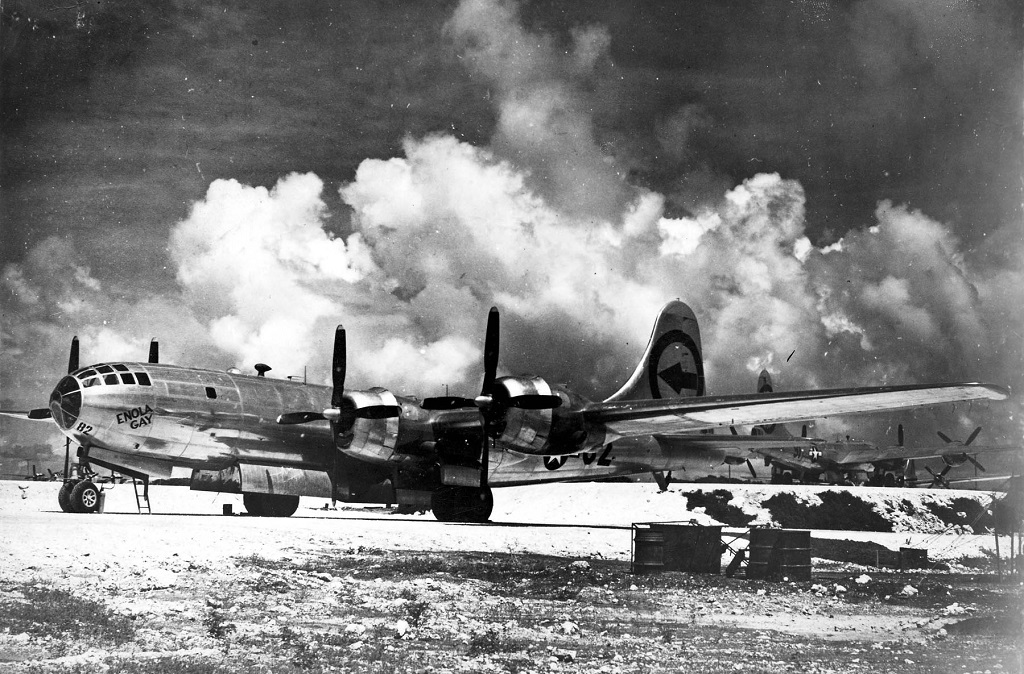
In this regard, some suggested using a balloon for greater precision in a mid-air explosion. An idea that fell through, given that the consensus was in favor of a B-29, invariably the first choice for the task.
For both planned tests, the target fleet would respect a radial formation around the detonation point.
On Test Able, an aircraft carrier would act as the target ship for the dropping. The carrier, for its part, would be surrounded by the other main, largest ships. The rest of the fleet would be mixed at different distances to test the effects of the bomb on each type of ship at different distances.
Moving to Test Baker, Blandy suggested attaching the bomb to a landing ship tank. This ship would act as the center of the target array. As for arraying the target fleet, Blandy had a few ideas.
- Anchoring them using a ground tackle;
- Using the atoll’s neighboring reef,
- To let them drift away while keeping them together with towlines. In this case, a bark could carry the bomb with the help of the wind.
Test Names
U.S. nuclear weapons tests were originally named in accordance with the international phonetic alphabet (most commonly used by U.S. military and federal agencies).
This practice eventually led to some confusion: there were four “Able” shots (in Operations CROSSROADS, RANGER, BUSTER-JANGLE, and TUMBLERSNAPPER), four “Baker” and one “Baker-2” shots (Operations CROSSROADS, RANGER, BUSTER-JANGLE, and TUMBLER-SNAPPER), two “Charlie” shots (Operations BUSTER-JANGLE and TUMBLER-SNAPPER; a “Charlie” shot planned for Operation CROSSROADS was canceled).
Starting in 1953, to avoid even more confusion in the future, shots were given unique names that were not based on the international phonetic alphabet.
For collecting explosions’ data, ships had close to 30,000 measuring devices. Much of them were modified or specifically designed for the test. Also, 6,000 test animals were to board different target ships.
The operation involved studying the effects of nuclear bombs on different materials as well. In this way, Blandy required the Army force to use Bikini’s coast and target ships’ decks for arranging their equipment and weapons. Still, aside from this matter, the Army didn’t play a large role in Crossroads.
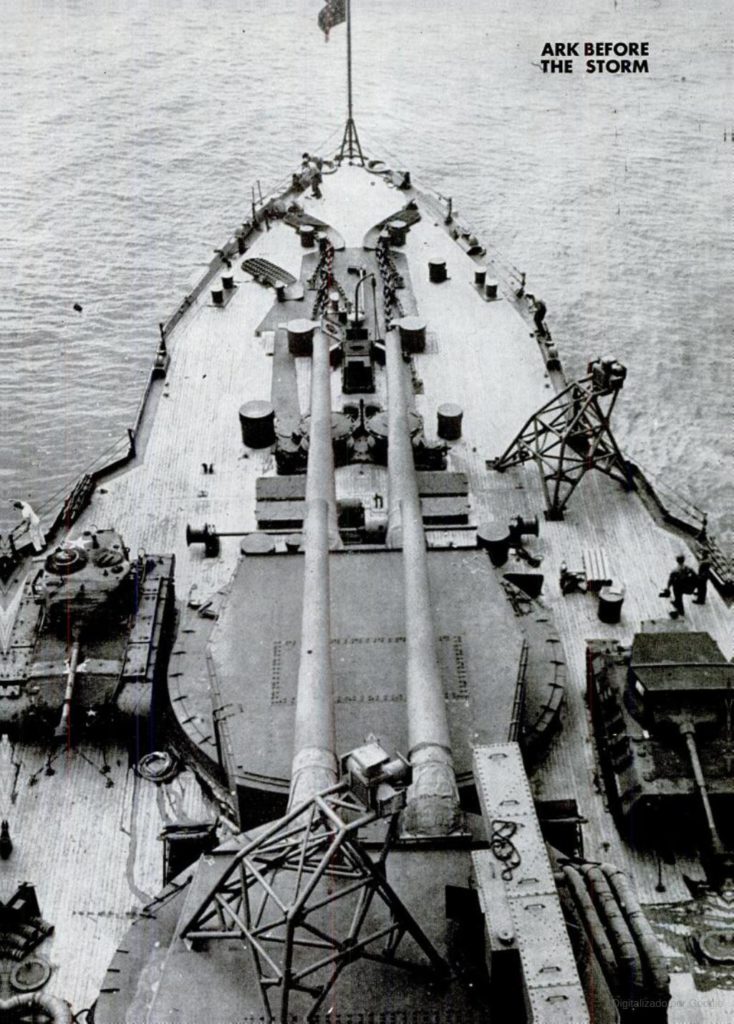
The Air Force and U.S. Navy, for their part, saw on Crossroads an opportunity for testing both their hardware and themselves.
Five days after Blandy presented his plan, President Truman confirmed Operation Crossroads. The next day, the Chiefs of Staff approved Blandy’s plan.
JTF-1 Organization
Blandy’s next step was to build his staff with scientists and members of the three US Army forces.
By Jan. 11, JTF-1 enjoyed its own headquarters inside the U.S. Navy’s main facilities in Washington, DC. Among the first to secure their spot in the force were Kepner and Parsons, who had helped Blandy in his plan. Kepner became Deputy Commander for Aviation; Parsons, Deputy Commander for Technical Direction.
Major General A. C. McAuliffe completed the main staff list. He became Deputy Commander for Ground Forces.
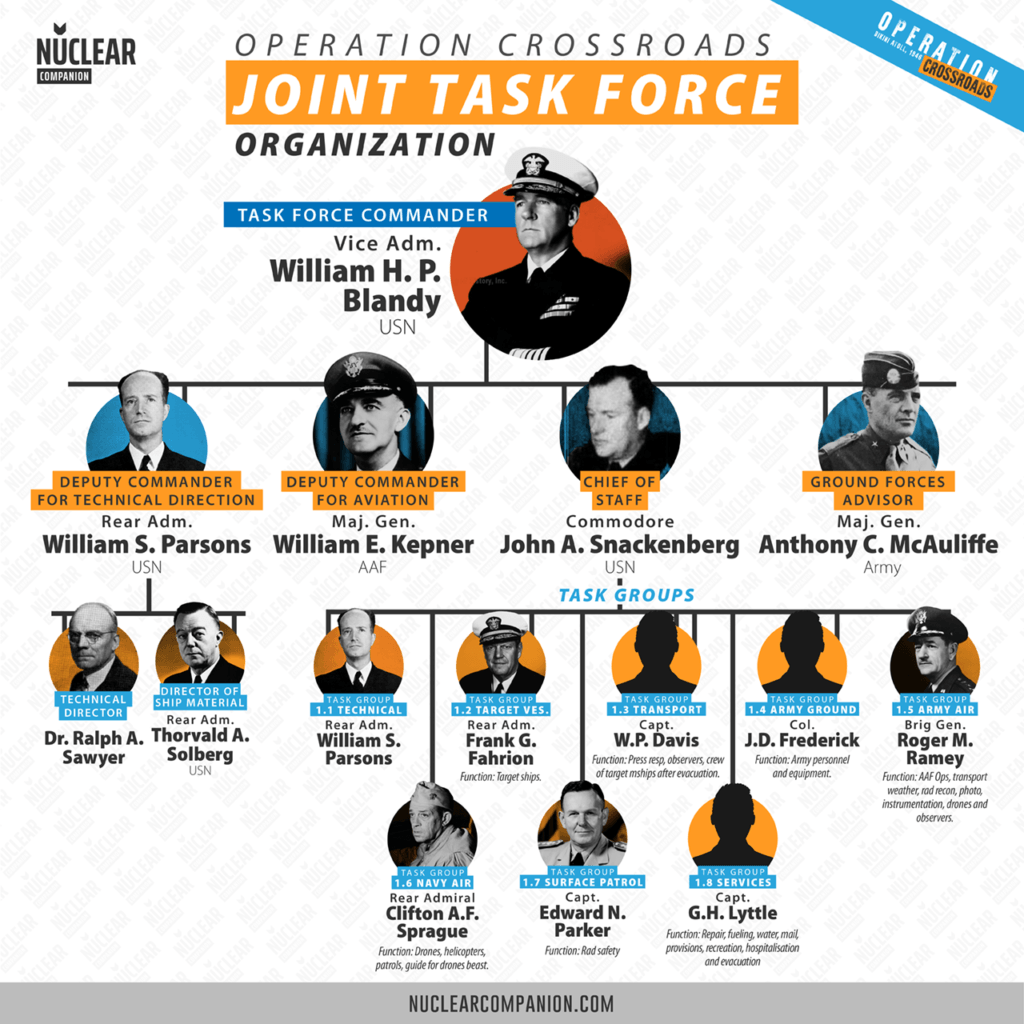
The Chief of Staff of the force was Commodore A. J. Snackenberg. He had four assistants chiefs of staff:
- U.S. Navy Captain Robert Brodie, Jr., Assistant Chief of Staff for Personnel.
- Army Brigadier General T. J. Betts, Assistant Chief of Staff for Intelligence.
- U.S. Navy Captain C. H. Lyraan, Assistant Chief of Staff for Operations
- Army Brigadier General D. H. Blakelock, Assistant Chief of Staff for Logistics.
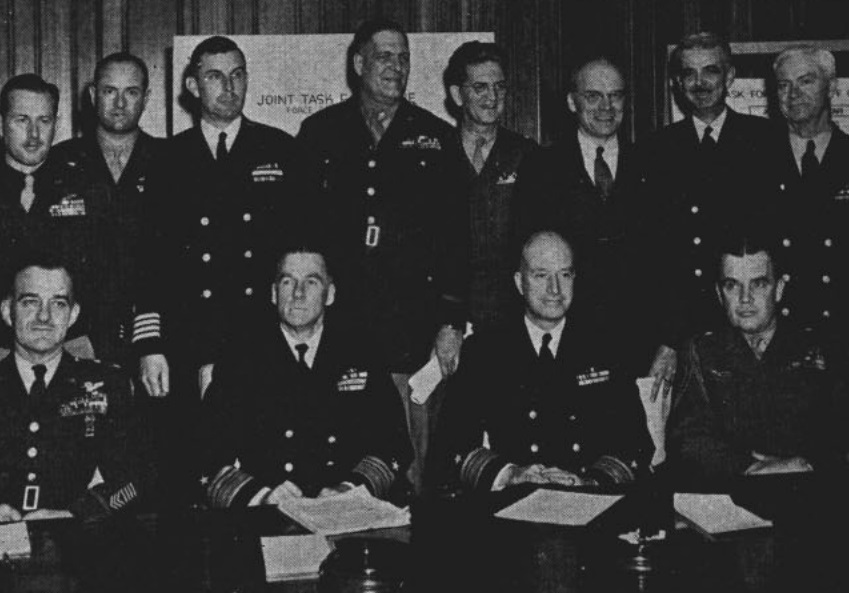
Joint Task Force 1 divided its deeds into eight groups, each with its own subgroups, accounting for a total of thirty-nine units. The eight main groups were Technical, Target Vessel, Transport, Army Ground, Army Air, Navy Air, Surface Patrol, and Service. Blandy and his three deputies had full control over these groups.
As Technical Director of the operation, Parsons incorporated U.S. Navy Roar Admiral T. A. Solderd and Technical Director Dr. R. A. Sawyer.
Sawyer chose a staff of seven assistants composed mostly of naval officers. He divided his office into nine groups, accounting for a total of thirty-two technical projects.
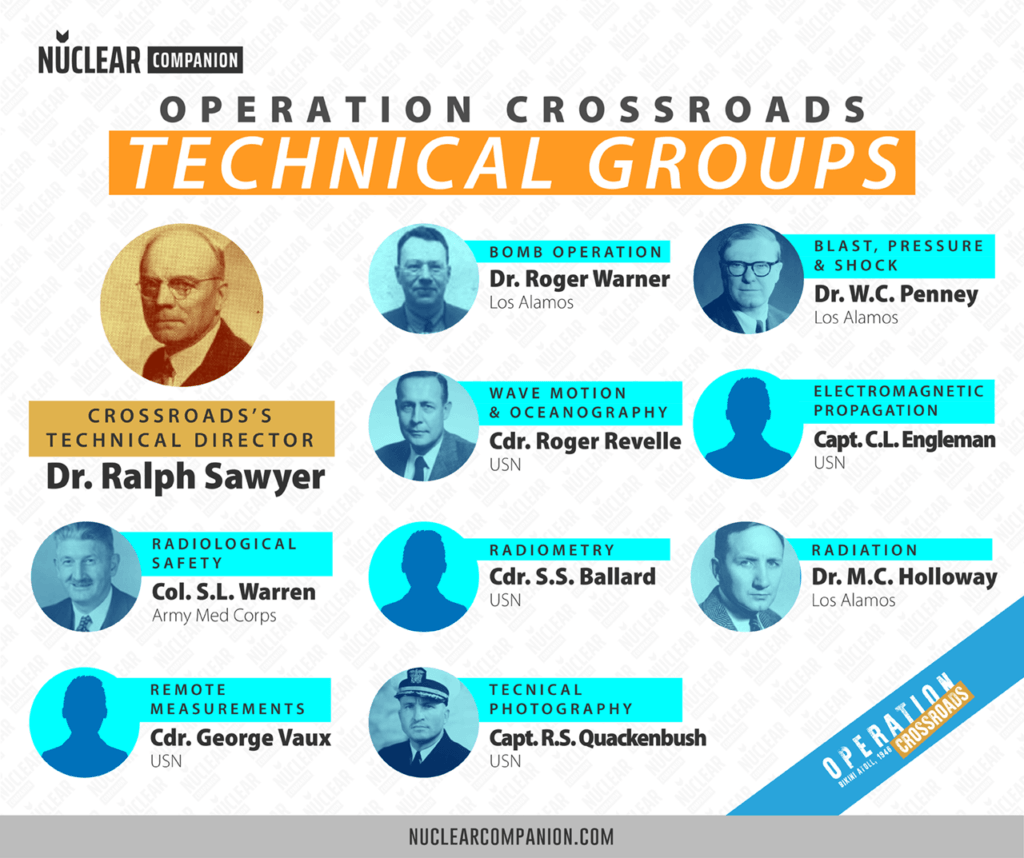
Considering the resources involved, Crossroads was the greatest scientific experiment at the time. In this sense, Joint Task Force 1 was responsible for the presence of 550 scientists in Bikini.
The Target Fleet
As preparations advanced, the target fleet arraying brought a lasting conflict between the U.S. Air Force and the U.S. Navy.
For the U.S. Navy, proper recording of the explosions required setting instruments inside the target ships. For this method to work, arraying would have to secure some of the ships and let them survive the tests.
The U.S. Air Force, for its part, considered that the whole fleet had to be within a thousand yards from ground zero. A greater distance would compromise the 30,000-ft dropping, as missing the central target was a possibility.
The discussion between parties didn’t take long for reaching a dead end. Forces went to mediation. The Military Advisory Board deliberated for two months throughout different plans and solutions.
On Feb. 21 Blandy presented a new array model, (the fourth) to a troubled U.S. Air Force. Of a total of ninety-three ships, twenty-three of them would be within 1,000 yards from ground zero. Under this configuration, not all ships would suffer identical damage.
LeMay recommended the U.S Air Force to go with this plan, which wasn’t the last cause of disagreement between these forces.
During this stage, the target ships’ fuel and ammunition levels arose different views as well. In preserving the ship’s instruments, the U.S. Navy wanted to maintain the levels of these goods at a minimum.
On the contrary, the U.S. Air Force asked for fully loaded vessels. They wanted to know the effects of the explosion on as many materials as possible. Eventually, not all ships were fully loaded with fuel and ammunition.
Additionally, the marking of the target ship was still to be resolved. It had to be striking enough for the bombardier crew to see it from 30,000 ft of altitude. Looking from there, the ship at the center of the fleet would be hard to spot in the middle of the ocean.
All agreed that the best solution was painting the ship, USS Nevada, orange with white spots, while also fixing a searchlight.
The Movement of the Task Force Headquarters to Forward Area
Blandy’s plan also acknowledged the public interest. He encouraged inviting civilians to watch the nuclear explosions from the U.S. Navy designated points.
Initially, the U.S. government granted 200 invitations for observing the tests from Task Force’s ships. Blandy, nonetheless, concluded that the ships they initially had for hosting them wouldn’t be enough. Neither especially comfortable.
At this point, Nimitz had the idea of employing three additional ships for hosting guests. These additional ships made space for double the visitors and congressmen.
A total of sixty congressmen were to see the test. Plus, four additional congressmen moved to Bikini to work at the Evaluation Board Crossroads.
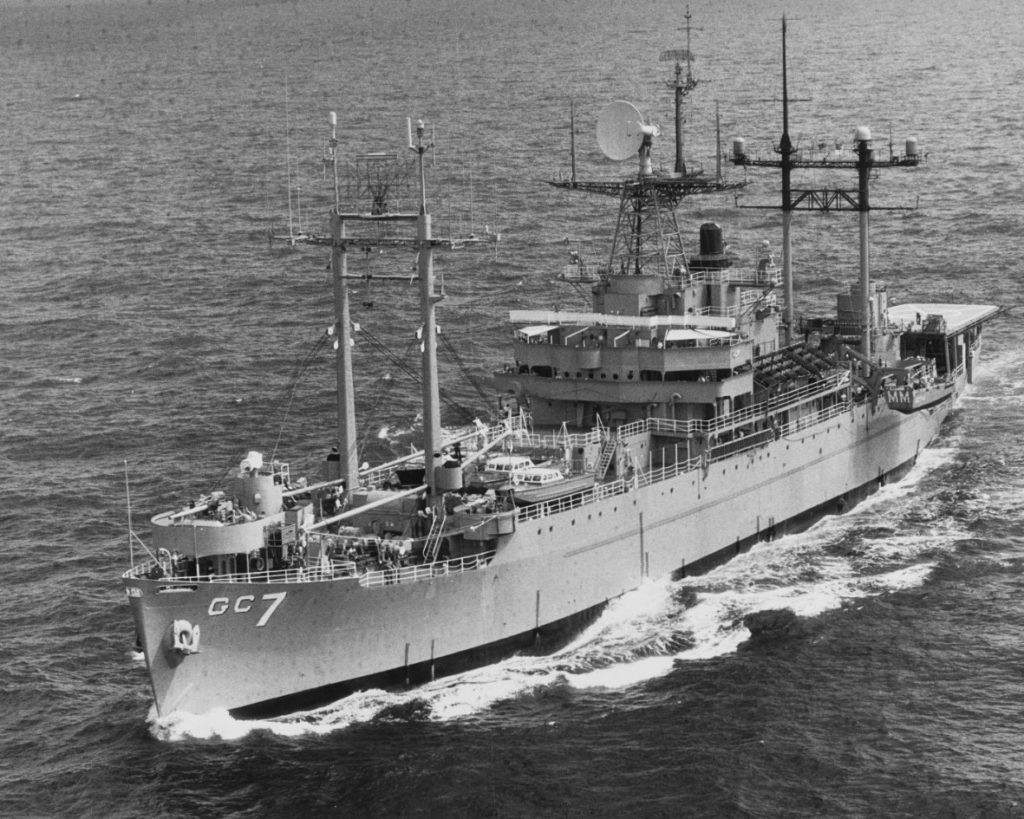
But so many congressmen moving from the mainland U.S. was surely going to affect the congress agenda. Especially, as Congressional elections were not far away.
At least that’s what Texas Speaker Sam Rayburn thought. He let the president know of his concerns, and a cabinet meeting took place on Mar. 22 for discussing the subject. Despite Blandy wanting to go with the schedule, the president agreed on delaying the test from May 15 to Jul. 1.
The news was ill-received by those involved in Crossroads. Joint Task Force 1, in the middle of their moving to the Pacific, had to wait until May to do so.
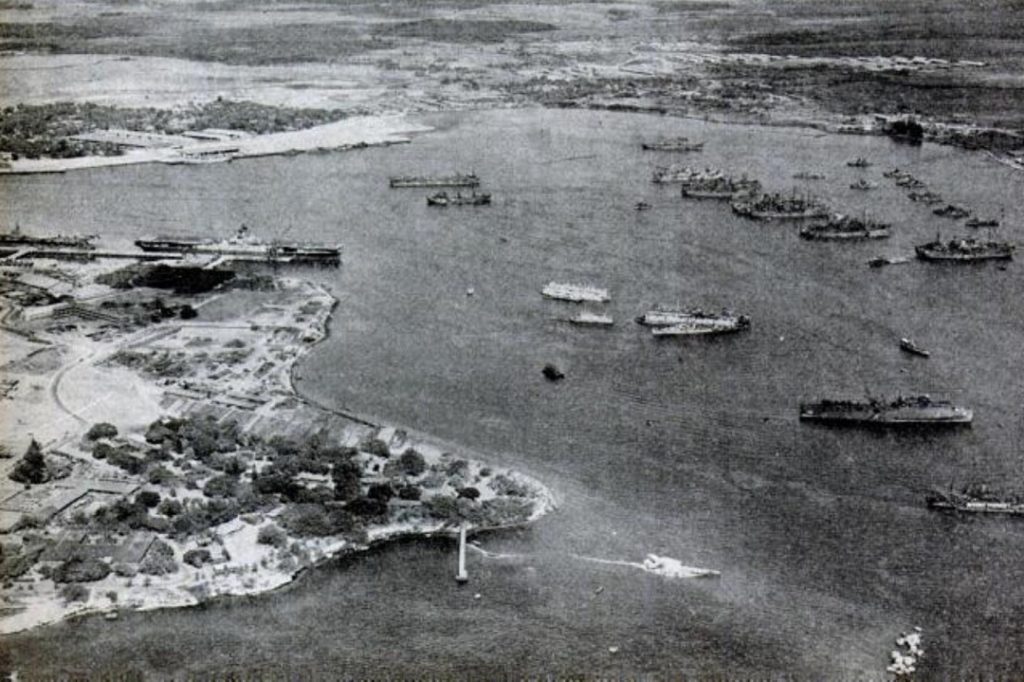
On May 8, JTF-1‘s staff boarded USS Mount McKinley, Blandy’s flagship, in San Francisco. Before reaching Bikini, the ship made a stop at Pearl Harbor the fourteen for officials to join. Among them were Blandy, Kepner, McAuliffe, and Parsons.
Shortly after boarding his ship, Blandy replaced the ships’ flag, then Snackenberg’s, for his own, assuming command of the Task Force.
The ship spent a whole week in Hawaii before departing. There, they made a proper check of all the equipment on the ship. They reached Bikini in Jun. 2. Able day was still a month away; yet, as we will see, they still had much work to do.
Vice Admiral William H. P. Blandy (1890-1954)
The face of Operation Crossroads was Vice Admiral William H. P. Blandy. Native from New York City, prior to Crossroads he had a long record on the U.S. Navy showing for his merit to achieve this position.
Blandy’s career started in Annapolis’ Naval Academy, where he was nicknamed “Spike” by his peers. During these days he excelled at fencing and graduated as Honor Man in 1913.
The very next year Blandy commenced his service in the U.S. Navy taking part in the occupation of Veracruz and in World War I subsequently. By 1935, Blandy was commander of Destroyer Division 10. In May next year, he made it into the Division of Fleet Training for the Chief of Naval Operations as Head of the Gunnery Section.
In Dec. 1938, Blandy became commander of the battleship USS Utah. By then, Utah was already retired from regular service and served as a radio-controlled target ship, used in many air bombing tests.
In 1941, Blandy was appointed chief of the Bureau of Naval Ordnance, an administrative position he kept until Dec. 1943. Shortly after, he joined the Pacific Fleet commanding Amphibious Task Group until Jul. 1945.
As a combat leader, Blandy was a very organized strategist. His first fighting operation was the Battle for Kwajalein (Jan. 19 to Feb. 6, 1944). During this time, he also participated in the capture of Peleliu and Angaur, as well as in the occupation of Ulithi Atoll.
Later on, Blandy became commander of the Amphibious Support Force. For his participation in the assaults of Iwo Jima, Okinawa Gunto, and Nansei Shoto the U.S. Navy awarded him Gold Stars. He also fought in the Kerama Islands, near Japan‘s main islands.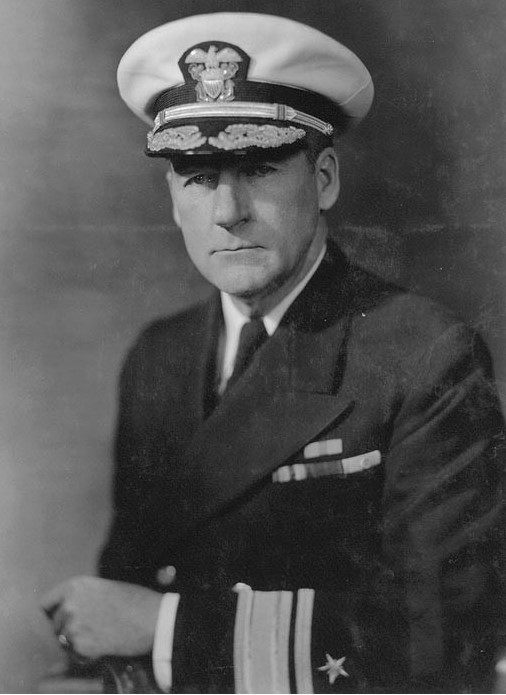
By July 1945, Blandy was in command of all cruisers and destroyers on the Pacific. Following that year, he became Deputy Chief of Naval Operations (Special Weapons).
Throughout his career, Blandy served on different U.S. Navy fields both on land and sea. It was thanks to his experience in naval ordnance and construction, though, that he was appointed for Operation Crossroads. After the operation finished, Blandy was promoted to Commander in Chief of the Atlantic Fleet(CINCLANTFLT).
Bikini: Land of Coconuts
The Testing site
Let’s take a look now at where the tests took place and how the U.S. Navy chose this location.
The Trinity test, the first nuclear test, and the only one before the Japan droppings took place on U.S. soil (New Mexico). However, now that the war was over the authorities could become pickier on where to perform their new testings.
In this sense, the U.S. Navy started to look at other factors like the weather. The wind had to be predictable for avoiding a potential nuclear deviation.
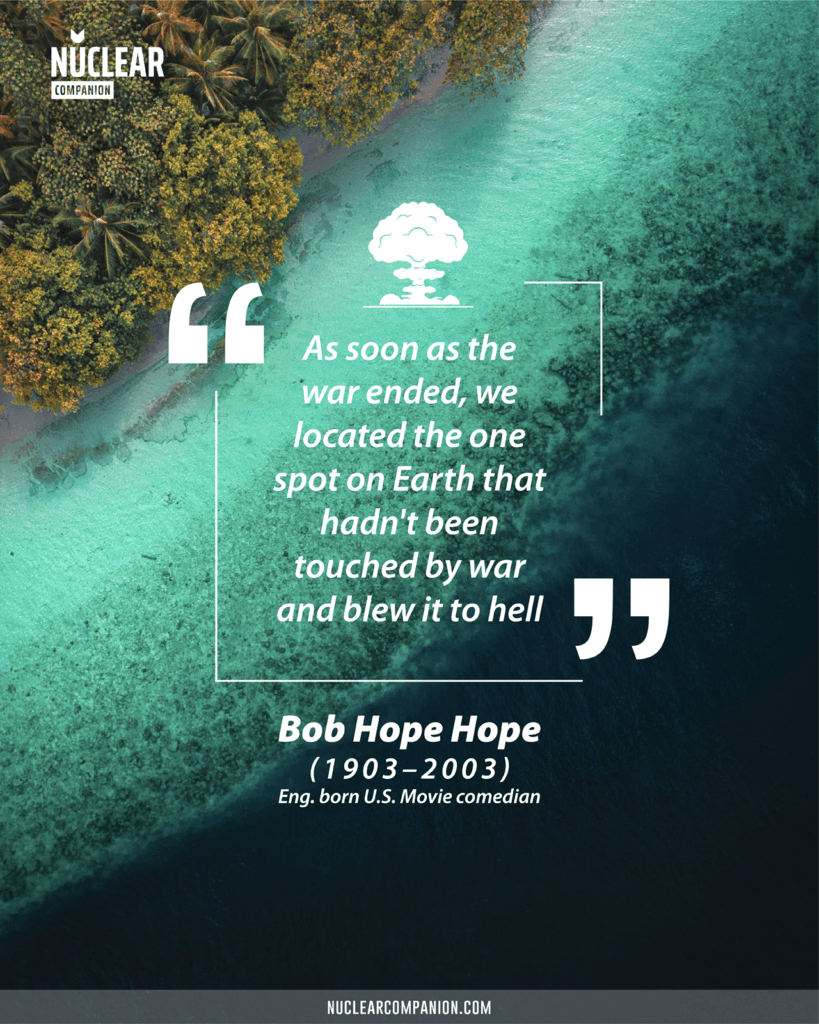
At the same time, the place had to be isolated enough to not provoke a fallout on continental U.S. territory. Also, stormy sites were to be avoided for personnel to work properly.
This reduced the possible places greatly. Not to mention that B-29s, the only aircraft capable of delivering the bomb, could only work under 1,000 miles from one of their bases. In this way, the Pacific was where the U.S. Navy looked for the ideal scenario.
For their part, Pacific atolls, ring-shaped coral islands formed by the erosion of former volcanoes, were ideal. In their inner lakes, the U.S. Navy could gather and anchor the target ships before the tests. It had to be not merely a Pacific atoll but one part of US territory.
Lastly, the location could not have more than a small local population who could be moved away without much trouble.
With all these factors taken into account, Admiral Blandy announced the election of Bikini Atoll for the tests in Jan. 1946. Far from Hawaii and any Asian big city, Bikini Atoll was the ideal place.
Located in the Marshall Islands, it had merely 167 inhabitants at the time. As such, moving them to another close atoll wouldn’t be a problem, at least logistically speaking.
A little history
But how did these islands came to the U.S.’ hands?
The Marshall Islands had more than one abroad ruler, starting with Spain, and later on, Germany. At the beginning of World War I, Germany lost possession of them to Japan, who kept them de iure since 1919 and until the end of World War II.
Japan kept a trade route and development of the islands until the thirties. In that decade, the Japanese began to adopt a fortifying policy closing the islands to the exterior world.
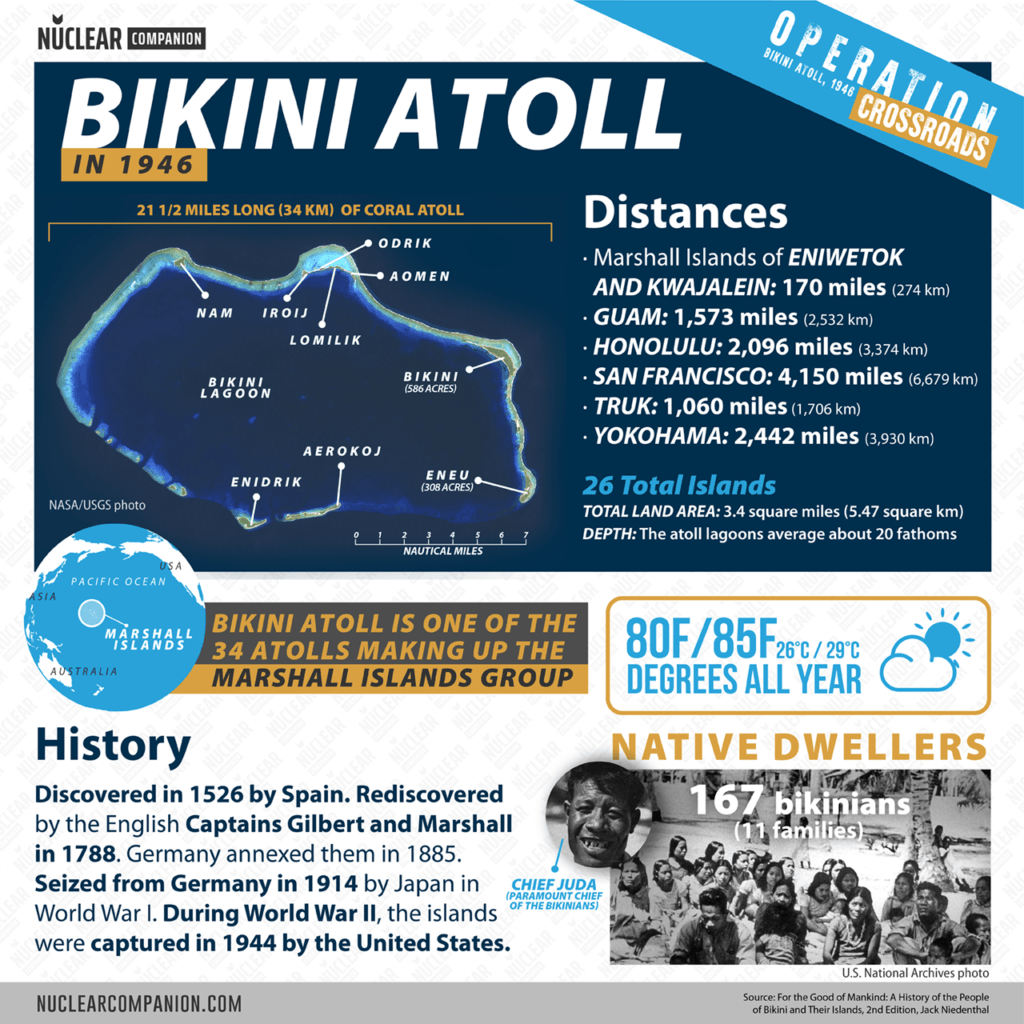
World War II saw locals became laborers helping in the Pacific defense against the US by turning Bikini into an outpost until the end of the war. Bikini atoll, then, alongside the rest of the Marshall Islands, passed to US hands. The US rapidly took care of the local population with supplies, public services buildings, and a new form of communal government.
As such, Bikinians had they overlord country in high regard, at least enough for consider it their Irioj Alap, that is, their highest chief. The trust was mutual, and the U.S. Navy was surprised by the fact that they didn’t even have a figure for murder punishment as there were not such.
Bikini’s name
Bikini´s name origins from the time it was part of German New Guinea. The german word Bikini derives from the native name “Pikinni”. Pik means “surface” and ni means “coconut”. This “land of coconuts” refers to the huge groves of trees visible on the horizon as one approaches the atoll.
Meet the Bikinians
But who were these people?
The small Bikini population was led by the twelve heads of the main families, directed as well for a general ruler.
At the time of Operation Crossroads, such position was held by a dark-skinned, muscular middle-aged man called Juda. Juda, of bad teeth and short height, rightfully held this position as male heir of the first conqueror of Bikini named Larkeloft.
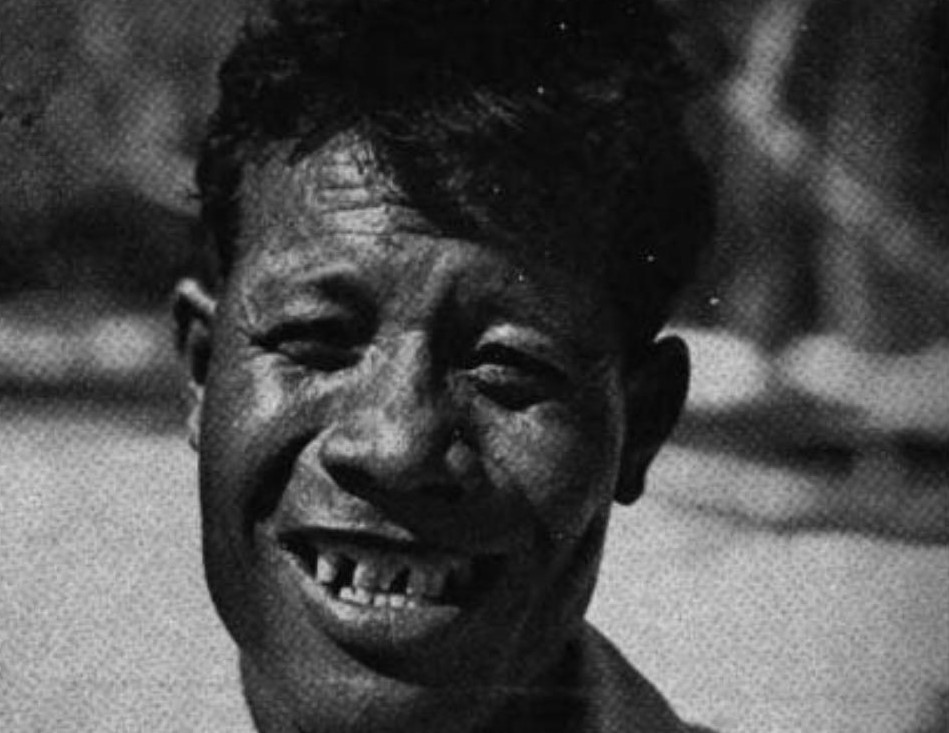
On the other hand, Bikinians were Protestants. In the 19th century, they were visited by New England missionaries resulting in natives turning into their religion.
They were not Catholics despite the Spanish reached the islands first in the 16th century. Strange enough, Catholicism, was the faith kept in the Caroline Islands, despite being reached first by the British.
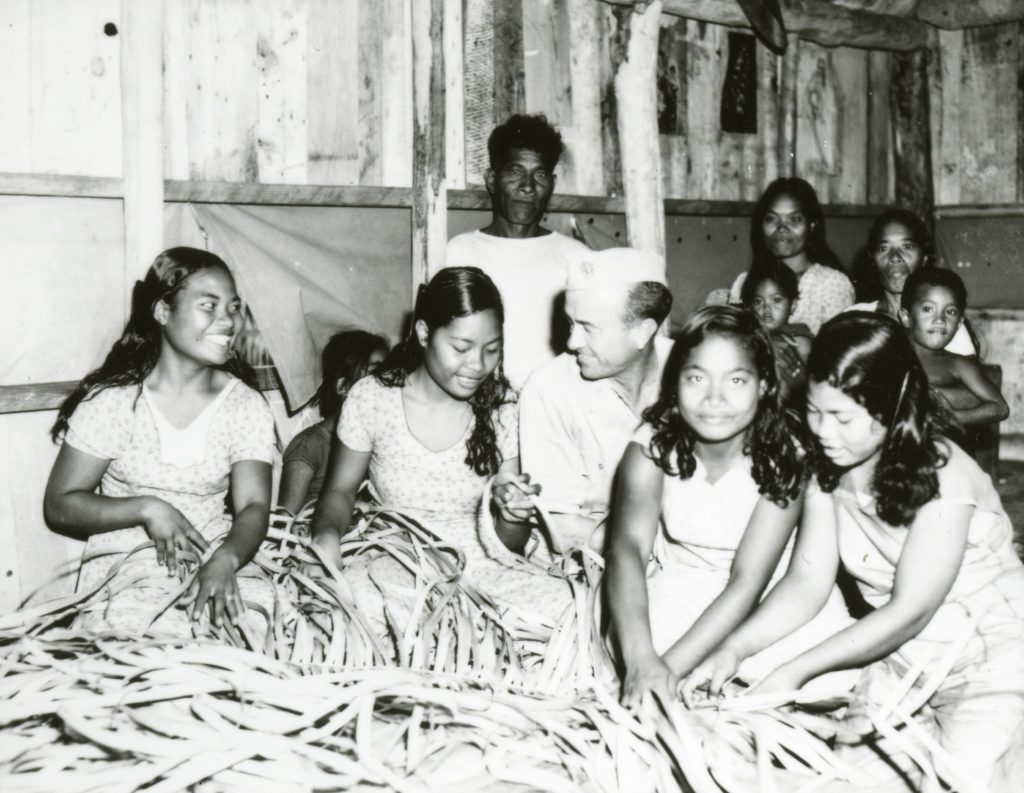
Bikinians had education in high regard, and children were taught both Marshallese and English.
In the name of God
Shortly after Blandy confirmed Bikini to be the place for the tests, on Feb. 10 its inhabitants were formally requested to leave their homes.
Making the request was the job of Commodore Ben Wyatt, the deputy military governor of the Marshalls. Along with him came a set of photographers, film crews, and journalists.
Wyatt invited locals to form a semicircle around him. Possibly drawing upon that Sunday church service has just ended, Wyatt‘s speech didn’t lack a religious tone. Religion was certainly what they had most in common. Wyatt quoted the bible, a book locals were fond of, and the Jewish exodus as parallelism of their current situation.
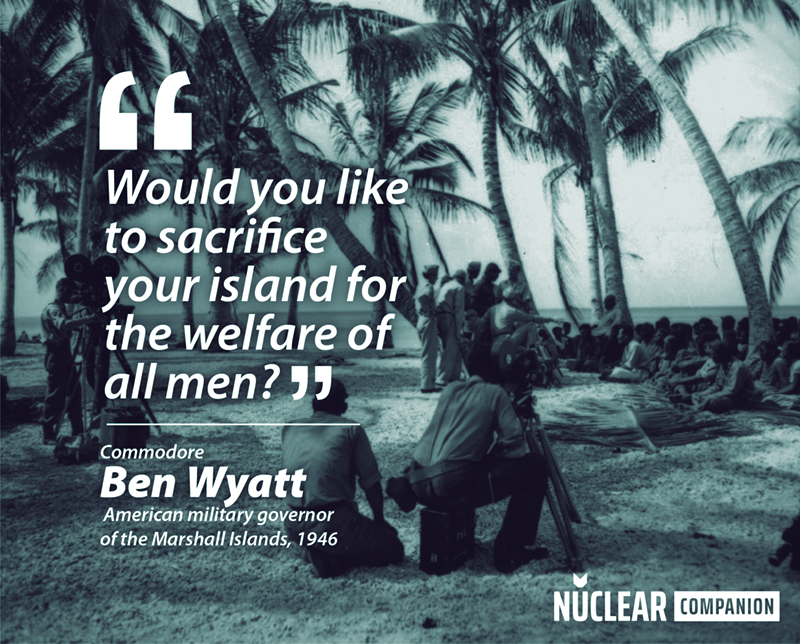
Wyatt would later refer to the speech as a “tough job”, as he wanted to avoid the scenario in which even only one of them would be against moving.
Wyatt explained to them not about what the tests would be about. Instead, he gave a meta image of atomic energy and its possibilities to help humanity. He told locals that they were to play a role in this development by leaving their houses and moving to another island.
After discussing the proposal, the twelve leaders came to the conclusion that if it was for a greater good they couldn’t reject moving. Wyatt‘s speech was successful.
Bikinians had not moved yet and ships, aircraft, and personnel for the operation began traveling to the islands. Along with them came the media, wanting to capture the process. Wyatt even had to repeat his speech for the camera.
Natives, for their part, were also part of their show. They decorated the islands’ community center and made a ceremony to honor their ancestors which they had to repeat for the cameras as well.
Likewise, natives held the church service three times for better images. All these media requirements delayed the natives’ departure a whole day.
The journey to Rongerik Atoll
But where did they go? Chiefs decided by vote to move their people and belongings to at the time inhabited Rongerik atoll. With the help of the tank landing ship USS LST-1108, they also carried with them their outrigger canoes and houses.
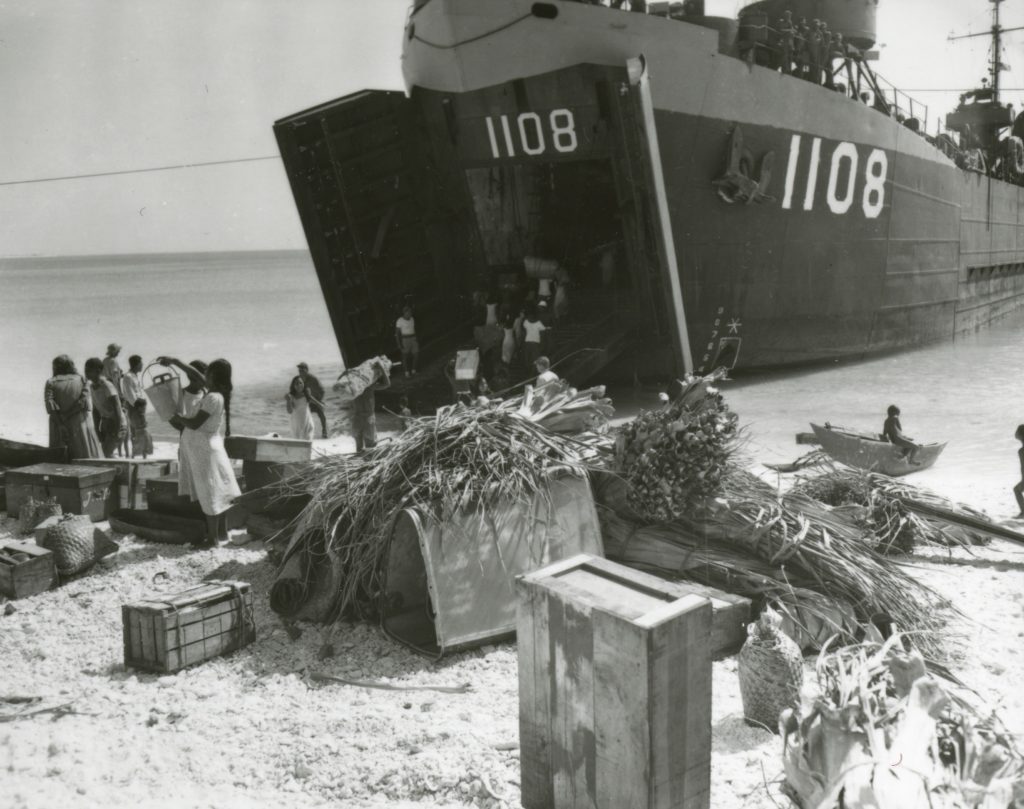
There was the promise of returning but without a specific date for doing so. Bikinians moved as fast as the next month, Mar. 7, in order for the tests to have placed on the planned time.
The US government took care of constructing the public and private buildings for the new island. Wyatt’s chief of staff, Harold Grieve, also a civilian architect, designed the new village.
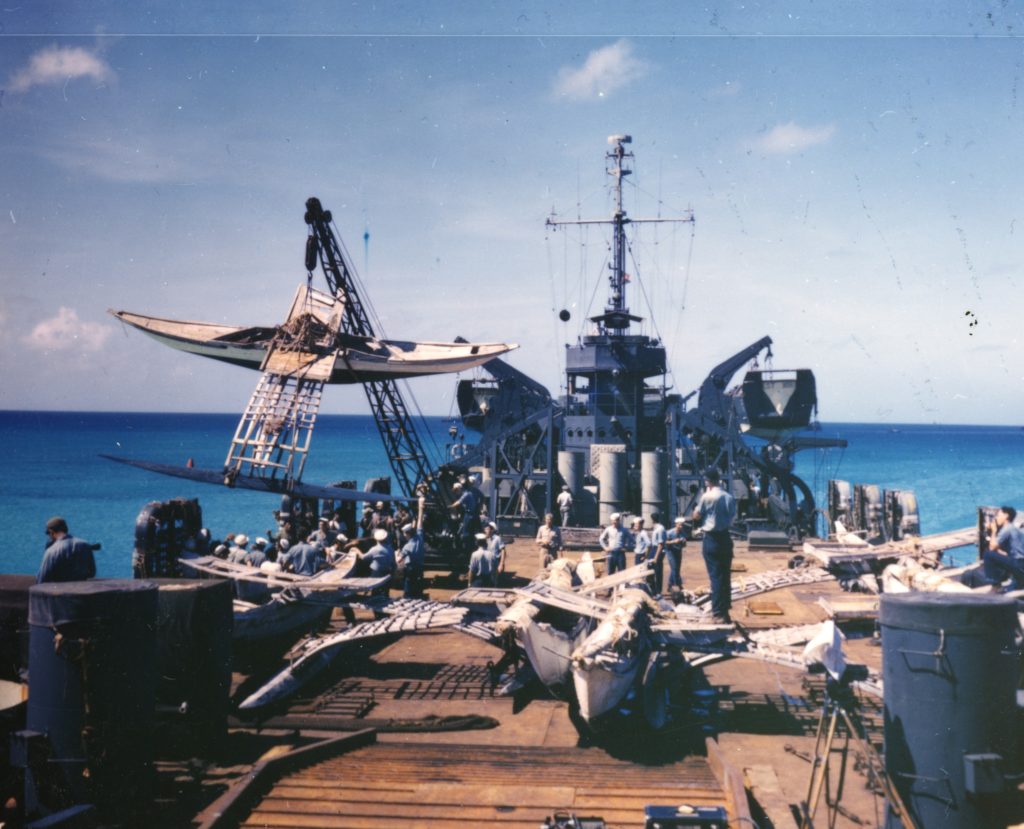
According to Grieve, these new islands were above Bikini‘s in terms of food natural sources. Plus, natives received two months’ worth of food and water supplies; enough time for Bikinians to develop their own stocks.
But Grieve’s prevision could not be further from the truth. Despite having chosen Rongerik as their new temporary home, among Marshallese existed the legend of this atoll as the home of demonic spirits. And while we cannot assure a supernatural power had any real influence, natives live there ended up being far from decent.
To begin with, Rongerik’s 17 islands felt short when compared to Bikini’s 36: a total of just 0.63 square miles against 2.3. Less soil meant fewer resources. And while agriculture was not viable, fish were naturally poisonous.
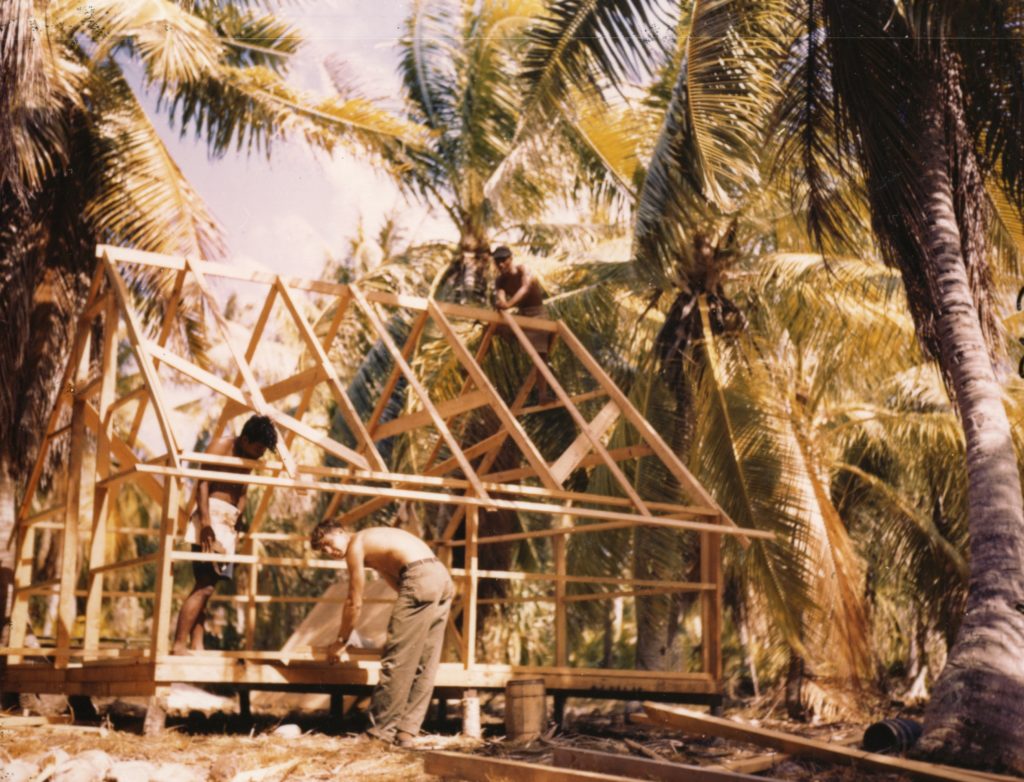
The press, on the other hand, kept the image on the matter of a new paradise destiny for them. From their perspective, they were in the first place pleased with contributing to end worlds’ wars, and that was that for them.
US Officials promised their deportation would be temporary and they soon started asking to return home. Unfortunately, most of them would not see their home again.
We will detail the bikinians‘s exile and hardships later in this article.
The Bomb
Now it’s time to focus on the bomb.
The bombs dropped during Crossroads were not expressly designed for the test.
They were two of the nine implosion-type nuclear bombs the US had in stock in 1946. At Los Alamos, the MK III and MK IV stood out as the favored bombs for featuring in the operation.
The 21-kt yield bomb used at Nagasaki was an MK III, as well as Trinity Site‘s. Meanwhile, as its name suggests, MK IV was the successor of the MK III.
At the time, the MK IV had yet to be tested. Thereby, using it at Crossroads was necessary for this weapon development. Lab experts, nonetheless, were more inclined to use the MK III bombs.
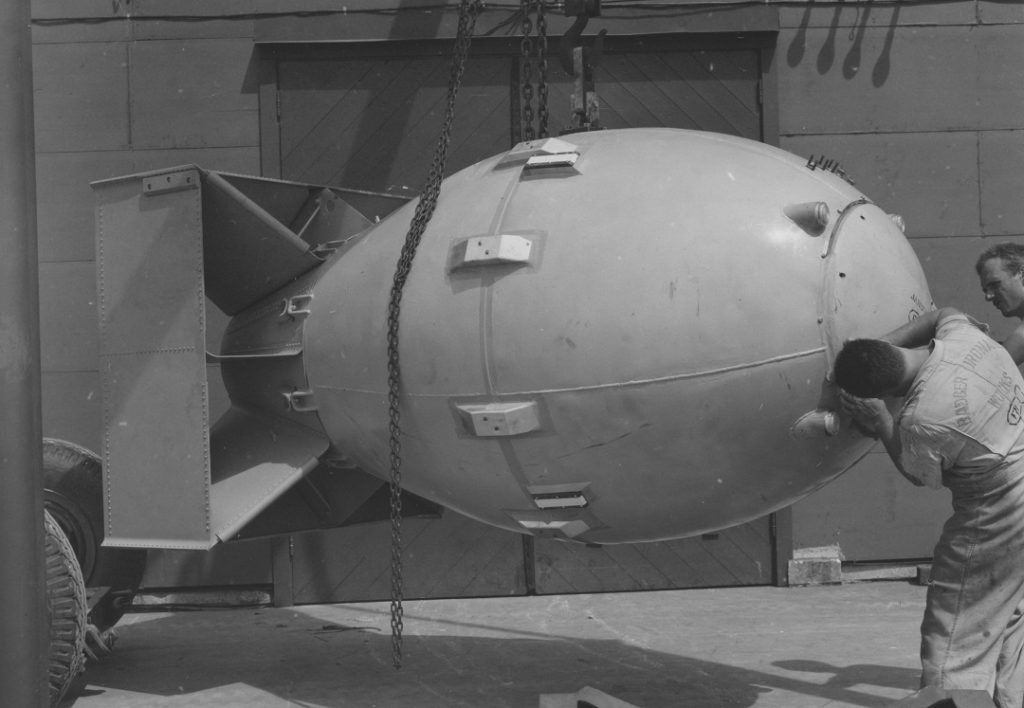
They had a number of reasons for backing up their decision. Firstly, the MK III bomb had not been tested enough times. Testing it again would provide great feedback for comparing its different recorded explosions. Coming up with an expectable range of power and new data from various scenarios was extremely valuable.
Another point for choosing the MK III was that the test was not about testing a type of nuclear bomb but nuclear weapons themselves. Then, a more reliable device would be more apt for such a task.
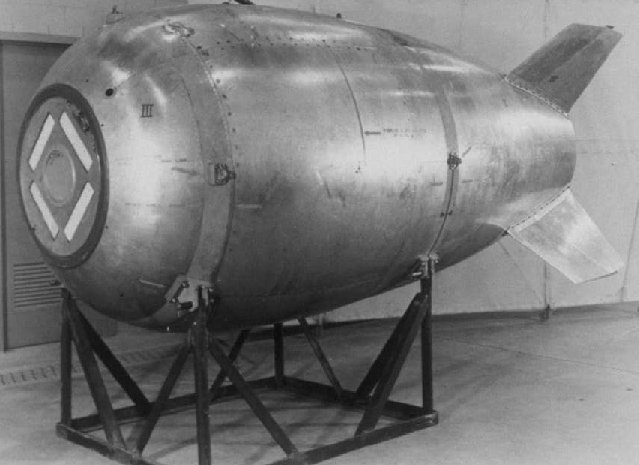
Lastly, common sense granted that a newer and untried bomb wasn’t the best option. In case of not working properly, anything going wrong would detonate negative views on public opinion.
Crossroads was the first public exhibition of nuclear weapons. In this sense, it was perceived as possibly the greatest military test in terms of catching the civil interest.
Gilda & Helen of Bikini
Scientists and engineers christianized the ABLE shot’s bomb as “Gilda”. This was Rita Hayworth’s latest movie and according to the Scientists it “kept us awake nights”. Three painters painted the words “Gilda” and a reproduction of a photo of Hayworth wearing a low-necked black evening gown. When asked about it, Rita Hayworth felt so honored that she said: “that I still haven’t come down to earth”.
Baker’s Bomb bore the nickname of Helen of Bikini, in a subtle allusion to the Trojan war and to that explosive mixture of seduction and destruction that patriarchy attributes to women as a great privilege.
As such, MK III Fat Man finally made it to the test. MK IV had to wait for its turn. At least that was the message.
MK IV‘s development had worse problems than not taking part in Crossroads, nonetheless. The team in charge of developing the MK IV was known as Z Division, divided between Los Alamos and Albuquerque. But with Crossroads, its most prominent members from both locations were transferred to the nuclear tests’ teams.
The Fatman Mark III
The bombs at Crossroads were two MK III Fat Man.
These were 12 ft long, 60 inches diameter bombs. Of their weight of around 10,800 lb, only 6.2 kg was plutonium. Through ignition, this plutonium rapidly compressed and imploded reaching supercritical mass.
Now, despite making it to the test, the design of the MK III had its flaws. It didn’t fly well, being aerodynamically unstable at reaching its terminal velocity (.9 to .95 Mach). In this case, the bomb wavered, losing landing precision.
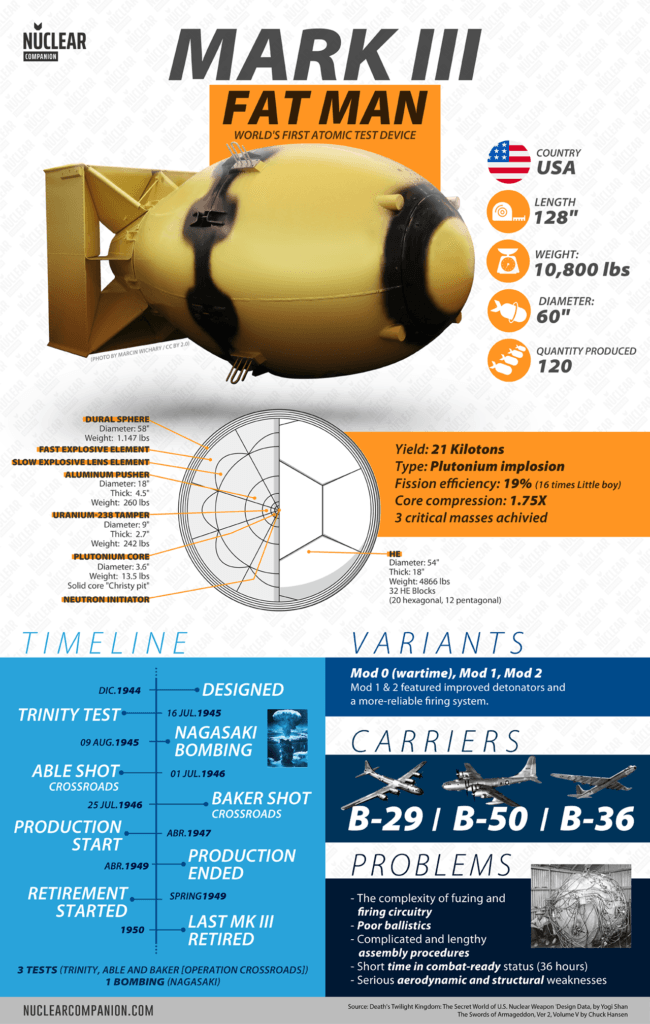
The improvised solution, as it was the case for the one used in the warn was a set of drag plates added to its tail box. These in most cases succeeded in slowing down the weapon to a controllable speed.
At the same time, these bombs were handmade, taking a full crew of 39 engineers two days for assembling each one. After that, the bomb had to be used within 48 hours, or else the batteries of the bomb’s fuses had to be changed.
Los Alamos participation
Los Alamos National Laboratory received notice of its participation in Crossroads in Dec. 1945. The institution was expected to provide nuclear devices and technical support for the test.
Given the role Los Alamos played in nuclear weapons development, it was without a doubt the most competent office for the job. By calculating the possible outcomes of the Operation’s explosions, the Laboratory was to aid the U.S. Navy in preparing the test. Likewise, its technicians were trusted with preparing and assembling the bombs.
By Jan. 1946, Los Alamos and the U.S. Navy finished outlining the operation details. During their meetings, Los Alamos chose Dr. Ralph A. Sawyer for the position of Technical Director of Crossroads.
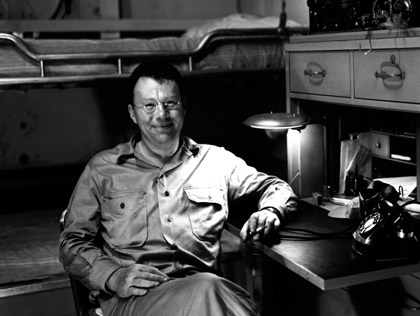
Alongside Sawyer, another two important names from the laboratory went to Bikini: Dr. Marshall Holloway and Mr. Roger Warner.
Holloway, from the B-Division, was head of Los Alamos experimental groups. The U.S. Navy conditioned craft USS Cumberland Sound (AV-17) as his team’s laboratory.
The experimental group, under Dr. Marshall Holloway (B-Division), had the following responsibilities:
- overall recommendations;
- to prepare an account of expected phenomena;
- to estimate the equivalent high explosive yield.
- provide instrumentation and make measurements of bomb performance.
Warner, for his part, part of Z-Division, was in charge of the weapons preparations groups. His ship was USS Albemarle (AV-5), modified for bomb assembly groups to work properly.
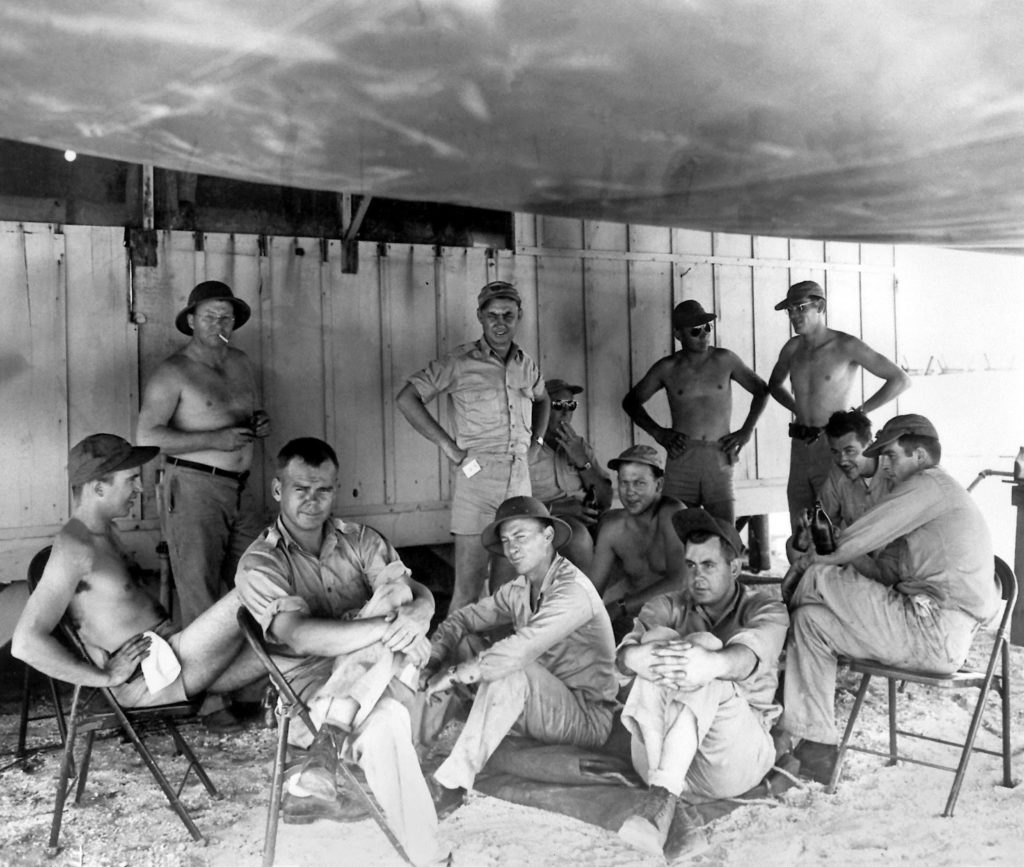
On the other hand, the weapon assembly group under Mr. Roger Warner (Z-Division) was in charge of:
- to prepare the firing circuits for the underwater test as well as timing system;
- to prepare and provide the atomic devices.
Los Alamos also provided medicals teams to Crossroads under the supervision of James F. Nolan and Louis H. Hempelmann. Both doctors’ teams were to examine the effects of radiation on test animals.
During the course of the operation, a C-54 connected Los Alamos’ headquarters in Santa Fe with Washington, D. C. In this way, techs at both offices were able to maintain proper communication.
In terms of nuclear weapons, Los Alamos offered a few models the Joint Taskforce could choose from. As we saw earlier, for practical reasons nuclear experts agreed on using the same type of bomb dropped at Nagasaki.
Participation in Crossroads cost Los Alamos one million dollars from its own budget. Still, its greatest sacrifice was human resources. One-eighth of Los Alamos staff, 150 technicians, dedicated entirely to the operation.
In this way, until Crossroads was over the laboratory remained short of employees for its other projects. Z division, key in nuclear weapons design, lost many of its most competent members to Crossroads, delaying the development of bomb Mark 4.
This was also the case of nuclear weapons composite cores. Such technology would only be tested in 1948 during Operation Sandstone, alongside levitated pits. Ironically, Sandstone would also require the help of the Z division, halting Mark 4’s development once again.
Target Ships
One of the most interesting points of the test was the target ships’ selection itself.
We can imagine that such selection was not, by any means, left to chance. It was, indeed, related to the objective of the experiment.
In knowing how would U.S. Navy assets stand against nuclear attacks, targets were not simply expendable and old ships. Rather, the US military chose the vessels that represented most of what the U.S. Navy had to offer.
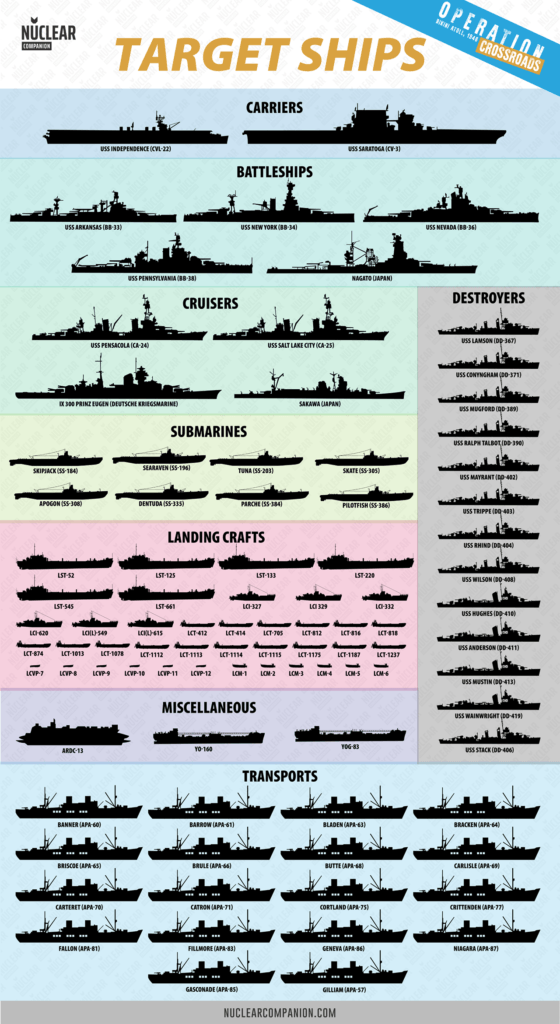
At the same time, with the end of the war came the time for the US army to decommission several war assets. In this case, warships. As a consequence, many of the very ships that served as targets had a military history and renown of their own.
In total, almost a hundred US vessels were part of the test. The test ship’s final list, featuring three last-minute submarines, appeared on Jan. 24th:
- 2 aircraft carriers
- 4 battleships
- 2 heavy cruisers
- 16 destroyers
- 8 submarines
- 15 transport ships
Apart from testing their naval war top potential, the US wanted to expose to the nuclear explosion to a wide range of vessel types as well. In this sense, adding to the main selected crafts were a total of 47 different boats of all sorts, including landing and patrol ships.
Battleships
Among these ships, the most iconic ones were the four battleships.
26,100-tons USS Arkansas (BB-33) or “Arky” was by then U.S. Navy’s oldest ship. As such, it had seen action in the two world wars, participating in allied campaigns on Africa and north and south of France.
Similarly, USS New York (BB-34) had a long history of naval conflicts, participating in both world wars as well. This 27,000-ton battleship fought its toughest battle on Okinawa, where it kept shooting during 76 of the 82 days the attack lasted. Despite its constant presence on the battlefield, New York survived the war suffering no severe damage.
There were also two ships that were taken down on Pearl Harbor. They were 31,000-tons USS Pennsylvania (BB-38), part of 13 amphibious landings, and 29,000-tons USS Nevada (BB-36).
Nevada was possibly the most transcendent of these battleships. 30 years old at the time of the test, it was the first US oil-burning dreadnaught. It was also the first one to feature a three-gun turret.
Having survived Pearl Harbor, Nevada saw action on Normandy and later on in the Pacific. In Pearl Harbor, it was the sole battleship able to maneuver, which allowed it to survive the intense Japanese attack.
Honoring its fame, Nevada was the bullseye of the first test bombing. As such, it was painted in a bright reddish-orange combination.
Carriers
Regarding carriers, 33,000-tons USS Saratoga (CV-3) or “Sara” had made a name of its own by having been allegedly sunk a total of seven times by the Japanese. In its numerous fights in the Pacific, it endured a fire in Okinawa like no other surviving ship. After participating in attacks on Tokyo and Iwo Jima, a kamikaze attack in Feb. 1945. made Saratoga finally unfit for battle.
On the other hand, the other carrier, USS Independence (CVL-22), was among the youngest ships included in the test. Finished in 1943, this 11,000-tons ship acted as a fighter carrier in night missions.
Like Saratoga, Independence was used at the end of the war to bring US soldiers back home in the so-called Operation Magic Carpet.
Cruisers
The target heavy cruisers were USS Pensacola (CA-24) and USS Salt Lake City (CA-25). They were the oldest in the U.S. Navy, and both of them had seen action in the Pacific at that time.
Remarkably, Salt Lake participated, during its 17 battles in the Pacific, in the sink of fifteen ships and the damaging of another ten. For this reason, it became known as the “one-ship fleet”, plus after helping USS Boise to escape from Cape Esperance in Oct. 1942.
Destroyers
Target destroyers’ were similar inbuilt, as their weight ranged from 1,450 to 1,570 tons.
USS Ralph Talbot (DD-390) had on its achievements fourteen stars for its war service. USS Bagley (DD-386), for its part, won eight engagement stars; in earning those, it took down 11 enemy aircraft. It also participated in the rescue of almost five hundred survivors of the Battle of Savo Island.
USS Helm (DD-388) only absented two months from World War II, while USS Stack (DD-406) was part of many campaigns in the Pacific and a survivor of several attacks. Similarly, USS Hughes (DD-410) took part in nothing less than 25 operations such as occupations and raids.
USS Flusser (DD-368) was part of the ships that attempted to intercept Pearl Harbor’s attackers. Likewise, USS Mugford (DD-389) participated in taking down three attacking planes during that same battle.
Aside from its fighting capabilities, USS Trippe (DD-403) stood up acting as an escort for President Roosevelt’s conference trips.
The rest of them, USS Wainwright (DD-419), USS Mayrant (DD-402), USS Lamson (DD-367), USS Anderson (DD-411), USS Conyngham (DD-371) and USS Mustin (DD-413), held great fighting records as well.
Submarines
Last but not least: the submarines. As the destroyers, the submarines for the test were of similar built, going from 1,450 to 1,525 tons.
USS Parche (SS-384) was responsible for producing several losses to the Japanese. In six patrols, it caused 108,220 tons of damage to Japanese shipping.
USS Dentuda (SS-335), for its part, was actually one of the newest submarines at the time. USS Skipjack (SS-184) had on its record having sunk four enemy ships, and USS Searaven (SS-196) participated in the rescue of 32 Australian soldiers.
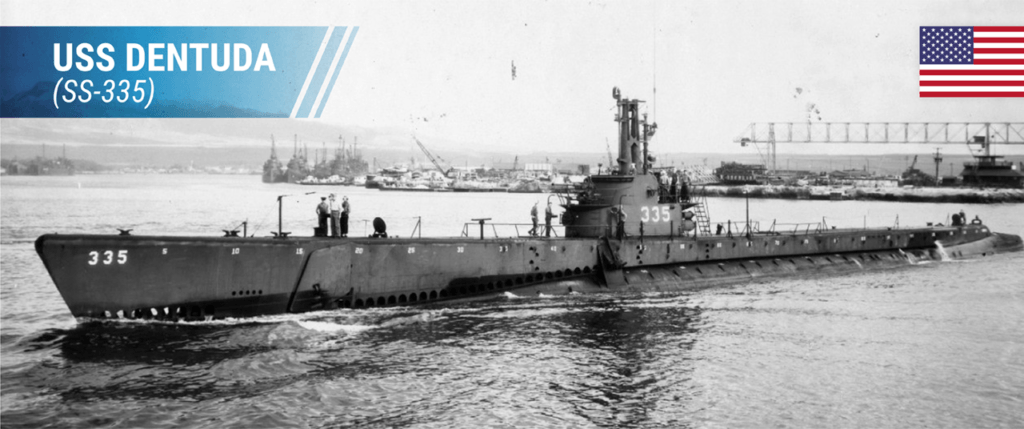
Adding to them were the submarines USS Tuna (SS-203), USS Skate (SS-305), USS Pilotfish (SS-386), and USS Apogon (SS-308).
Foreign ships
There were also the not so well-known but very interesting foreign warships, the Japanese Nagato and Sakawa and the German Prinz Eugen.
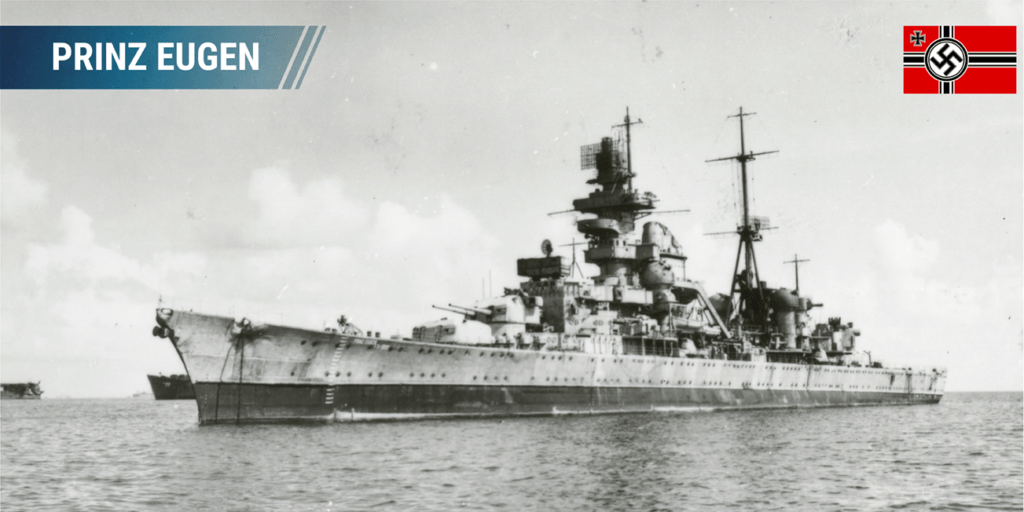
Prinz Eugen was a 10,000-tons heavy cruiser captured by a British force prior to been turned it to America. It was the largest surviving German vessel to making it out of the War.
She was named after Prince Eugene of Savoy (1663–1736), an Austrian field marshal who fought France and the Ottoman Empire. This ship made headlines in the early years of the war:
- First, in May 1941 by assisting the German battleship Bismarck sinking the HMS Hood. The Hood was the oldest and best-known capital ship in the entire Royal Navy.
- And then, together with battlecruisers Scharnhorst and Gneisenau, she participated in the dash through the English Channel (Operation Cerberus) in February 1942.
Prinz Eugen surrendered to the British at Copenhagen, Denmark, 7 May 1945.
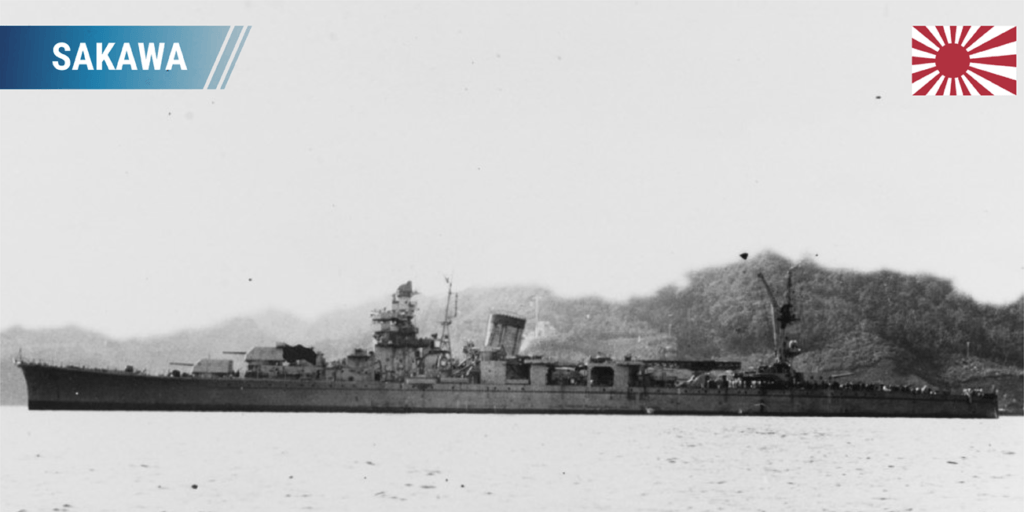
From the Japanese side, there was the light cruiser Sakawa. This 6,000-tons ship never actually saw battle. In this sense, it was the only World War II light cruiser that made it to the end of the war without suffering any damage.
Sakawa was commissioned at Sasebo on 30 November 1944. She replaced the sunken light cruiser Tama as the flagship of Destroyer Sentai (squadron) 11 in December 1944.
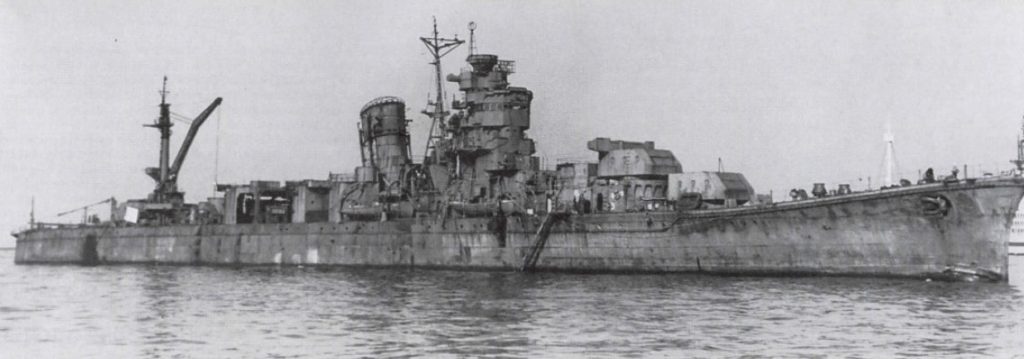
Fuel shortage preventer her from participating together with Battleship Yamato in Operation Ten-Ichi-Go (Heaven Number One). Operation Ten-ichi-go, was the most ambitious suicide mission of the war. Yamato, light cruiser Yahagi and eight destroyers were sunk by US aircraft while attacking the U.S. Navy‘s invasion force at Okinawa.
The light cruiser remained in the Inland Sea on training duties until July 1945 and surrendered intact on 15 August 1945.
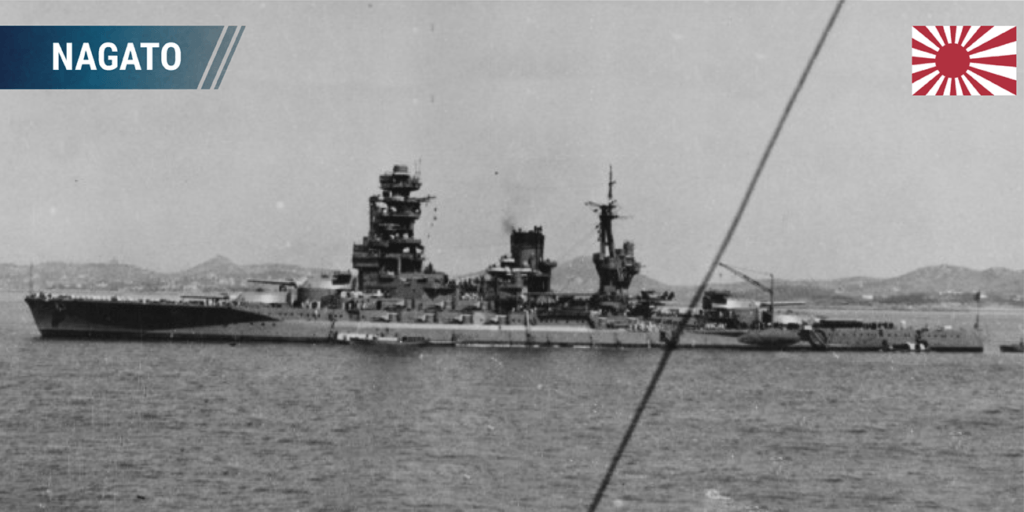
An then there was Nagato, the last surviving Japanese Battleship.
This 32,720-ton battleship was very special for the US. It was from Nagato that Yamamoto planned and commanded the attack on Pearl Harbor in December 1941.
She was also special for the Empire of Japan as as we will see in the next section.
Nagato
The battleship Nagato represented a milestone in Japanese naval construction.
Hiraga Yuzuru, the most famous Japanese naval architect, designed the ship. He turned away from the British model that Japan had previously adopted for capital ships. As a result, he created a ship that for some decades was the ultimate expression of Japanese naval power and prestige.
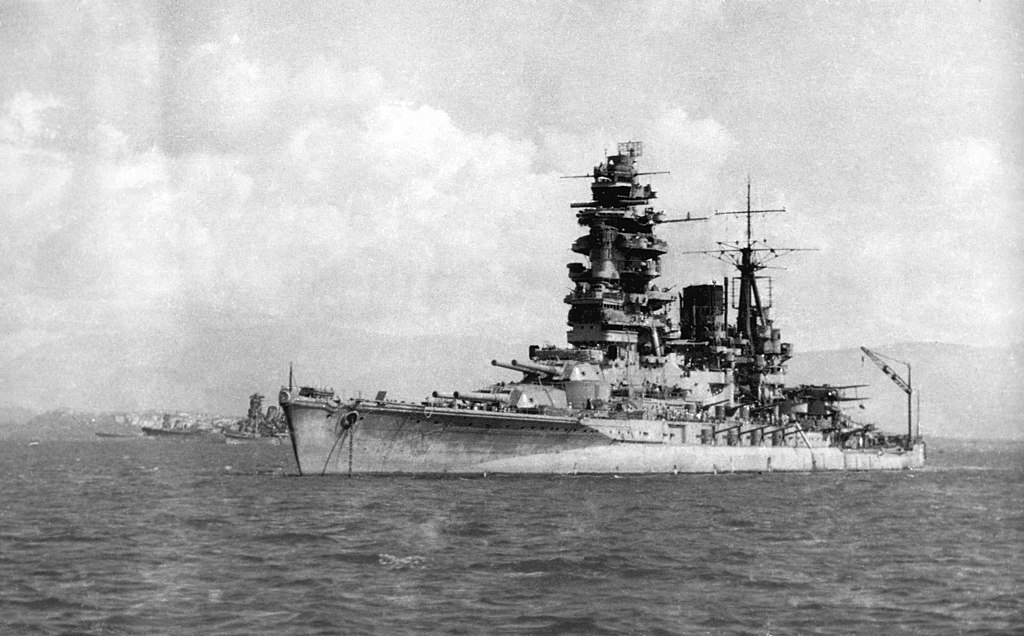
For instance:
- She was the first battleship in the world to carry 16” guns
- At 32,000 tons she was one of the largest battleships in the world
- She was the largest yet built for the Imperial Japanese Navy.
- She was able to counter the American Colorado and British Queen Elizabeth classes.
Nagato namesake
The Imperial Japanese Navy christened its Battleships after ancient provinces(Yamato, Fuso, Yamashiro). On the other hand, Battlecruisers were given mountain names (Haruna, Kongo, Kirishima). In this case, Nagato was the name of a province in pre-Meiji Japan. It was home to one of Japan’s most powerful warrior clans.
On commissioning, Nagato instantly assumed the role of the fleet flagship. She began the peacetime career of most of the world’s capital ships: exercises, training, protocol, and foreign visits.
During the 1920s and ’30s, Nagato together with this sister Mutsu were the national pride of Japan. That changed only with the commissioning of the battleship Yamato in December 1941.
Nagato wartime service
On September 1, 1939, Germany invaded Poland. On that same day, Admiral Isoroku Yamamoto took formal command of the Combined Fleet onboard his new flagship: Nagato. Then, Yamamoto on his cabin in Nagato, utilizing maps and intelligence summaries, prepared the attack on Pearl Harbor.
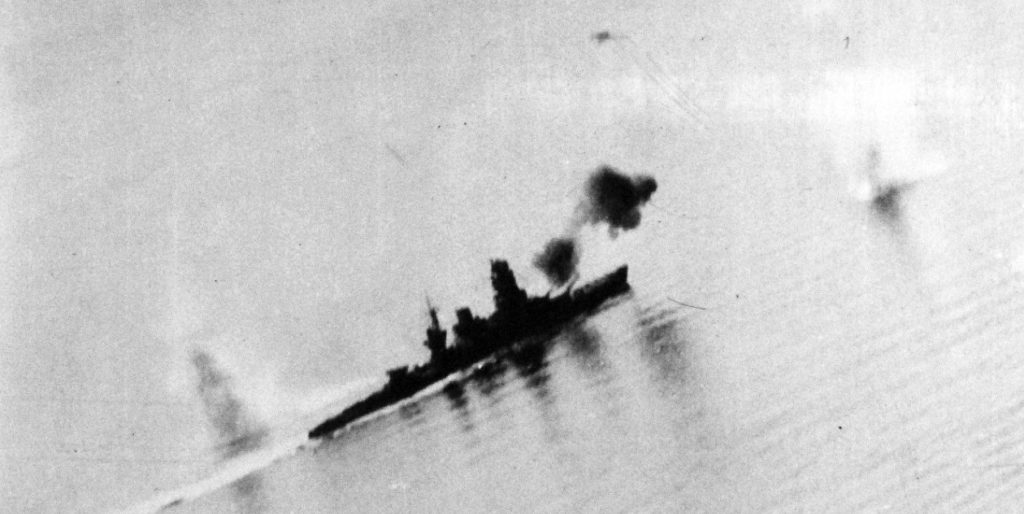
Finally, on December 2 1941 Nagato sent one of the most famous messages in naval history:
NIITAKA YAMA NOBORE 1208 (“Climb Mount Niitaka 1208”)
In other words, proceed with hostilities against the USA, Great Britain, and the Netherlands on 8 December. So, signaling the attack on Pearl Harbor.
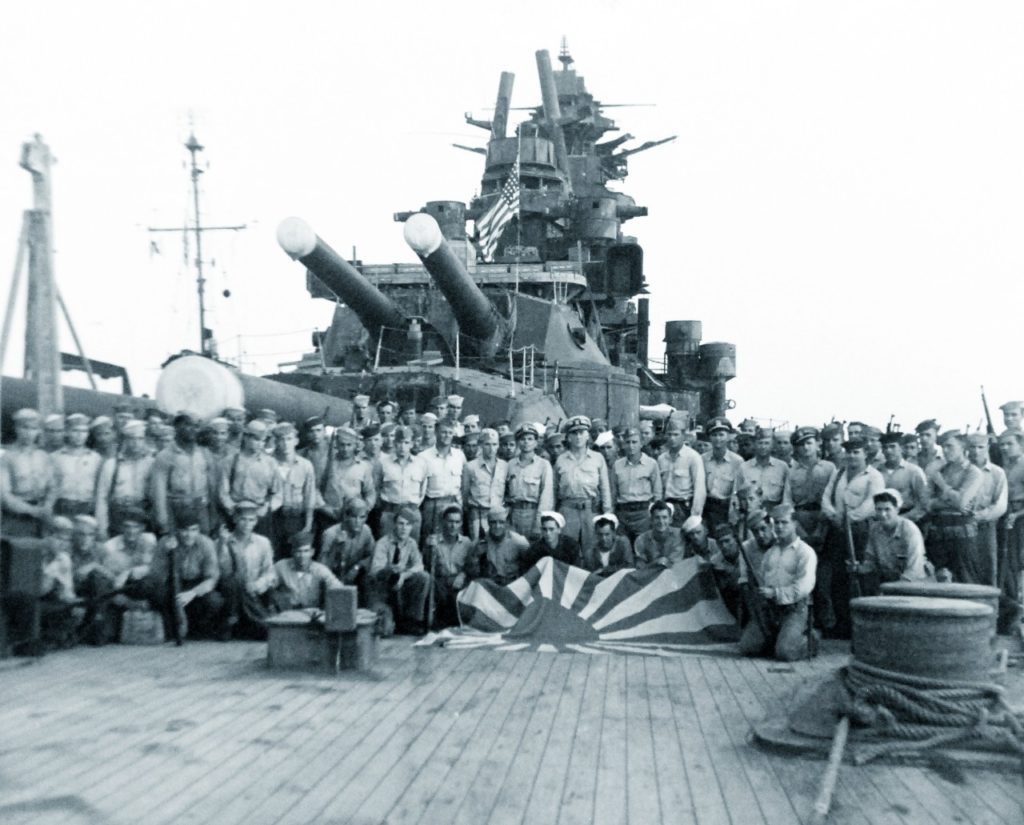
During the war, she participated in the battles of the Philippine Sea and Leyte Gulf. In the latter, Nagato took several bomb hits. As a result, she was drydocked in Yokosuka, but materials and fuel were scarce. The old ship finished the war as a floating anti-aircraft platform in Yokosuka.
On August 30, 1945, she was boarded by U.S. Navy personnel.
Nagato’s journey to Bikini
This list of events taken from Steve Wiper’s Warship Pictorial No. 38 – IJN Nagato Class Battleships:
29 August 1945: USS Missouri (BB-63), Iowa (BB61), numerous minesweepers, destroyers entered Tokyo Bay, anchor at Yokosuka.
30 August 1945: U.S. Navy boarded NAGATO anchored in Yokosuka, capture Nagato, symbolized unconditional surrender of IJN.
2 September 1945: Official surrender of Japan held aboard MISSOURI.
15 September 1945: Removed from U.S. Navy List.
1-14 March 1946: Nagato made three test runs in Tokyo Bay.
18 March 1946: Nagato departed Yokosuka for Eniwetok with a U.S. Navy crew of 180 men, with light cruiser Sakawa . Only 2x of Nagato’s 4x screws operation, best speed 10 knots.
26 March 1946: Nagato’s hull unseaworthy, pumps cannot keep up with leaks. Nagato shipped 150 tons of seawater in forward compartments, stern compartments counter-flooded with 260 tons water to maintain balance.
28 March 1946: Sakawa broke down. Nagato set tow-line to Sakawa, then Nagato ran out of fuel. Both ships stopped in bad weather.
30 March 1946: Two USN tugboats arrive from Eniwetok. Nagato taken in tow by USS Clamp (ARS-33). Without power, Nagato took on more water and a seven-degree list to port, towed at 1 knot.
4 April 1946: Arrived Eniwetok, flooded compartments pumped out, repairs to hull and machinery.
May 1946: Steamed at 13 knots, 200nm to Bikini Atoll.
1 July 1946: Operation Crossroads, Bikini Atoll.
Support Ships
Organizing the target ships was the job of Rear Admiral Frank George Fahrion (1894-1970). This group of the operation was the Joint Task Force 1.2.
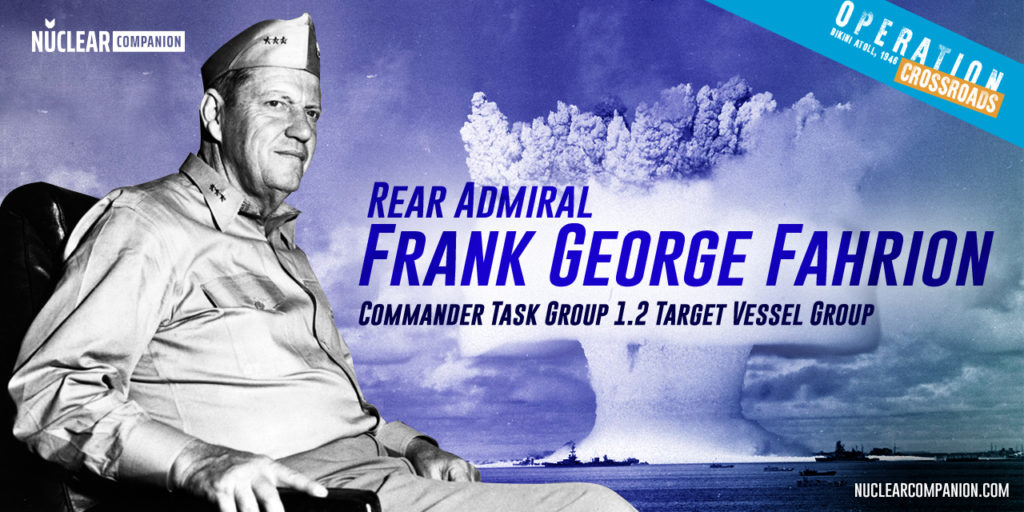
Not all the ships from this group were target ships, although most were. Nontarget ships supported the preparation, placement, and salvage of the targets. It was also among Fahrion’s duties to provide safe transport to scientific recognition of the ships after the explosion.
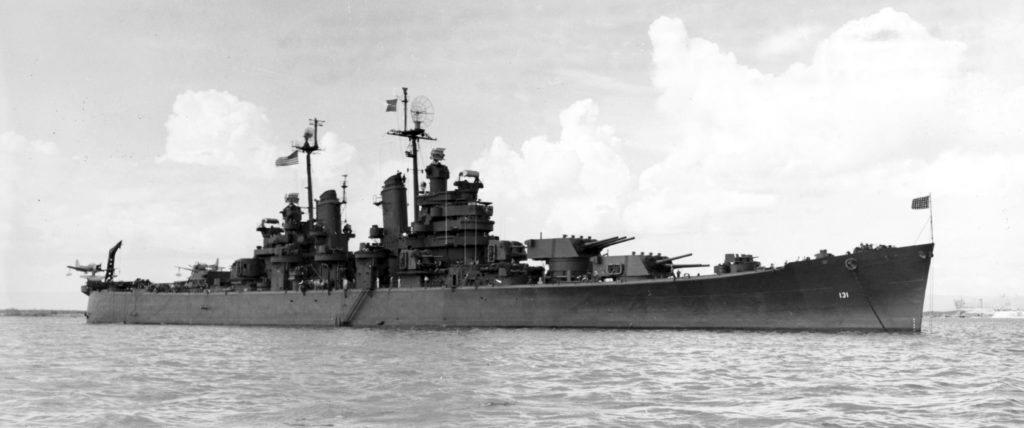
During the test, Fahrion was aboard USS Fall River (CA-131), the flagship of his task group, and one of the newest US heavy cruisers. It was so new that, finished in 1945, it did not even make it into World War II.
Rear Admiral Frank George Fahrion (1894-1970)
Native from Pickens, West Virginia, Fahrion graduated from the U.S. Navy Academy in 1917. After serving aboard USS South Dakota in World War I, he achieved a master’s degree in Science at MIT.
During World War II, Fahrion was in charge of different destroyers’ divisions in the Atlantic as well as in the Pacific. He was given command of the USS North Carolina in 1944. Being this ship one of the newest at the time in the U.S. Navy, his appointment to command was a sign of his leadership ability on the water.
In 1945 Fahrion participated in the Okinawa campaign commanding the Cruiser Division Four. With the end of the war, he was in charge of transporting Allied prisoners from Japanese soil. During this period, he also commanded the first American soldiers to enter Kyushu when the war ended.
When Admiral Blandy reached him for communicating his role in Operation Crossroads, he was acting as commander of a task force in Japan.
Testing in Animals
Another part of Operation Crossroads had as objective to recognize the nuclear explosion’s effect on biological beings. Most of all, the army wanted to know about the damage these new weapons could do to them in the short and long term.
It is true that the nuclear bombs detonated on Japan did show a great number of these deadly effects. Nonetheless, the US army wanted to measure them this time in a controlled environment.
The chaotic war scenario made it difficult to know if a certain wound or illness was due to the bomb itself or to a previous or posterior cause. In this way, the U.S. could study the bomb effects without the interference of other variables.
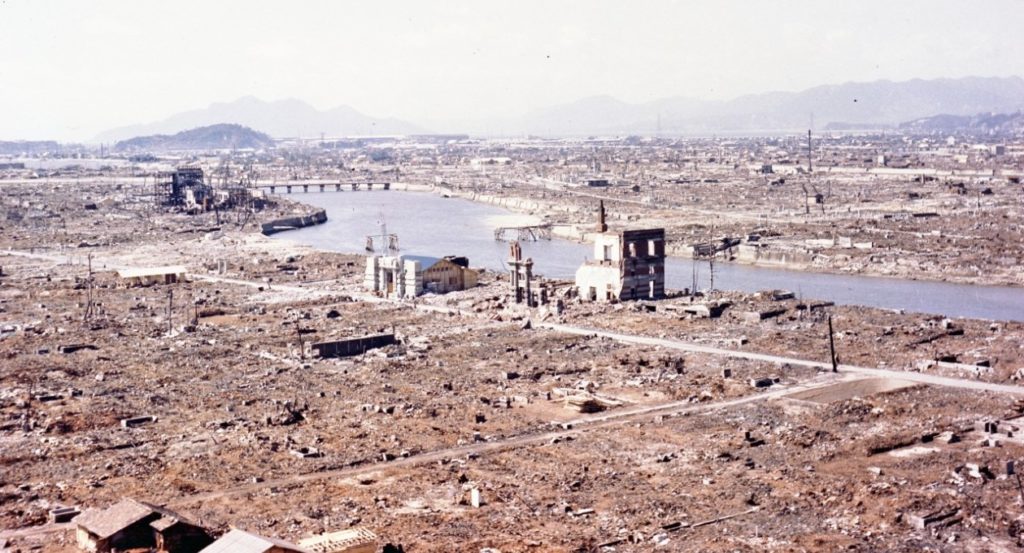
This is why the U.S. Armed Forces included live animals in the test as a key component of it after scientists insisted on it. Their inclusion was firstly denied by Blandy, yet he had to admit later that they were indeed part of it.
“The important thing to bear in mind is that this aspect of the test will save men’s lives in the next war—should there be one. Our doctors feel that they cannot draw complete deductions on what may happen to man by instruments alone; therefore, they desire the use of animals.”...“
a minimum number of animals will be used. We regret some of these animals may be sacrificed, but we are more concerned about the men and women of the next generation than we are about the animals of this one.“
Vice Admiral William H. P. Blandy
Surely, the use of animals brought global attention from animal rights groups against the cruelty of the experiment. In this sense, although dogs were ready to be part of the test, public pressure in the form of letters made Blandy desist from introducing them.
Animals
The list of animals involved goes like this:
- 5,000 rats
- 204 goats
- 200 pigs
- 200 mice
- 60 guinea pigs
- Thousands of fruit flies
Pigs were chosen specially for their skin, similar to humans, allowing scientists to know how would it react to radiation. Likewise, goats made it to the test for their human-like weight and respiratory system. Of these goats, four had particular psychoneurotic behaviors that would also become part of the research.
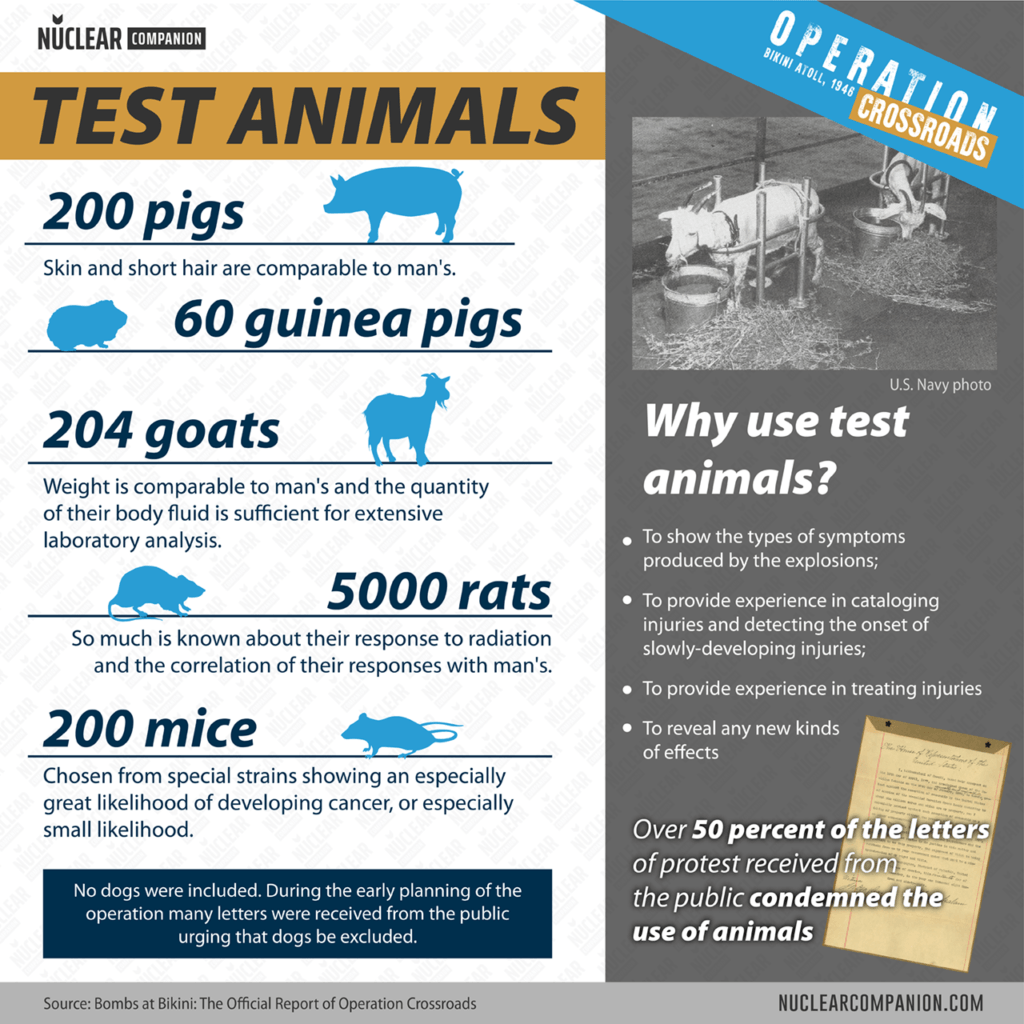
At the same time, the scientist chose to test goats due to the particular properties of their blood. Goat’s blood has a higher density of red cells than humans, which are also considerably smaller. This would provide a distinct object for examining the effects of radiation in blood.
Operation Crossroads also included seeds and soil samples located near the explosion. These were relevant in knowing what kind of lasting effect radiation has on human basic resources such as land and farming. Even viruses, toxins, hormones, and vitamins had their place on the test.
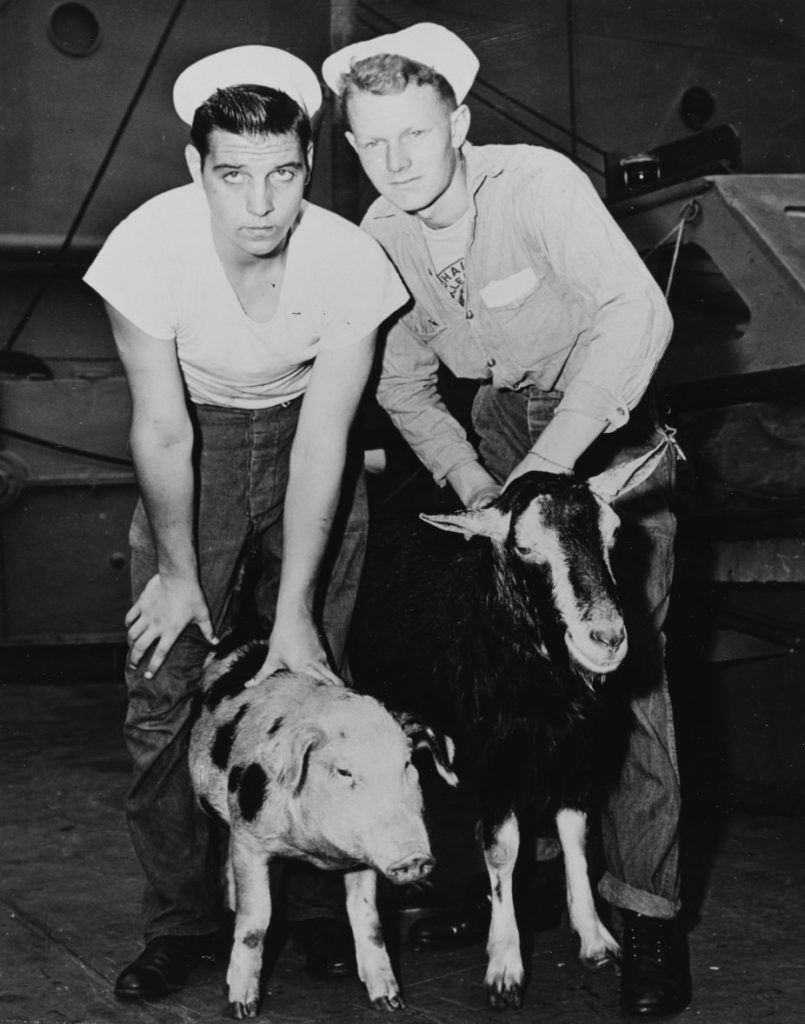
The U.S Armed Forces ere indeed interested in taking as much valuable knowledge of the test as they could.
In this way, for this large biological research, the U.S. Navy created the Naval Medical Research Section. In it were many U.S. Navy officers and members of the Chemical Warfare Service and Biological Warfare Division of the U.S. Army. At the same time, adding to them were civilian scientists such as physicians and veterinarians.
In charge of the medical research team was R. H. Drager. His team was in charge of performing autopsies on the animals’ bodies. They were looking for two radiation-related afflictions: cancer and radiation hereditary defects.
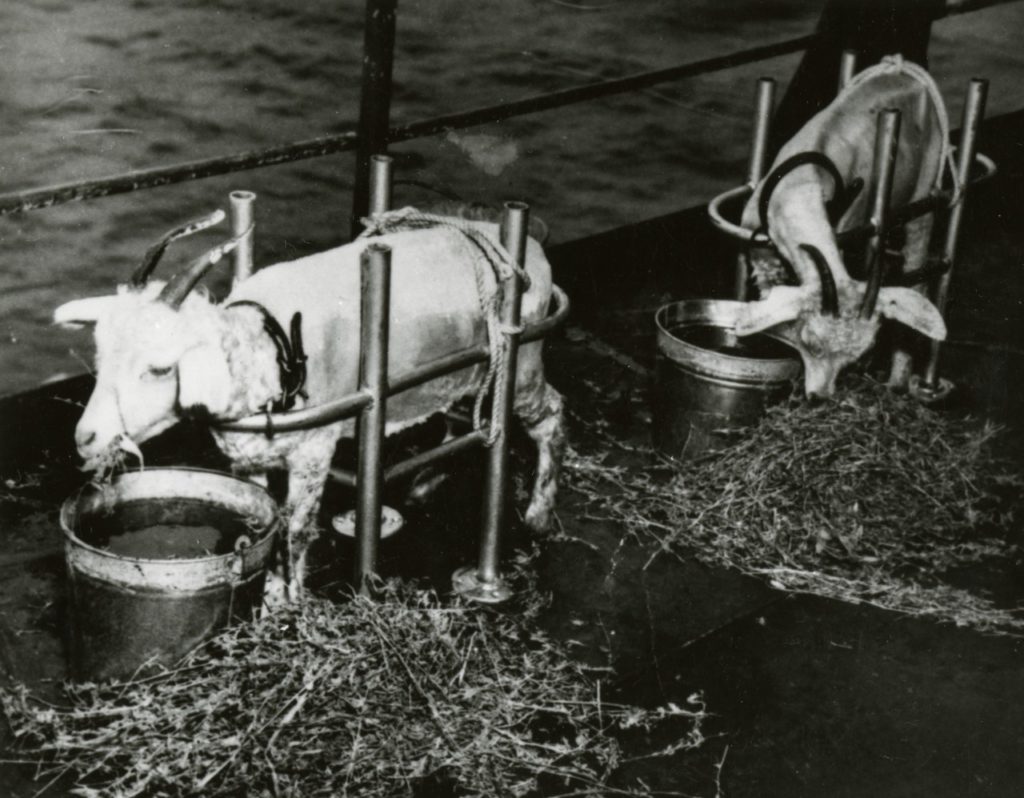
In this sense, cancer was the reason why mice were in the test. Moreover, the operation was actually backed up by the National Cancer Institute.
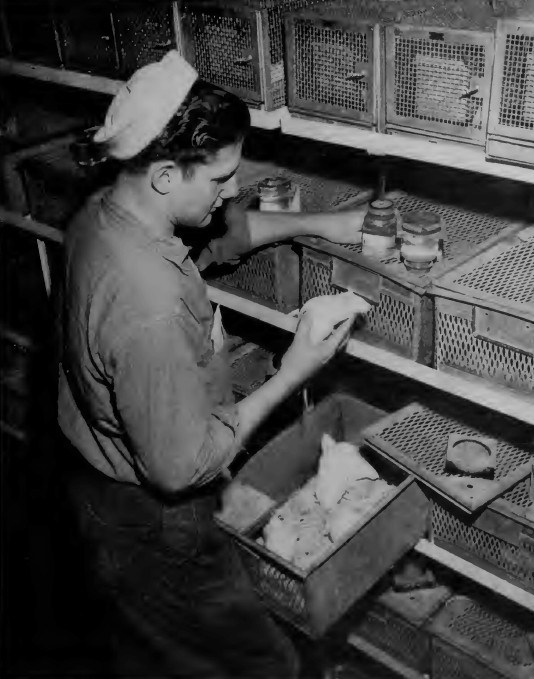
The experiments also included the testing of potential medicine for radiation poisoning. Among them were penicillin, iron compounds, folic acid, and blood hemoglobin derivatives.
Physicians also wanted to experiment with medical practices like liver extractions. They also tested the hypothesis that blood injections could have saved many lives in previous nuclear explosions.
Animals began to be loaded in May 1946 from San Francisco and set off the first of Jun.
A modern Noah’s Ark
Attack transport ship USS Burleson (APA-67), named after the Texan county, arrived at Bikini with all the animals for the test. This ship had set sail for the first time in 1944 to serve in World War II. At that time, the ship could ship as many as a thousand fully equipped troops.
Yet, after the war, Burleson mutated to serve as transport for the animals of Operation Crossroads in the Joint Task Force 1. Burleson’s transformation included a visit to the Hunters Point Navy Yard (California). There, engineers added to the ship its onboard research laboratory.
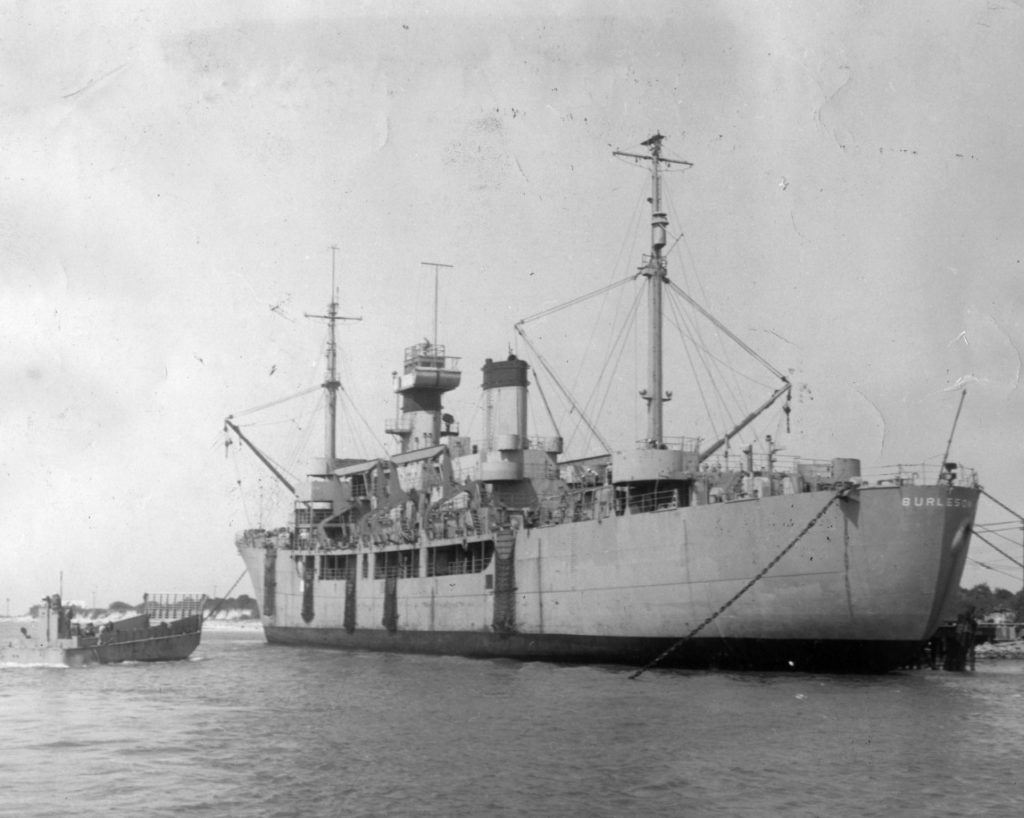
At the end of the adjustments, Burleson’s specialized staff had everything they needed for dissecting the animals. In this sense, at the time it had most likely the top-notch onboard research facility in the world.
Burleson was also equipped with dedicated rooms for the animals to drink, sleep, and eat. As a matter of fact, it transported around 90 tons of animal food like hay and grain and a large enough water supply from evaporators.
Big mammals, goats, and pigs even had their own wooden pens where before were quarters for transient troops. Each of these mammals had their ears notched and tails tattooed for numbering. Rats, for their part, had their cages racked in a separate room.
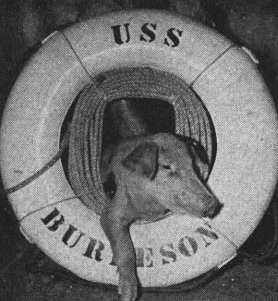
Burleson’s deck, on the other hand, was specially adapted for the animals. It was covered with concrete for better footing and had drainage and disposal chutes aggregated. As a result, this ship became, in words of an army general, a “great, dirtless farm, a palatial hotel for animals”.
C. F. Stillman, captain of the ship, shared this view. Despite their fate, army care for the animals was the highest. Stillman, who declared himself to be an animal lover, put a lot of emphasis on the animals’ comfort as if they were regular passengers.
Experienced Handlers
Two divisions took care of the animals’ integrity. The crew was composed specifically of personnel from the 12th Naval District with a background in husbandry.
In this way, besides the regular crew of 190 individuals, an extra of 25 volunteered for taking care of the special passengers. Most of them had experience dealing with animals, and in the rather short time they spent with them they ended up petting them.
Main Veterinarian
The head veterinarian was Captain Dr. Robert P. Wagers. Graduated from Ohio State University in 1936, he was a former Kansas State college faculty member. Before the operation, he had spent five years in this position in the School of Veterinary Medicine.
In 1942, Wagers left the institution on military leave of absence as he had an interest in animal research. As such, he became an assistant in the chemical laboratories at Edgewood Arsenal, Maryland.
The ABLE day Bombing competition
Operation Crossroads was not simply a routine test for recently created Strategic Air Command. It was, in any case, a test on its own capability. Representing the US Army aerial nuclear force, it was SAC‘s very first nuclear weapon deployment official test.
It’s not hard to grasp, then, how SAC had the highest concern in finding a bombing crew to match up. Those in charge of the dropping had to be but the very best the US Air Force could offer and had the experience to back that up.
The Air Force’s headquarters decided to determine who would perform the nuclear dropping by a bombing competition. After an extensive selection process, five crews made it for determining who will make it to Operation Crossroads. SAC chose five bombardier crews for the Air Attack Unit, assigning to each one the required crew personnel for a B-29.
The Pilot/ Bombardier teams were:
- Colonel Paul W. Tibbets / Maj. Thomas W. Ferebee
- Maj. Claude R. Eatherly / Lt. Franklin Wey
- Maj. Jack J. Catton / Lt. C.L. Coy
- Maj. Woodrow Swancutt / Capt. David Semple
- Maj. W.R. McPherson / Lt. C.R. Hammack
One of these crews was the same in charge of the Hiroshima dropping. Col. Paul Tibbets was in front of it, alongside Tom Ferebee (bombardier) and Ted Van Kirk (navigator).
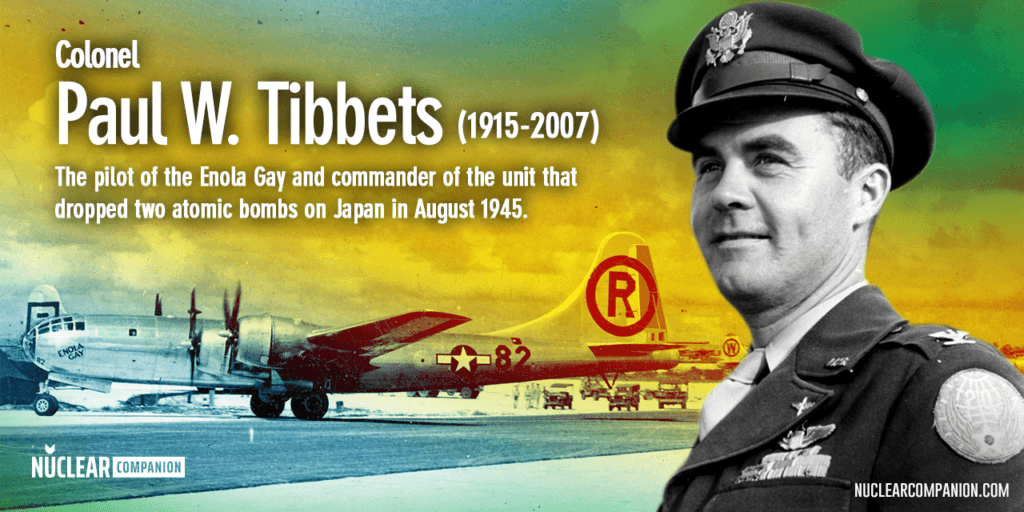
Considering their unique experience, Tibbets and his crew were anyone’s first option for the job. But why organizing a competition in the first place, then?
We should consider that the Air Force had an interest in having more pilots trained in these sorts of weapons, that is, nuclear weapons. In this sense, the competition’s secondary objective was to make more aircrews used to the know-how of nuclear droppings.
Another relevant crew was Cap. David Semple and Woodrow P. Swancutt’s. Born in Riverside, California, Semple had meritoriously been part of the 19th Bombardment Group. Before the competition, he had earned the Legion of Merit for his 400 hours of air service.
Swancutt, for his part, had been a B-29 pilot in the 40th Bombardment Group for the 20th Bomber Command. This was the unit in which the B-29 bombardier entered World War II. Swancutt’s flight experience led him to Asian countries like China, Burma, and India, as well as to the Pacific.
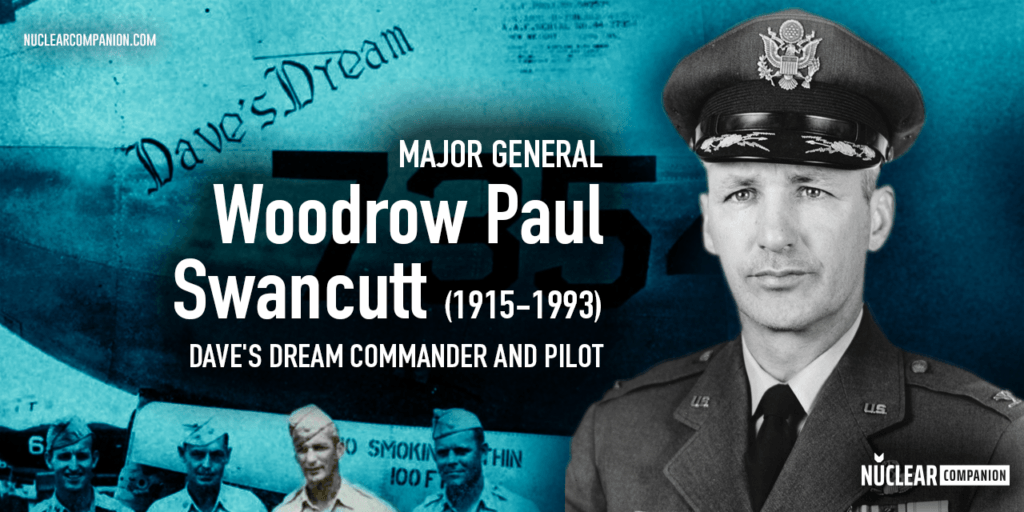
In these locations, Swancutt participated in a total of 49 missions. Among them was the first b-29 daylight bombarding, which was on the Yawata Steel Mills in Japan. His unit received the Presidential Unit Citation for this particular mission.
Albuquerque
From Feb. 15 to Apr. 9, the competition’s first part took place in Albuquerque’s desert. The crews had at their disposition many practice bombs in possession of the Manhattan District. This was the same engineering district in charge of the famous Project Manhattan.
On the ground, following and analyzing droppings’ data were an SCR-584 microwave radar as well as RC-294 plotting equipment. Each inside its own van.
These eight weeks in Albuquerque resulted in a lot of bombing. The crews made a total of 40 simulated droppings of which 31 were written down as successful, proficient drops.
Albuquerque’s desert offered great visibility to recognize targets set for droppings. Plus, New Mexico had ideal steady winds at different altitudes. These winds were great not necessarily for maneuvering but for more precise bombing calculations.
Furthermore, Manhattan engineers benefited a great deal from these practice droppings. With so many test drops, they were able to learn about the firing mechanism of the bombing process.
In fact, when the competition started the Manhattan district had the only bombing tables made for this bomb. However, the data they had was no good for the crews.
Fatman’s tables, containing the dropping settings for Able test’s bomb, were only for low altitude targets. As such, they couldn’t be reliable for the test droppings been made in Albuquerque.
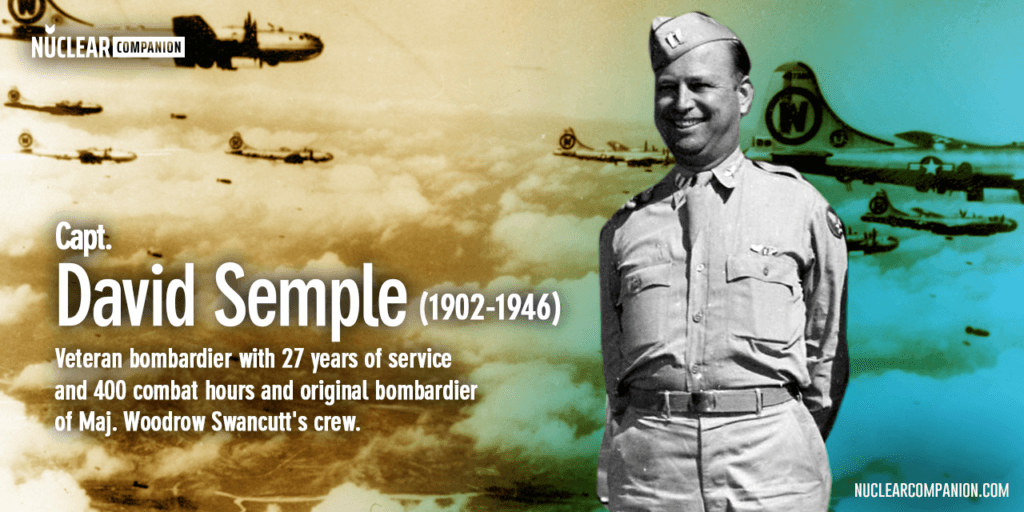
These tables were put together by Captain Semple himself when he was part of the Manhattan District the year before. Likewise, it was him who noticed, after the initial droppings, that these tables wouldn’t be of help. Semple then started to work on contingency tables specifically for Albuquerque’s atmospheric conditions. Soon enough, Semple’s calculations eliminated 75% percent of dropping errors.
But for getting rid of more flaws in the bombing process it was necessary to have more information on the composition of the bomb itself. In this sense, since day one the crews required all the ballistic information of the Fatman bomb.
This was, nonetheless, top-secret information in the hands of the Manhattan District. The Manhattan District was reluctant to provide such information. Ballistic tables for the Fatman bombs arrived at Kwajalein Atoll only by May 8, yet in time for the second part of the competition.
Sadly, Semple wouldn’t make it to Kwajalein. He died on Mar. 7 when he crashed in a B-29 near the small village of Las Lunas, New Mexico. He was only 45 years old.
With Semple’s death, the Task Force and Task Group 1.5 lost an important asset in the test course. At the time of the accident, he was still working on the new tables for the bomb.
Yet, the greatest loss was for Semple’s team. From Feb. 19 to the 23, they had made four different drops and were still in the run for winning the competition. But Semple’s death left them without a bombardier and on the verge of having to abandon.
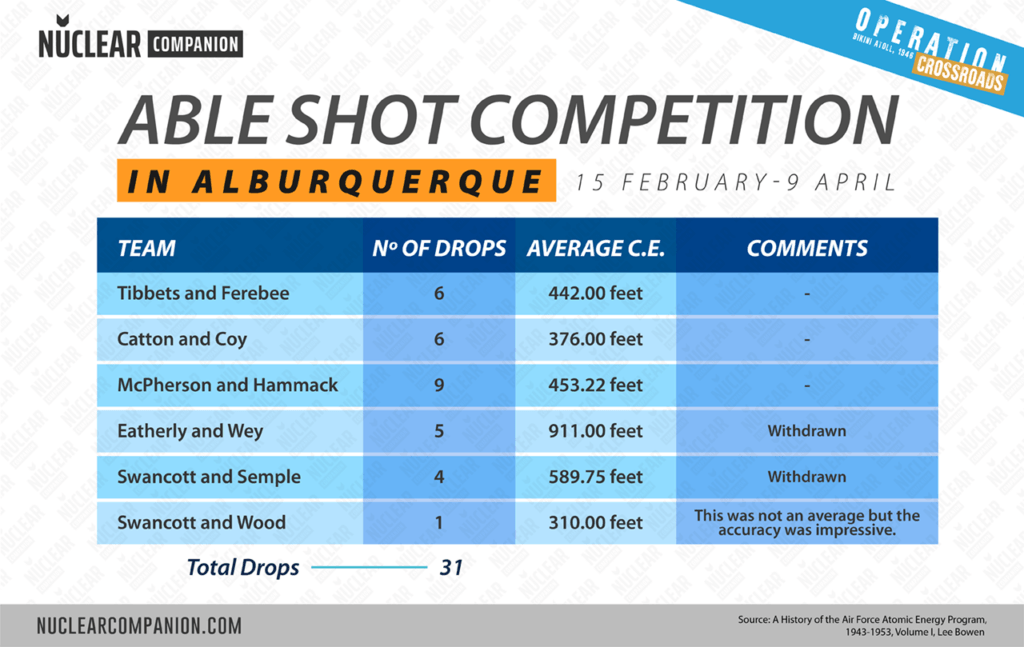
This would have been the case if not for Maj. Harold E. Wood, aka “Lemon Bar”, the nickname he received from other officers for his luck with the slot machines.
As a bombardier, Wood fought in 24 missions in World War II. He was part of two Air Force leads, as well as four and five Division and Wing leads respectively.
Once a grocery clerk in Bordentown, New Jersey, Wood was awarded two Purple Hearts for his participation in the Normandy invasion. Wood took Semple’s place by the end of Mar. With the rest of the crew, and they completed a valid drop on Apr. 2 avoiding getting out of the competition.
Aside from these droppings in the desert, there were another three tests to be made before departing to the Pacific. These were long scale tests and required the help of many of the Task Group’s aircraft from Operation Crossroads and of the Manhattan District. The first two took place on Mar. 8 and 9, respectively, and the third on the 14.
Operation Zebra
This last one, known as Operation Zebra, set a more realistic scenario. While the first two took place on Albuquerque’s bombing range, the third was a hundred miles offshore of San Diego’s coast. The mission consisted of a simulacrum of the actual bombing elements and procedures to take place in Bikini. As such, they used an actual Fatman bomb (of course, without nuclear components).
Aside from the B-29 carrying the bomb, another three from Kirtland Air Force Base took part in the operation. These additional B-29 carried and deployed pressure recording instruments.
One of these B-29, though, had to abort its participation at the start of the operation. Also, eight F-13 from the Roswell Base were summoned for photographing the test.
A Landing Craft Infantry or LCI was the U.S. Navy’s chosen target. Yet, due to weather conditions, it had to wait until the next day to start the operation.
When the time of the operation came, the LCI proved to be not an easy target to find. It was but a little thing on the immensity of open waters and its whitecaps and waves. Radars, for their part, couldn’t be used, so bombardiers had to rely on coordinates rather than sight.
According to the measurements, the bomb exploded 1,000 feet before reaching the water. In terms of testing the equipment and the mechanism of the operation, the engineers of Manhattan District were pleased. They agreed that Operation Zebra’s outcome was richer than that of the tests made at Albuquerque.
During this time, on 22 Mar., the Eatherly-Wey crew was dismissed from the competition. Their drops finished always in the last place, as no one even made it to the 500-feet error mark. In fact, three of them were as off-target as more than 1,000 feet.
Kwajalein
As we said earlier, the second phase of training took place not in the mainland U.S. but in the Pacific. The initial scenario was to be Bikini Atoll itself.
Yet, the wind, highly unpredictable at all altitudes, was not on the test’s side. It was hard for navigating and ballistic correction. The cloud-capped sky didn’t help, neither the very few ground checkpoints available.
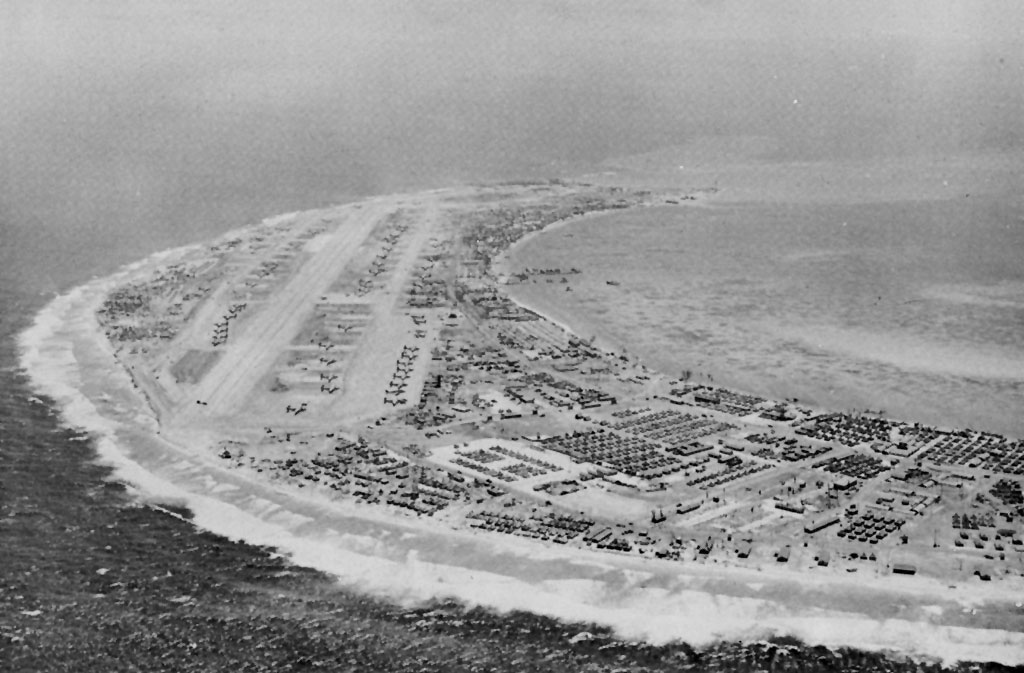
The crews didn’t take long to notice, though, that droppings’ accuracy was way lower than the marks made in Albuquerque.
From May 11 to Jun. 14 training continued at Kwajalein Atoll. Shortly after, Ramey, at arriving at Pearl Harbor on May 14, saw the performance reports. He was not happy with how the tests were going.
Ramey’s own analysts made their way to the tests’ atoll and take a look at Holloway’s bombing tables. On May 28, Kepner arrived at Kwajalein and caught up with the situation. He concluded that the bad results were related to poor visibility along with the previous interruption of training in Apr.
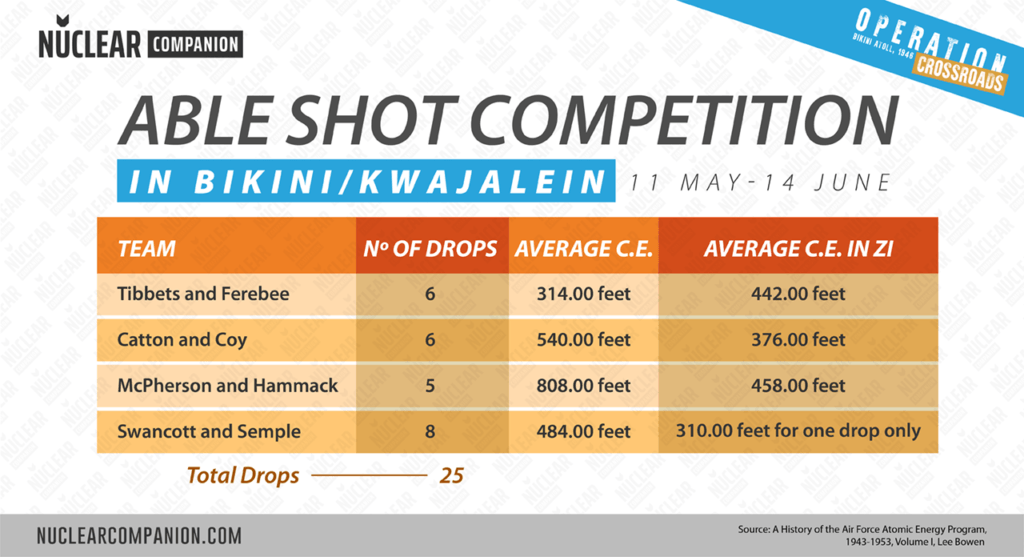
Yet, the main problem was the wind. The local wind, to be precise.
Despite the little time they had, analysts came up with a detailed study of atoll wind shears by Jun. 8, only 23 days before Able detonation. With this data, bombardiers were able to adjust their sight according to the wind properties. As a result, the tests’ marks improved greatly.
These last days, between Jun. 11 and 14, the teams completed 25 drops. To Ramey, the time to finish the competition started by the end of May. Only a month away from the start of Operation Crossroads.
The crew selection
The decision was of critical importance for Task Group 1.5 as well as for the Joint Task Force. In fact, for the whole Air Force reputation. Even the U.S. Armed Forces’ public image could be damaged, considering that the whole operation has cost an enormous amount of money.
The objective of the test was to achieve the 500-feet accuracy mark. Failure was not an option.
On Jun. 13, Ramey received Blanchard’s word on the matter. In other words, his recommendation for declaring Swancutt-Wood’s crew as the winner of the competition.
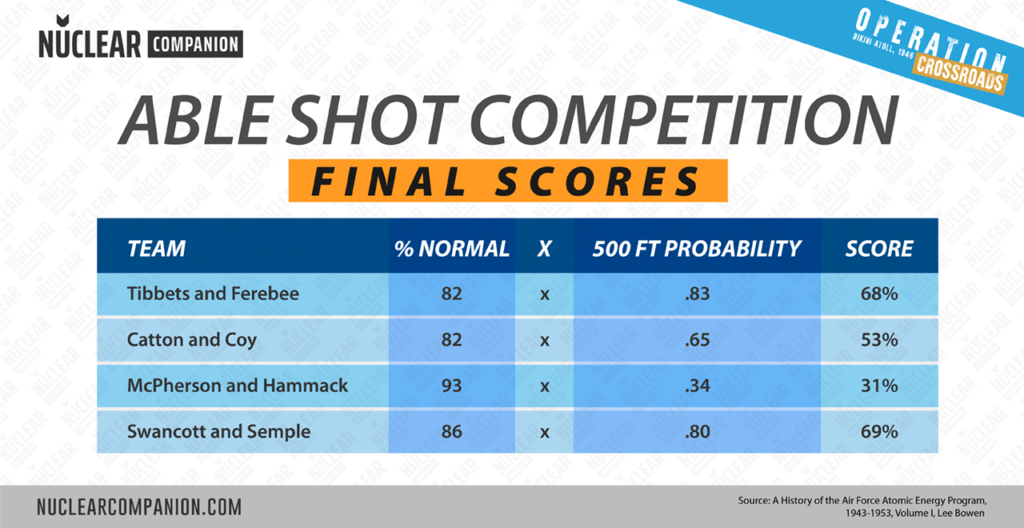
Blanchard justified his decision in the fact that Swancutt’s crew had the privilege of having worked with Semple and learned a lot from him. At the same time, Blanchard acknowledged that Wood himself had a long record of experience as a bombardier.
To Blanchard, Wood was in fact not a mere replacement but a perfect addition. He considered remarkable Wood’s character of facing adversity and his curiosity for learning. On a technical level, he recognized him as exceptional in following bombing procedures.
Lastly, Blanchard suggested Col. Tibbets’ crew be the backup crew. This was, of course, in case the last tests for the next days didn’t change anything, and this wasn’t the case. The subsequent three drops made on Jun. 14 resulted in the confirmation of Blanchard’s recommendation.
The next day, Ramsey presided a meeting exclusively for the members of the participating crews and for the Operations Staff. He then announced Swancutt, Woodrow, and the rest of their crew as winners.
It’s worth noticing that despite being the favorite, Enola Gay’s crew was not the winner. Tibbets stated later that on paper he had actually won the competition, yet the test was rigged. According to him, test droppings’ results were deliberately altered for displacing him from the first place.
Tibbets said that in the droppings from 30,000 ft. he averaged an error of only 237ft. These numbers would have put him and his crew even above B-29 Norden bombsight’s capacity itself and above the rest of the participants. Yet, he declared that his score was affected by the inclusion of “ballistic wind” into the equation, putting him and his crew in the last place.
Going back to Swancutt-Wood’s crew, considering their abilities and experience we cannot think of the underdog. In fact, in facing the death of Semple by continuing with the competition they showed great tenacity.
At receiving the news of their winning, they decided to rename the crew’s B-29 (no. 354) as Dave’s Dream, honoring deceased Captain Semple.
Test ABLE
Preparation
As the day for Test Able approached, all ships had arrived at Bikini Atoll. 92 US and 3 foreign ships of all forms and sizes.
The smallest ships were concrete barges and 36-foot large landing crafts. Among the largest were cruisers, five battleships, and submarines. There were even two carriers, including 888-foot Saratoga.
Some of them were surviving ships from almost all relevant World War II naval battles. The list includes Pearl Harbor, Coral Sea, Midway, Leyte Gulf, the Solomons, the Aleutians, and the Bismarck breakout.
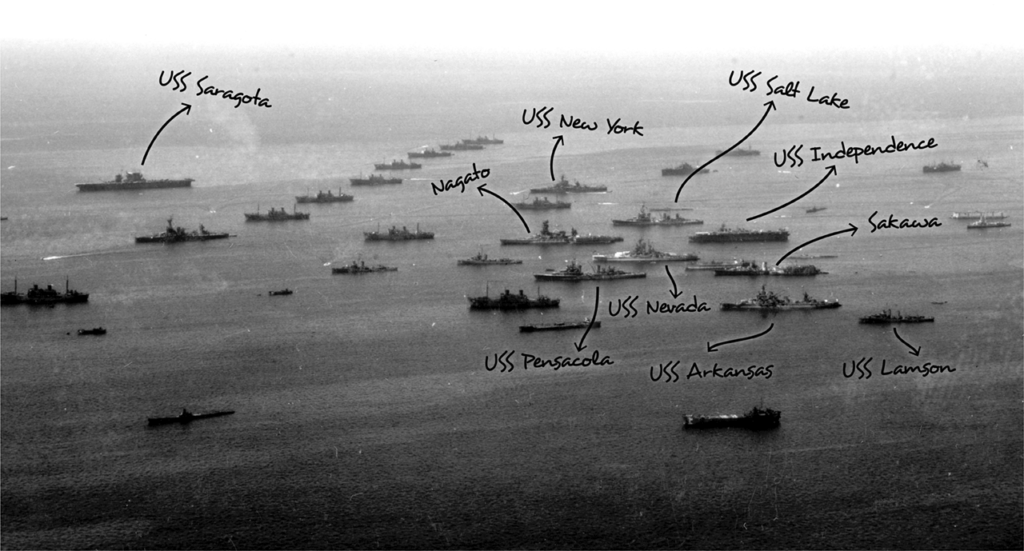
Considering its size, at the time the target fleet was the fifth largest in the world. Yet, this fleet wasn’t in form for battle.
Some of these ships had several instruments for measuring the explosion’s shock wave power and velocity. For this task, the navy made use of 5,000 pressure gauges, 25 radiation measuring instruments, 750 cameras, and 4 TV transmitters.
Yes, TV transmitters. Due to its importance and singularity, Able Day was on live television and radio worldwide.
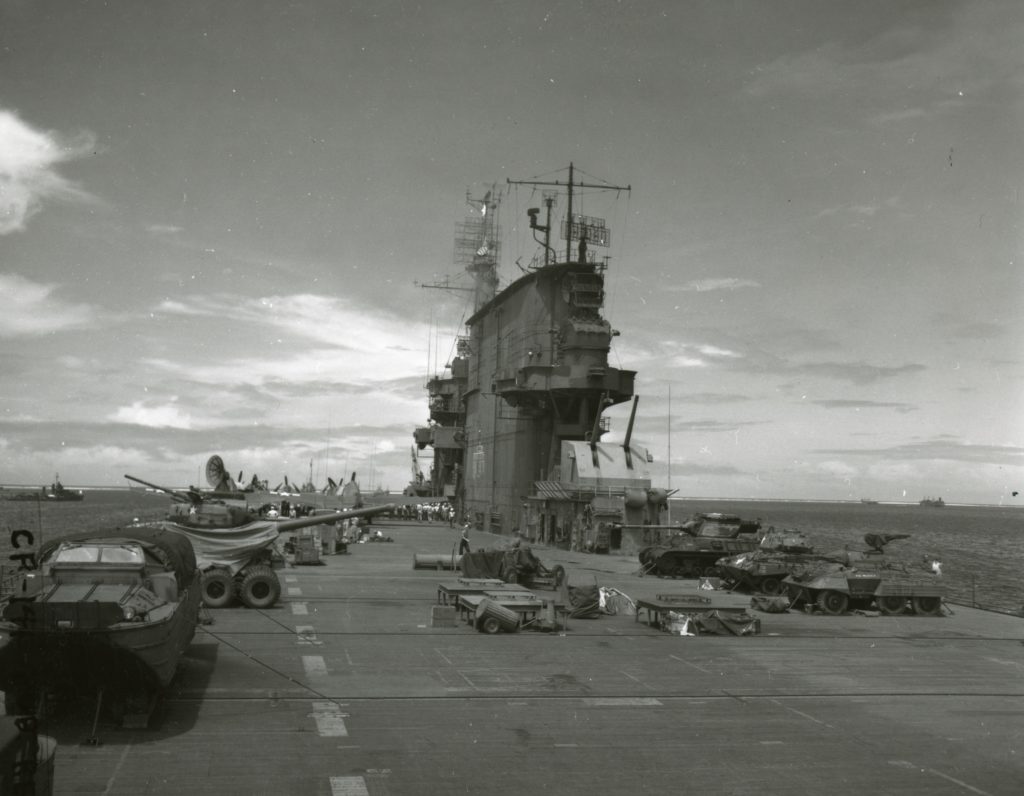
At the same time, the navy loaded 22 ships with fuel, ammunition, and all sorts of equipment. They wanted to know how would radiation affect not only warships themselves but also what you would expect to see inside of them. Things like radios, fire extinguishers, telephones or gas masks, watches, uniforms, and canned and frozen food.
Even heavy vehicles like tanks, tractors, and airplanes had their place on these ships. A total of 71 airplanes, to be precise, including two tied up seaplanes. All these extra objects accounted for a total of 220 tons of weight.
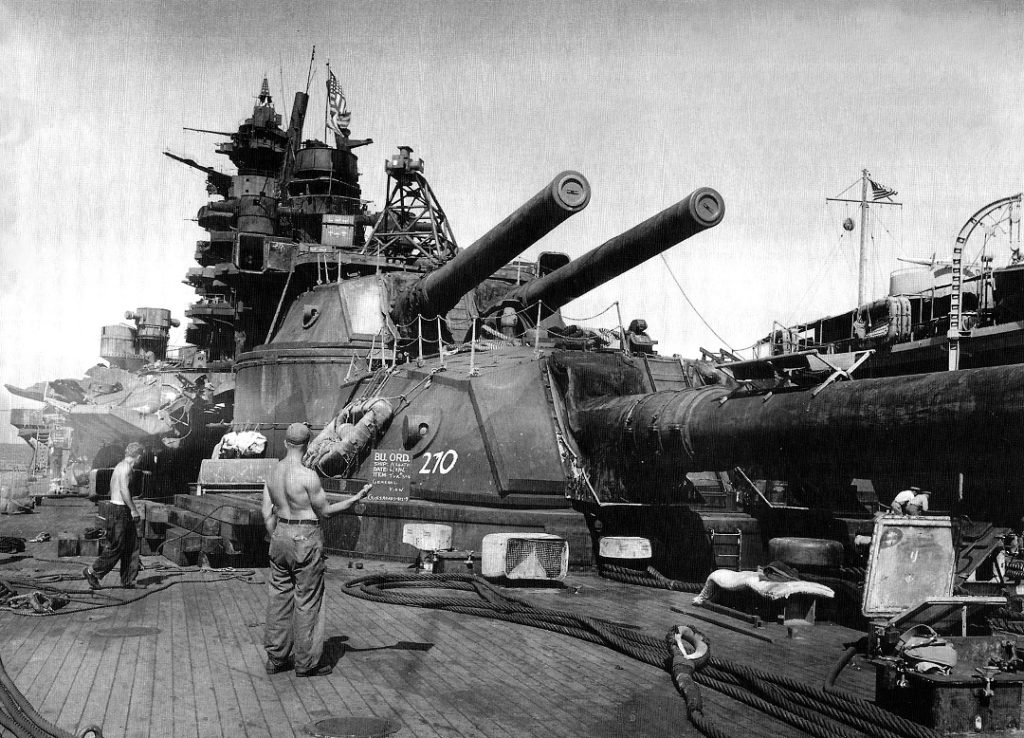
The U.S Navy set ships of every category at different distances, from the closest to the explosion to 4000 yards away. This was to learn how similar ships would take damage at different distances.
23 ships were within the 1,000-yard radius of the explosion. Arriving at Bikini in the last days of May, Battleship Nevada was the chosen target for the dropping. As we said earlier, for making a better target, it was painted bright chromite red and orange.
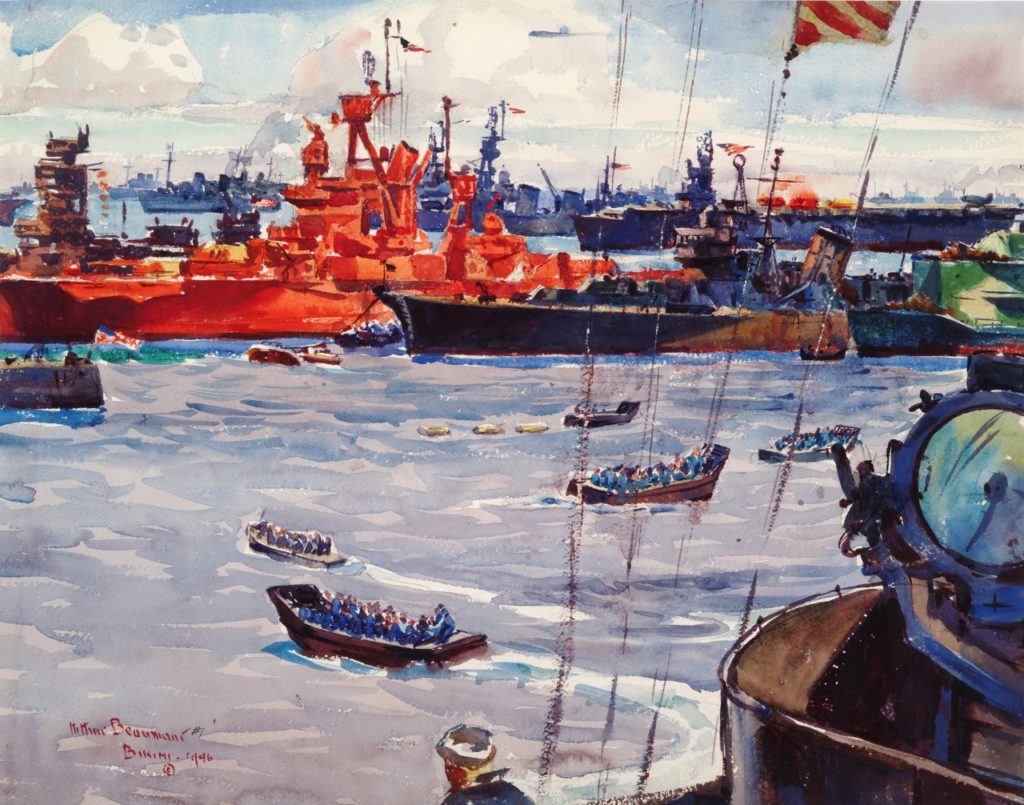
Support ships, for their part, were gone from Bikini on the sunset of Jun. 30, the day before the test. They went to their positions for the test: around 15 miles off Bikini from east to northeast. These positions used car models as codenames, e.g. Hudson, Packard, Soto, and Studebaker.
Just hours later, by midnight, the bomb was load into its bomber in Kwajalein. This was, as we said earlier, B-29 “Dave’s Dream”, number 44-27534.
Bomb away, and falling!
Early in the morning of July 1, at five to six, to be precise, the bomb began its flight and reached Bikini at three past eight at an altitude of 32,000ft.
Following Dave’s Dream for scientific purposes were other aircraft. These were U.S. Navy F6F Hellcats and U.S. Army B-17 Flying Fortresses drones we mentioned before. Along with them were also 79 aircraft around the atoll, some of which carried VIPs and press members.
All was in place to start, but Dave’s Dream made a few practices runs before the actual bombing.
The first practice run was for checking wind velocity by radio from the aerological group. The second, at twenty past eight, was timed by a radar beacon from 50 miles away. This was for the plane crew for making adjustments for meeting the studied approach time and course.
This last practice bombing took place at twenty-nine to nine. The bombing crew had the additional help of a flashing lamp on Nevada. The visibility was perfect.
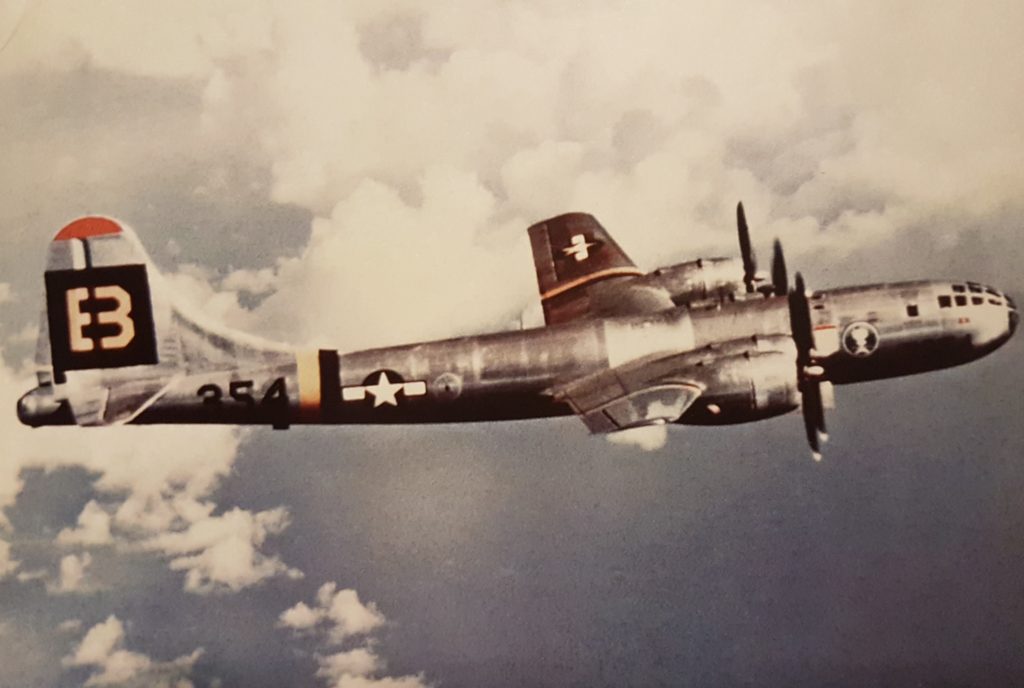
By this time, all crews of the operation were on deck, ready for watching the actual bombarding. At ten to nine, 50 miles from its target, Dave’s dream began its flight for the bombing run.
In Appalachian were also the media ready for covering the story. Cloth swatches on plywood sheets server for facing the blast. They also had special goggles for the blinding-intensity of the explosion.
Just seconds before 9 o’clock, Wood announced by radio:
“Mark! Bomb away, bomb away, bomb away, and falling!”
followed by other crew member’s:
“Listen, world, this is Crossroads!”
The bomb was dropped from 28,000ft.
The explosion
For the dramatic effect, the time from the dropping to the impact was counted by a metronome next to a microphone inside Pennsylvania. The explosion would coincide with its destruction and silence.
After the drop, the plane made a 150º turn to the left for retreating, making a shallow dive while speeding and descending a thousand feet. The ticking of a metronome was the sole sound on the radio during the 48 seconds it took the bomb to explode.
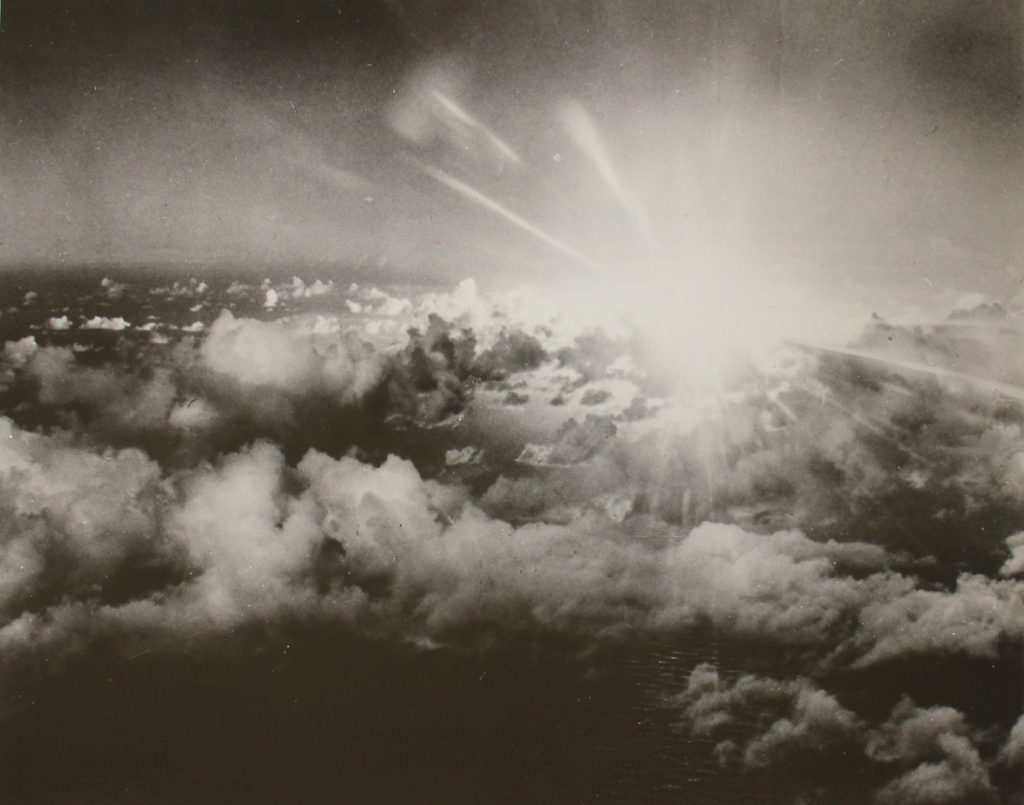
The explosion burst with the intensity of the sun, followed by a sudden temperature increase in the whole area.
The mushroom cloud formed in less than a second with the water condensed by the explosion’s ball of fire at a speed of two hundred miles an hour. Due to nitrous acid and nitrogen oxide, the cloud had a reddish-brown color and reached a diameter of nearly 1,500 yards. At thirty seconds, the cloud was a mile and half in height; growing at a rate of more than 10,000 ft per minute.
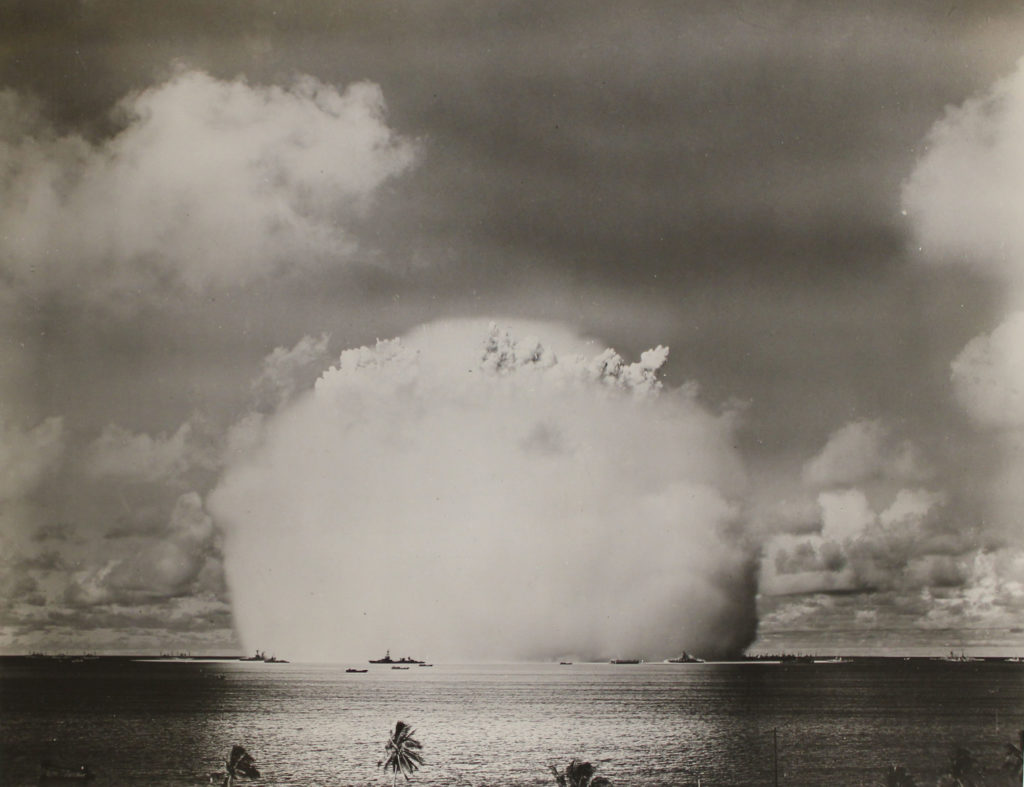
The bomb exploded at 518ft from the ground and 50 yards off the lagoon and near transport ship Gilliam, who disappeared under the explosion. The atoll’s lagoon water level was pushed down by the shock wave, bouncing back and creating another shock wave known as “mach effect”.
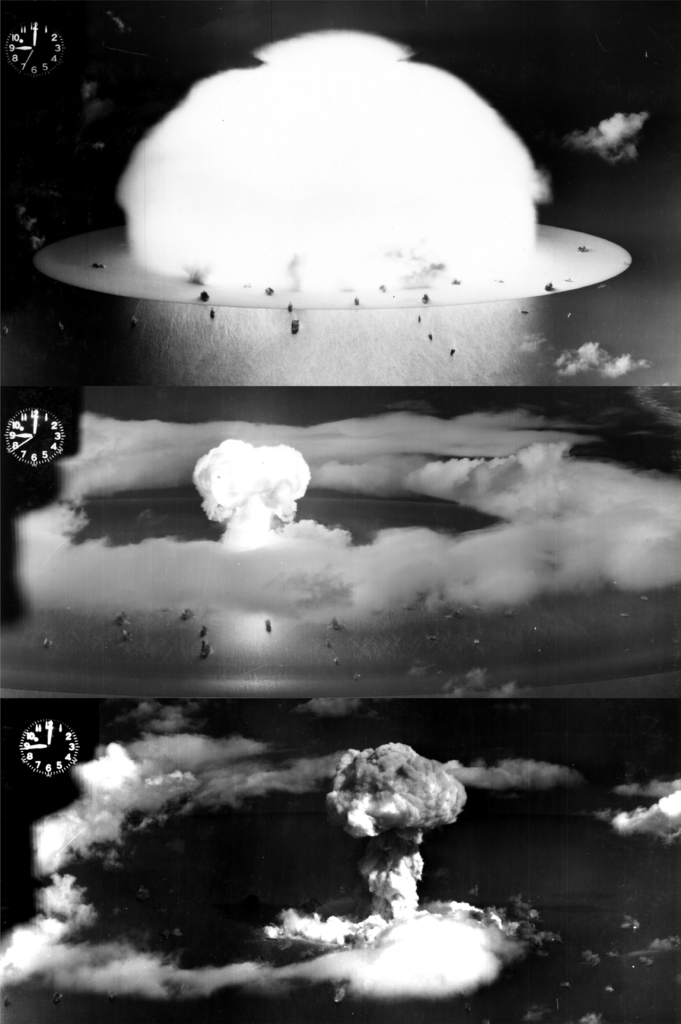
Dave’s dream was able to escape the explosion, nonetheless, yet the crew couldn’t avoid being hit twice by the two shock waves. Only 1.25 seconds after the explosion, the blast waves had reached 1/3 of a mile. After three seconds, the shockwave traveled a mile, reaching 185 ft of altitude and 165 mph winds.
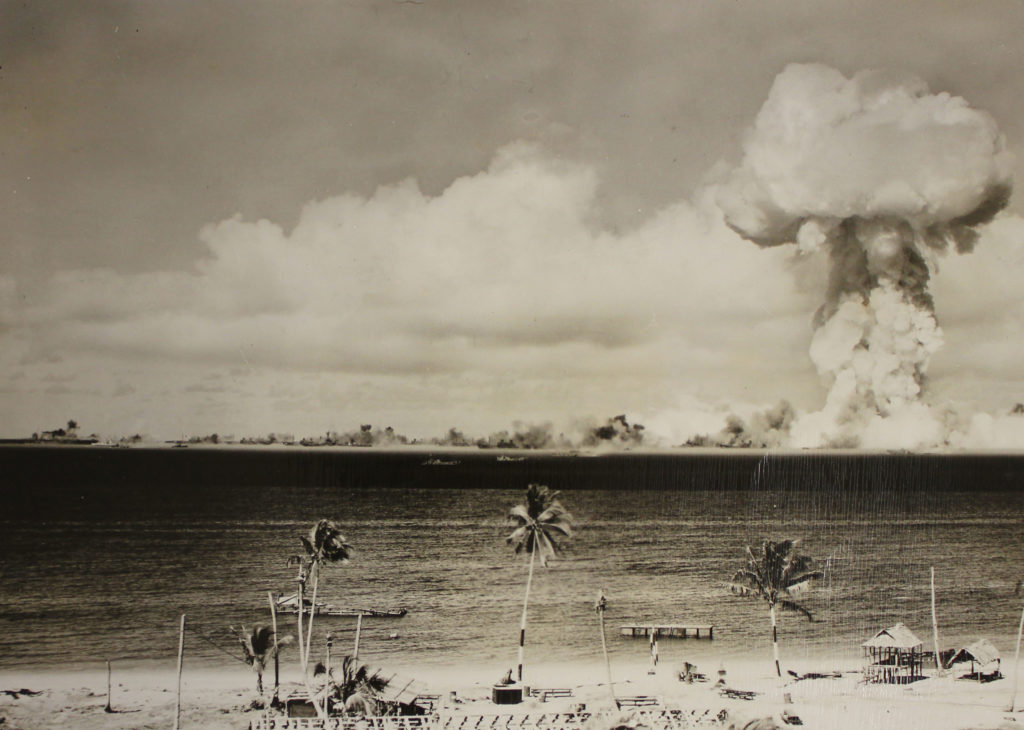
While the upper half of the cloud was calm, the other continued to experiment with the violence of the explosion. It took the blast ten seconds for passing the ships, covering 2,5 miles and decreasing its velocity to 40 m/h, finally slowing down at 35,000ft. The explosion’s fireball generated a stream of neutrons, creating short time radioactivity in the ships and water.
Finally, cooling down after ten minutes, the cloud’s now radioactive water began to rain over Bikini. Radioactive as it was, the ships did not absorb much from it. According to the authorities, this was because radiation had dispersed into the atmosphere in the rain after making it to the ground.
Approaching 10 am the cloud had lost its force and started dissolving into the high altitude winds.
Check the Able detonation here:
Entering the lagoon & Ship Damage
Eight minutes had to pass after the explosion before a set of drones departed from Enewetak along with carrier Shangri-La. They entered into what was left of the mushroom cloud to take samples.
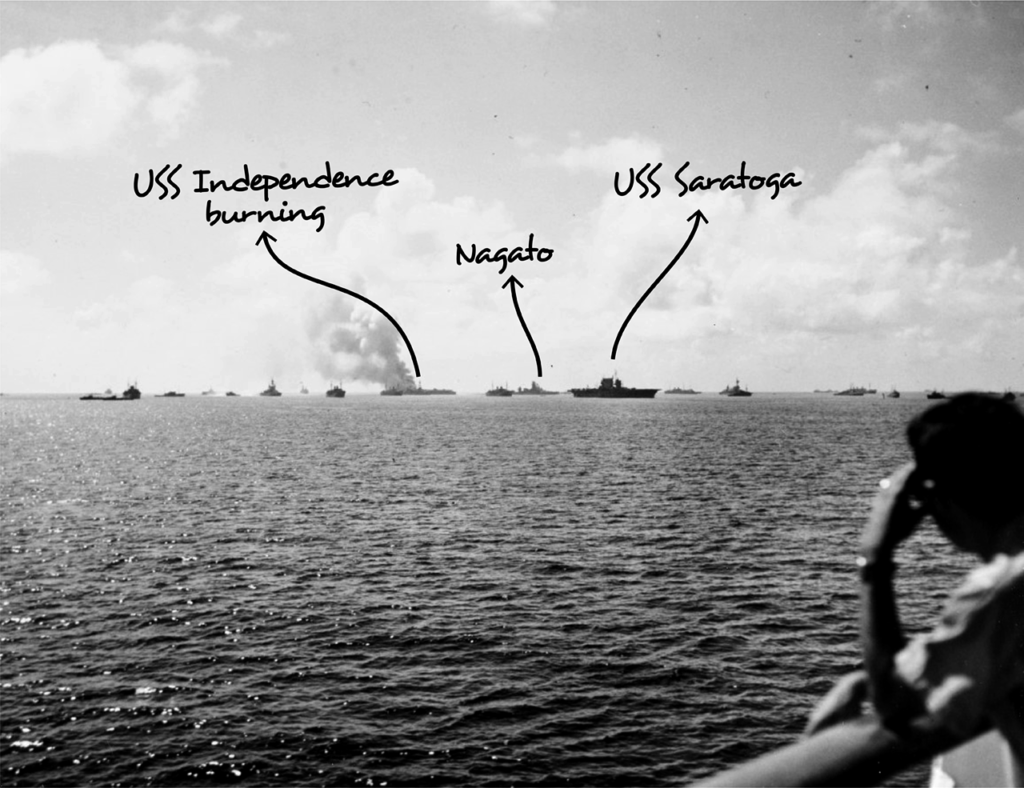
Alongside them, for photographing the boats were four U.S. Navy bombers from carrier Saidor. These controlled drone boats that by taking water samples from Bikini’s lagoon were to determine if it was safe for humans to approach the area.
Two hours after the drop the first humans entered the lagoon by measuring with Geiger counters its levels of radiation as they got closer. As they expected, most of the radiation from fission had gone with the mushroom cloud into the stratosphere. Yet, the support fleet could only enter Bikini’s lagoon by afternoon.
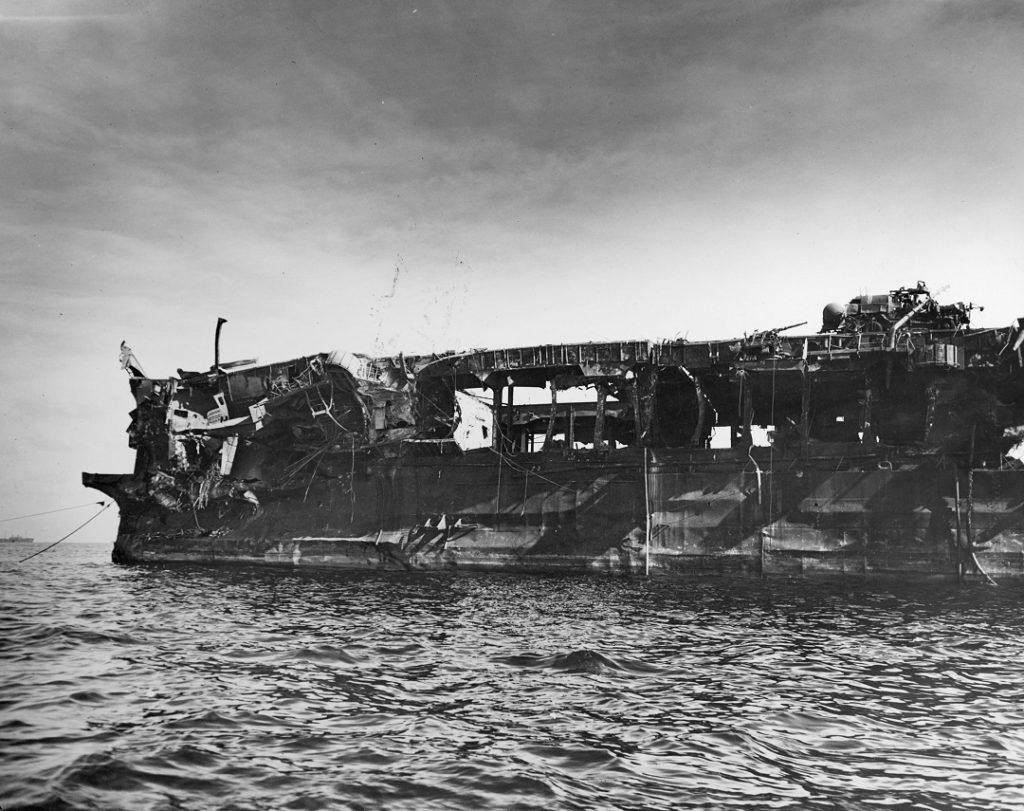
Even though the bomb missed its target by a great deal, they found many severely damaged ships, some of them still on fire. In this sense, close inspections throw that the actual damage had been more serious than at first sight.
A total of five ships were sunk by the explosion. All of them suffered major damages to their superstructure and hull.
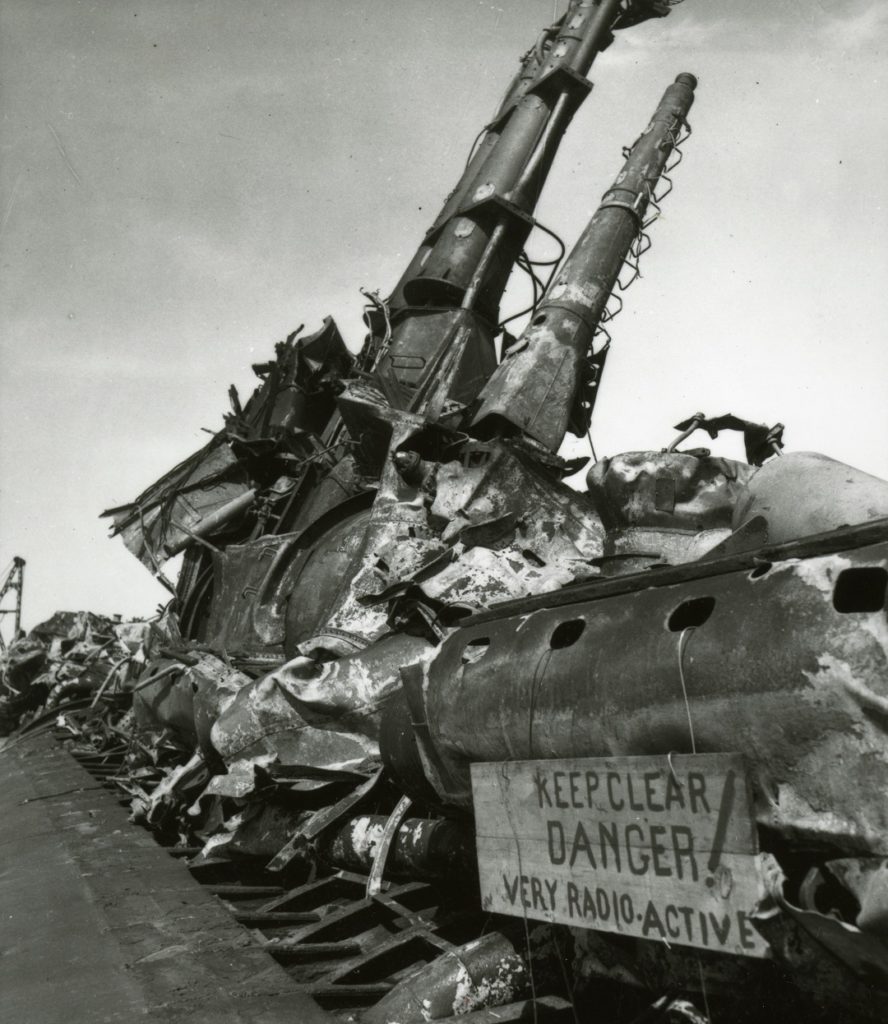
Attack transport Gilliam, 44-foot long and the ship closest to the impact, sank in a minute. The blast destroyed the ship’s superstructure and its metal hull was melted by the explosion heat.
DD-411 338-foot destroyer Anderson, for its part, sank in eight minutes. Like Gilliam, its superstructure was twisted by the explosion.
Japanese light cruiser Sakawa burned for twenty-four hours before sinking. Attack transport Carlisle sank in forty minutes.
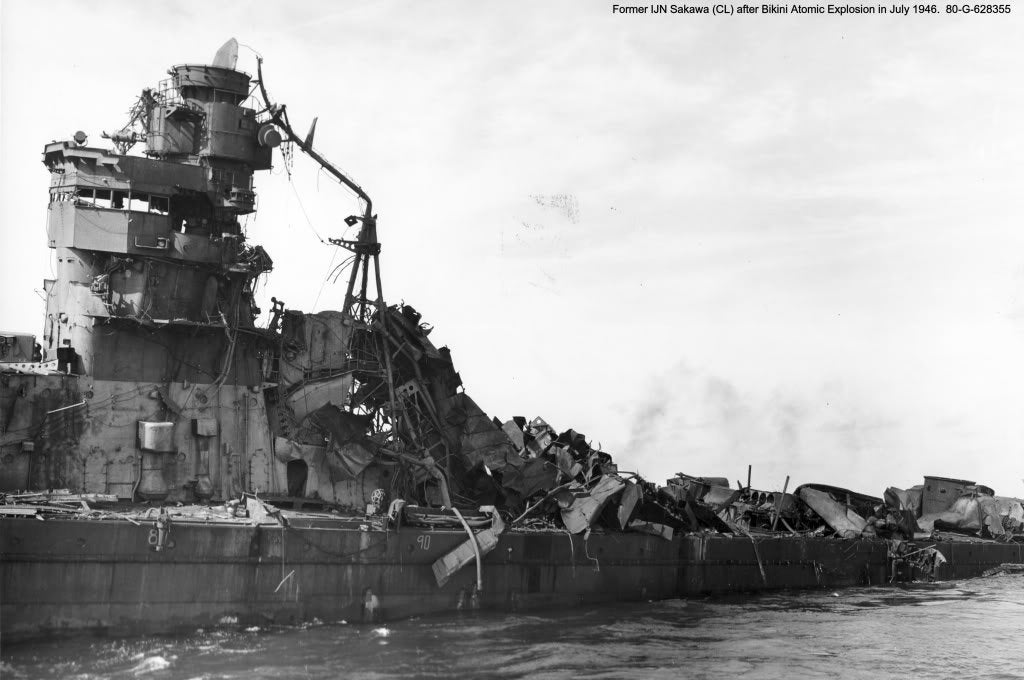
Lastly, it took destroyer Lamson, half a mile from the explosion, eight hours to go underwater. According to a diver’s inspection, the ship’s hull suffered a great deal of damaged.
All the while, those near ships that didn’t sink still suffered a great deal of damage.
Light carrier Independence had its 600 ft deck destroyed and even partially blown off in the corner facing the explosion. Its mast and funnels were also destroyed, along with its interior. The ship continued to burn even after night came.
Still-floating submarine Stake, half a mile from the explosion, had its superstructure wrecked. On a similar distance, battleship Arkansas, a heavily armored ship, was damaged enough to become unrepairable.
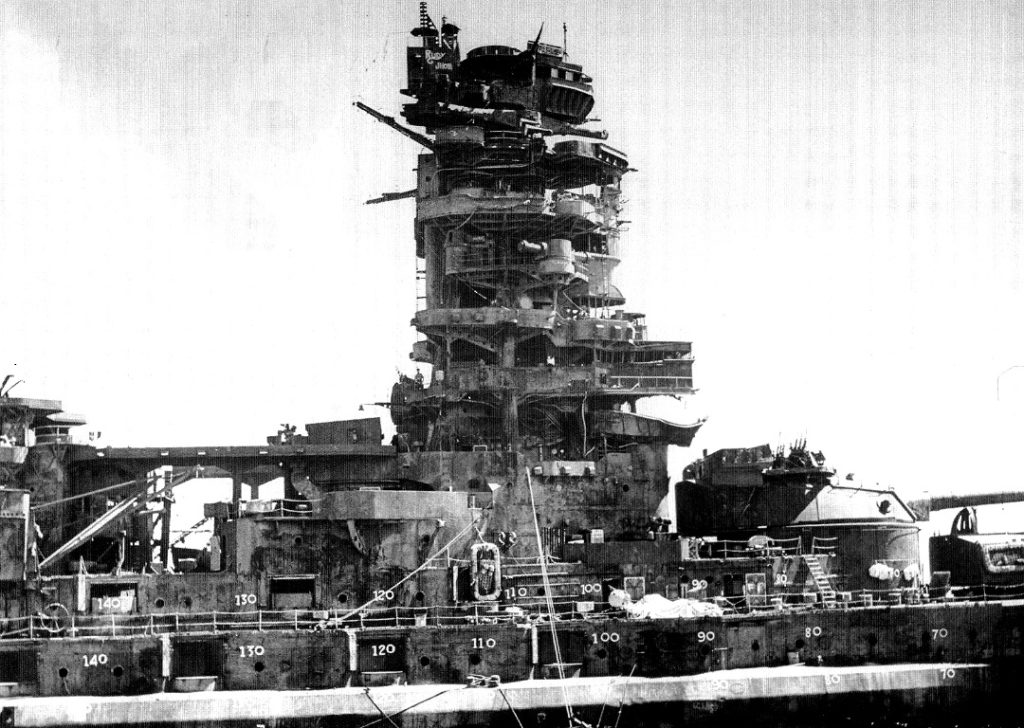
Nagato, 400 yards away from missed target ship Nevada, only suffered moderate damage. Merely the lightest plating layers of its superstructure were affected while only its weakest doors were blown. Aside from that, its paint was scorched.
The recognition team also found Nagato’s wood deck burning slowly but concluded that overall the ship structure was in good shape. Before the test, the ship had had little to no maintenance; its engineering plant had been idle for around a year.
Disappointment
But despite all the preparation and numerous factors considered, the bomber missed its target, and by a great margin. The bomb exploded 2,130ft away from Nevada.
On the other hand, while the New York Times described the blast as “ten times as bright as the sun”, most reviews were not as positive. All things considered, the nuclear bomb was a new thing, almost a myth, reaching levels of hype that proved hard to satisfy when the time came.
Ships were not blown away into the air by the explosion, nor were all immediately sink. As the U.S. Navy later clarified, most military ships would only sink if their hulls suffer great damage. Yet, the blast of the explosion was not capable of all that, generating doubts on the bomb’s effectiveness.
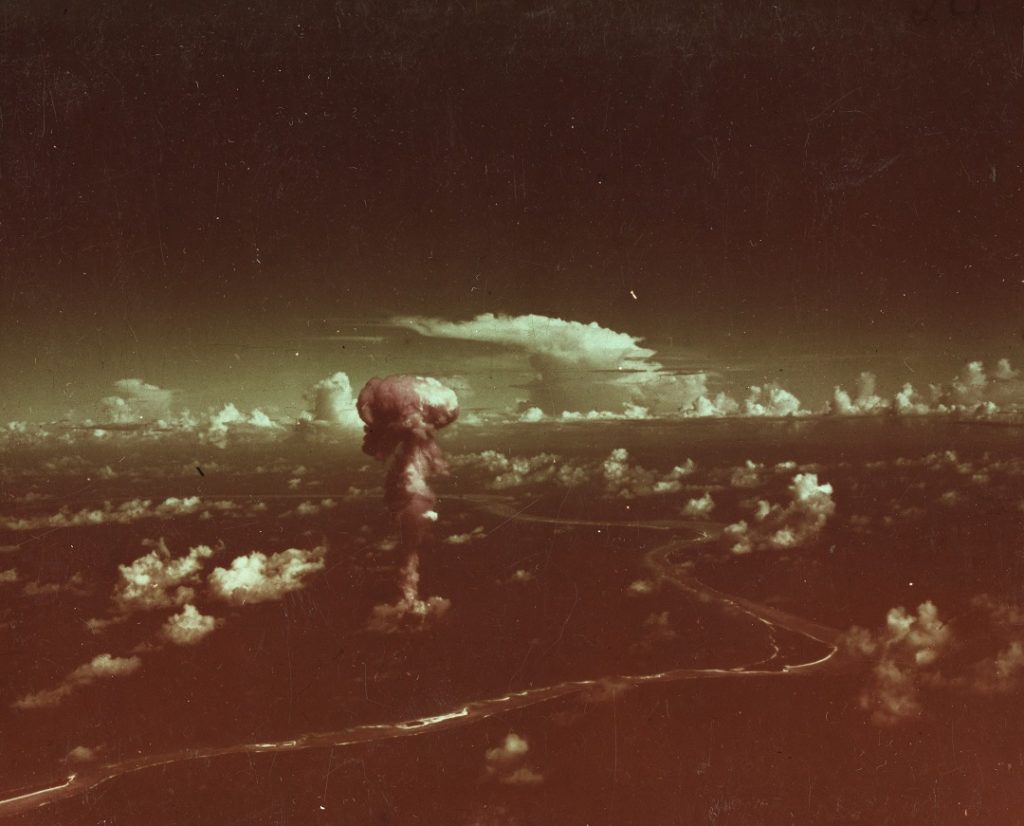
Goggles provided by the army for watching the explosion didn’t help either. They were too dark for allowing a satisfactory vision.
Observers were also pretty far away from the blast to have a fair view of it. Plus, they didn’t experience much of its shock wave nor heat. The explosion’s thunder-like sound was there but was a rather distant low pitch noise only audible a minute and a half after the explosion.
One way or the other, most observers’ expectations were not met.
We should also acknowledge that Test Able‘s common comparison was the nuclear drop at Alamogordo, New Mexico. On that occasion, the explosion was much more spectacular for those who witnessed it. The ground trembled so much that a scientist was even thrown to the ground by it.
Observers also experienced a wave of air followed by a clap of thunder as loud as the firing of near artillery. Likewise, its intense light made some observers as far as 20 miles to suffer from partial temporary blindness.
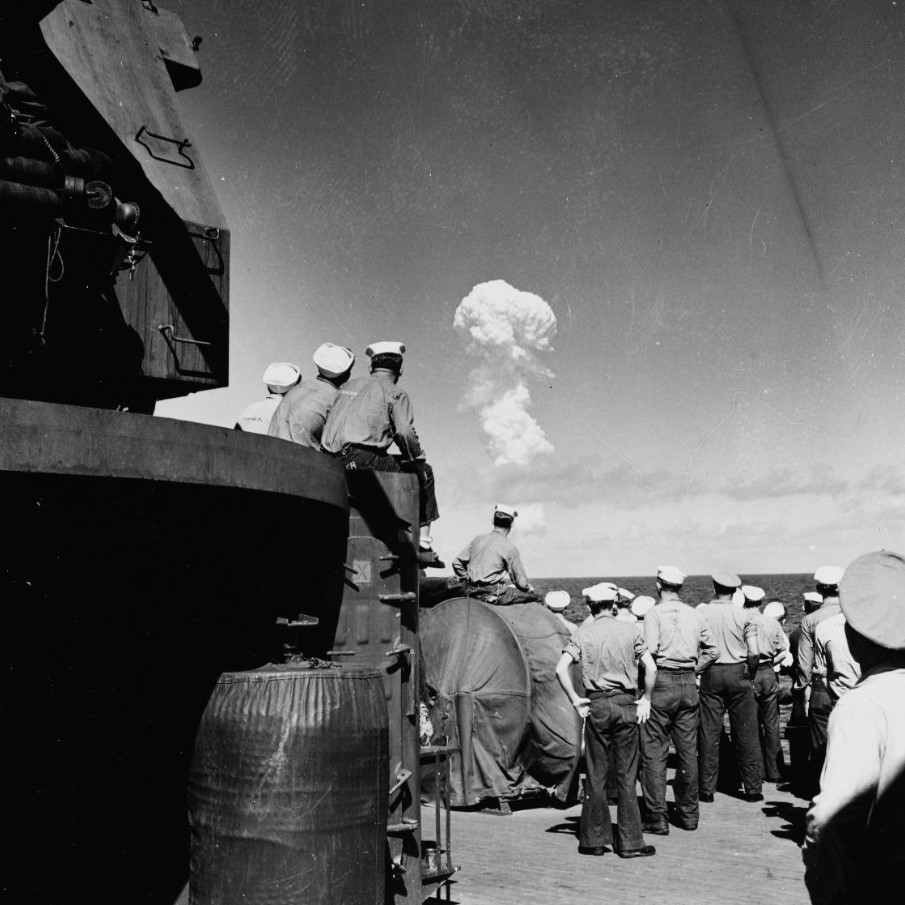
However, at Alamogordo, the observing post was only six miles away from the nuclear drop. At Bikini, no one was closer than 15 miles, a distance in which, despite persisting, the wave and light had no such effect on spectators. Plus, contrary to the desert weather, the Pacific humidity of Bikini took care of absorbing a great deal of the heat and light of the explosion.
At the same time, Bikini’s explosion took place in broad daylight, while Alamogordo happened during morning twilight. A small detail, yet relevant for the dramatic effect and power of the explosion’s light.
But contrary to previous tests, this one had huge public attention, leading to many far-fetched speculations. A Yale physicist assured that the explosion would provoke a hole in the ocean floor. Water would enter in contact with molten rock, resulting in a catastrophic explosion.
Likewise, a Johns Hopkins’ seismologist assured that the explosion would provoke earthquakes. These and its tsunamis would be responsible for taking down all ships rather than the explosion itself.
Newspapers were not behind in speculation. They shared these apocalyptic views going as far as hypothesizing a climate change from the test.
But as we have seen, despite the destructive power of the bomb such expectations were not met. This was the impression even the invited Soviet observers had. They expressed their disappointment with the bomb at seeing ships surviving the explosion.
Animals
Regarding animals, Blandy announced that a mere 10 percent of them died in the explosion. Among them were three rats born at Pennsylvania before the test.
However, the Chicago Tribune called this statement misleading. They corrected Blandy by addressing that many animals were deadly wounded, something he omitted.
In July, an army officer who had visited Burleson, the ship where most animals were on board during the test, granted a few words on the matter. He said that these animals were “dying like flies”. During his visit, he saw how blasted animals that looked healthy were actually dying on a daily basis.
Answering if these animals would travel to the U.S. for further studies, the officer replied that there were scarcely any animals left. By the time, a quarter of the animals had died, adding to the 18% who died at the blast. Thirty-five percent were dead by late September.
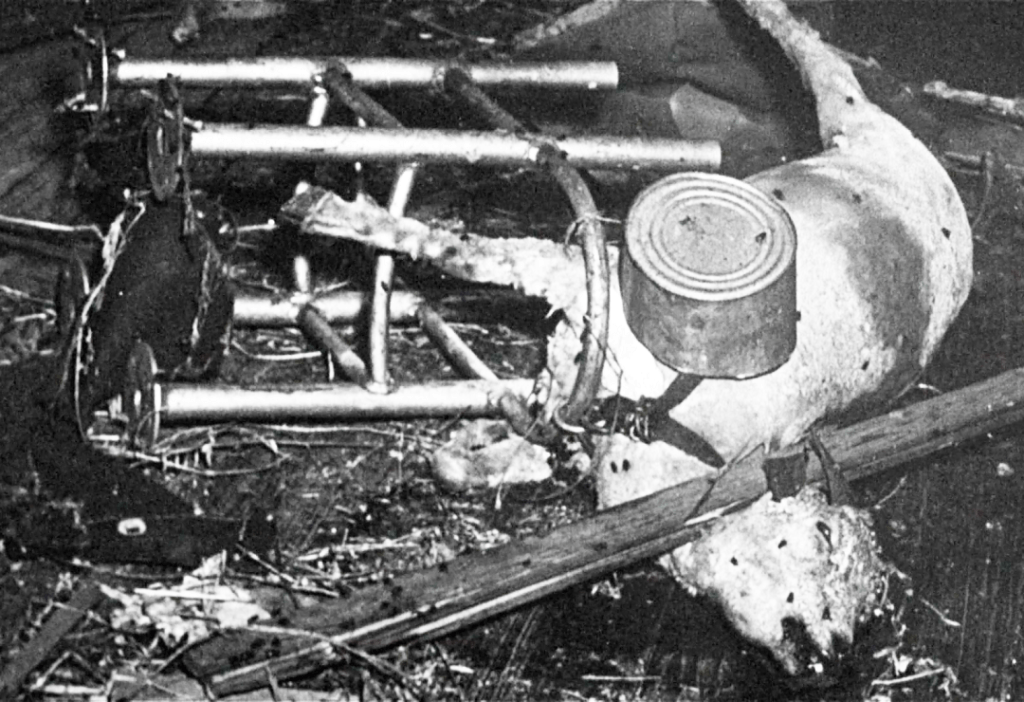
According to the data gathered on that date, the air blast killed 10% of them, while 15% died due to radioactivity. Another 10% was sacrificed for scientific study. Five months after the test, more than half of them were dead.
The airblast was not only instantaneously lethal but also prolongedly harmful for those who survive its impact. From contusions to lung hemorrhages. Also, a great deal of them showed lower blood counts as days passed.
The explosion’s flash produced thermal radiation burns and blinded those who directly saw it. Gamma radiation damage, for its part, took more time to be noticeable. Its effects included hyperirritability, muscular weakness, diarrhea, and tachypnea.
These effects shown in different grades, with some animals in worst conditions than others. Some could not even stand.
However, according to the scientist, there was no evidence that these symptoms caused intense pain to them.
Results
Officials were not happy with the results and Dave’s Dream’s crew had to respond for them.
On the other hand, the day after the test at the army news conference, Blandy did not throw away any conclusions. Likewise, he avoided acknowledging the hype. Instead, he affirmed that his role was to communicate the results to both the Presidential and Joint Chiefs evaluation boards.
Still, Blandy stated that Skate’s damage to its superstructure was but a mere dimple. He assured reporters that the bombing did not affect the inside of the ship. Plus, he hinted that Independence had been more damaged by kamikazes than by the nuclear bomb.
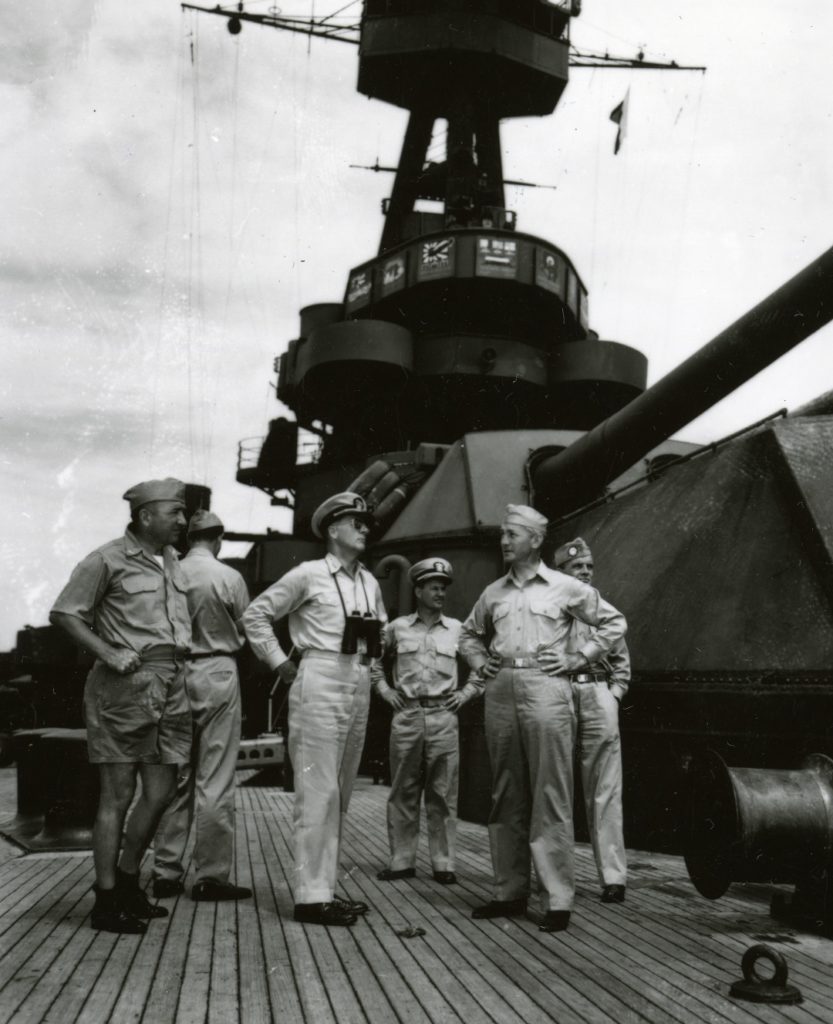
Blandy also clarified that his naval float was not compromised and that they had several newer ships for supplanting the destroyed ones.
In turn, the U.S. Air Force declared Test Able and its destructive power as successful. Ramey himself stated that in a real-world scenario the whole fleet would have been destroyed. He emphasized the success of the test and the role of his institution on it.
While the U.S. Navy mentioned that only five ships were sunk, Ramey stressed out that a total of sixteen ships were completely put out of combat. At the same time, nearly thirty were damaged and eleven more had they boilers compromised to the point of being unable to maneuver.

Former members of the Manhattan Project had their own vision as well. They were closer to Ramey’s and considered the U.S. Navy’s point of view as far-fetched. After inspecting the site, they figured out that Blandy had understated how bad the condition of the ship was to favor the power of the U.S. Navy.
Indeed, not all ships were sunk by the explosion. Yet, their deck materials became completely inoperable. Mistakenly, the fact that the ships were still floating didn’t mean that they had avoided fatal damage.
Atomic scientists knew those general expectations wouldn’t be met. Only by the second test more objective perspectives of the explosion’s power would reach the general audience.
More bombs to come
Able was the first of 23 nuclear tests carried out between 1946 and 1958 on Bikini, of a total of 67 tests in the Marshall Islands. The most highly publicized of the Bikini tests, nicknamed “Bravo”, involved the detonation of a 15 megaton hydrogen bomb. The total megaton yield from these 23 tests was 42 megatons.
Able’s Infographic
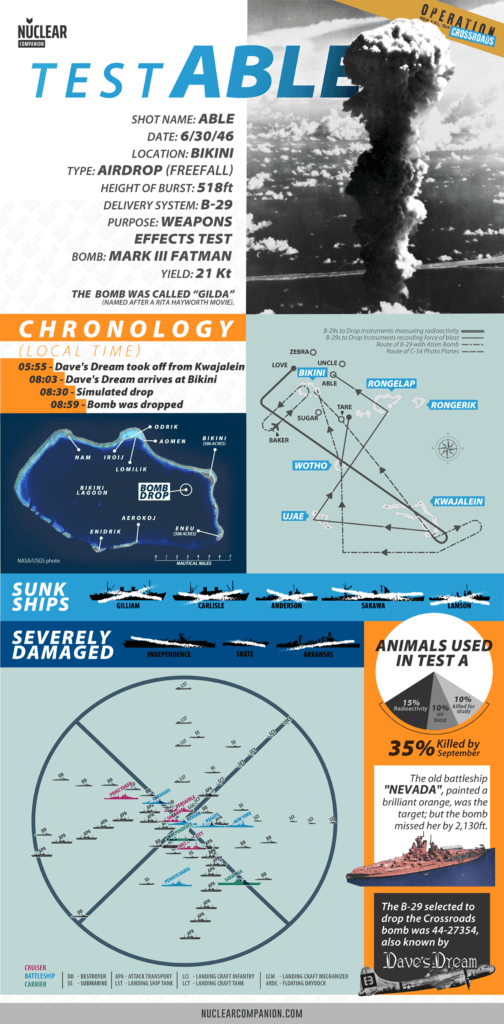
ABLE investigation
Right after the test, General Kepner congratulated task groups 1.5 and 1.6, those in charge of the dropping and its recording, for their work. He refers to Test Able as one of the most important operations in military history.
However, there was still the issue of the bomb missing its target.
The crew was the best the U.S. Air Force could offer, no doubt about that, and had proved so only after a long and meticulous selection process. Yet the final dropping was worse than all those made during practice.
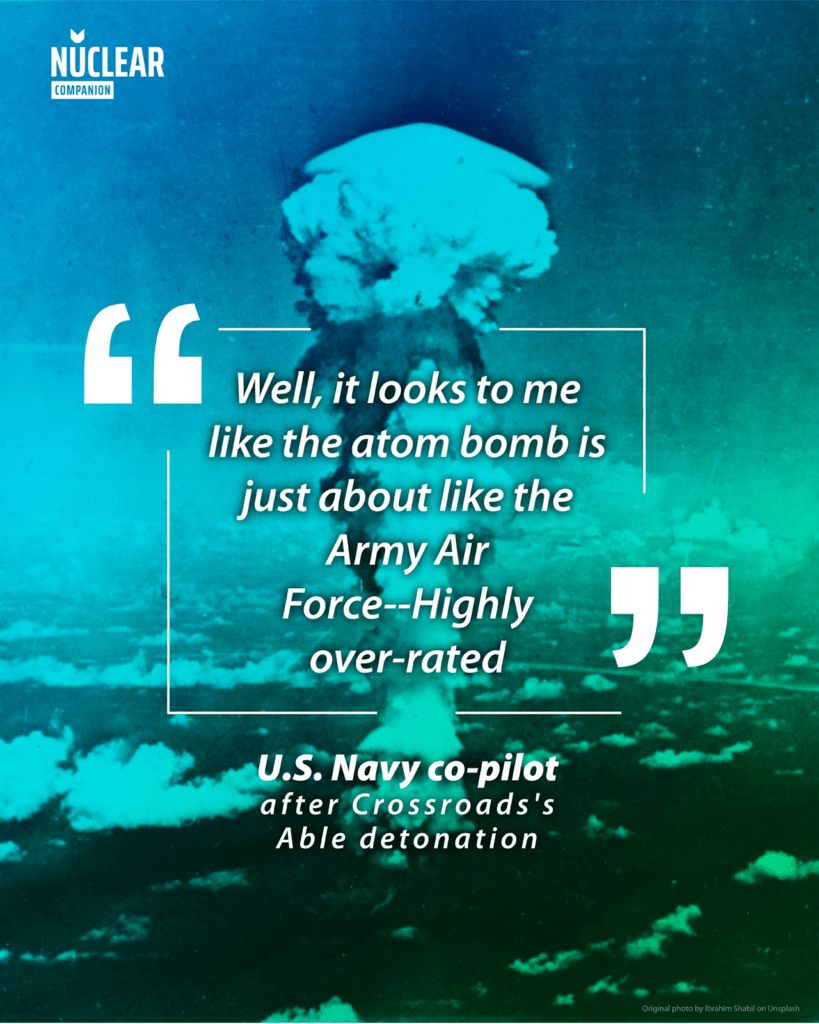
How, then, can be explained that the bomb missed by half a mile?
At the same time, failing the target itself was not as big of a deal. The real problem was that the bomb ended up exploding near most of the ships with the equipment for collecting the explosion’s data. The instruments that the bomb didn’t destroy were left nonetheless in bad condition.
Gaining new insight on the bomb and its consequences was the whole point of the test. As such, it was hard to call it a successful operation.
In this way, the failure was big enough for the army to start looking for the responsible. Yet, this task was not easy at all.
The Power Report
At Kwajalein, as soon as July 4 colonels Preston and Dorfman started the investigation to get to the bottom of what went wrong. By order of General Kepner, they were to help Lt Gen Power on his official investigation.
By order of Kepner, Proston and Dorfman got their hands on Dave’s Dream and collect its flight data and settings. After that, they retrieved all the photographic record from the other planes behind the bomber during the test. They also had to find the precise altitude of the plane during the bombing flight.
Since the beginning, Kepner had been suspicious of the fins and baffles of the bomb as responsible for the failure. He encouraged analysts to be extra judicious of the bomb itself. As such, investigators also took the bomb’s physical properties such as its weight into consideration.
Every detail was to be covered, so they checked the inspection procedures it had gone through before the test and the bombsight as well. Yet, they found nothing explicitly wrong; all had been in its place.
Col. Sutherland ordered the film of the dropping to be closely examined. He considered that it could show an abnormal movement from the bomb after it was dropped.
But this wasn’t useful either, nor were the interviews the whole crew gave.
Power collected all the investigation info and reported it to Kepner on July 11. According to Power, the few minor errors found were an inevitable part of any dropping of that type and cannot be accountable for such a big error.
As such, Power limited the possible errors to just two possibilities:
- A problem with the bombsight that ended up messing with the bombardier’s location sense.
- A problem with the bomb itself not following its computer-traced trajectory.
He concluded his report to Kepner with four recommendations for working over these two hypotheses:
- To gather all photographs of Dave’s Dream’s flight position for a detailed study:
- To have photography professionals determine the exact position of Dave’s Dream when the bombing occurred.
- Dave’s Dream and its crew were to make new bombing attempts with the same equipment. The bombsight would be double-checked remotely.
- Lastly, Preston and Dorfman were to return to the U.S. to continue the investigation from there.
Thereby, they were to focus on the graphic material from the explosion for determining what actually happened.
There were many pictures to work with. Dave’s Dream took vertical photographs with its K-17 aerial camera and radarscope photos with its radar score. Plus, there was the filming record and still photos of the F-13 behind the bomber.
The Preston-Dorfman Report
Kepner communicated to Chief of the Air Force Gen. Spaats Power’s report on July 11. Kepner was not satisfied with how inconclusive the investigation was and understood that it could only continue in the U.S.
He sent Preston and Dorfman back to the mainland U.S. the next day and asked for the full cooperation of the Manhattan District on the investigation. At headquarters in Fairfield, California, they found full support of the U.S. Air Force. There, they talked with LeMay, who help them with locating the pictures they needed to work with.
In aiding them, LeMay also chose bomb expert and World War II veteran Col. Montgomery to be at their service. After going to St. Louis first and Washington later, the three of them had all the graphic material they needed.
Shortly after, the Aeronautical Chart Service started to analyze the photos. Especially, the vertical photographs were taken by Dave’s Dream and those trimetrogon photos from the F-13 behind the bomber.
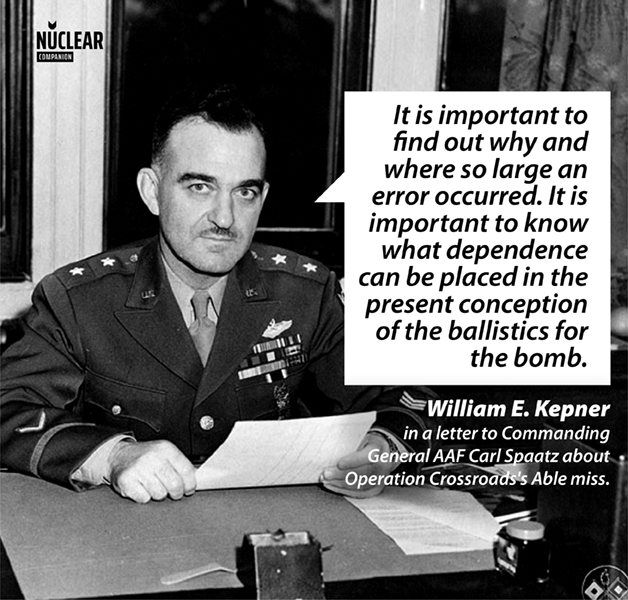
Meanwhile, Dave’s Dream had already returned to the U.S. for repeating the bombing in Sardia Bombing Range. On this occasion, the dropping had good results: only 220 feet of error. They did so with the same bombsight and stabilizer used in Test Able.
After tracking all the material, Montgomery, Preston, and Dorfman had to attend many scientific meetings. They met with multiple specialists and get their hands on every report written on the matter.
But despite the rugosity with which all the information was gathered and presented, there was no patron or specific fault shown.
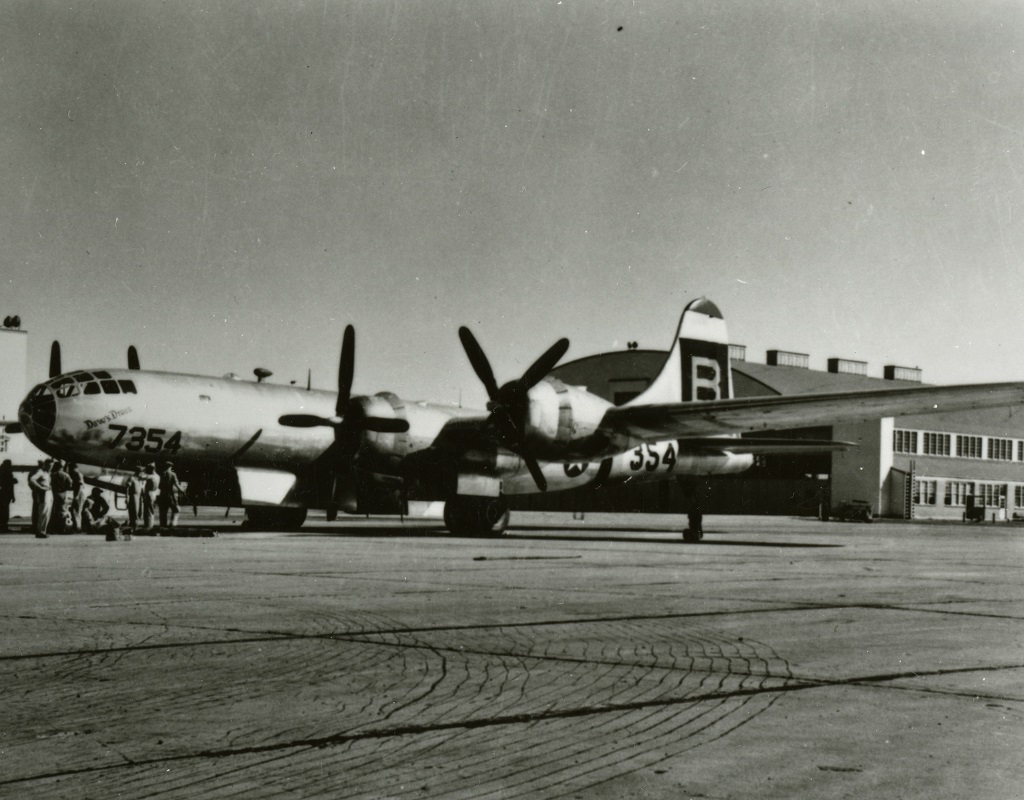
Some of their conclusions even contradicted one with the other. On July 25 Preston and Montgomery started working with some enlarged photos of the bomb’s flight. And while Montgomery found “definitive eccentricities” in them, Preston did not.
On Aug. 9 Dorfman, Col. Butler, and Feltman of the Ordnance Dept. watched the movies. Dorfman saw in them something wrong with the bomb. And while some challenged his conclusion, there was indeed a present irregularity in the flight path.
As such, despite no proper explanation could be made, the strongest hypothesis was that the bomb was affected in a way that made it veer off.
Nonetheless, given the poor quality of the images, these couldn’t be considered conclusive proof.
Aberdeen Study
The Preston-Dorfman report was not conclusive enough and was fairly questioned. Most critics pointed out that the report didn’t consider the aircraft’s position in their calculations.
Despite Power’s recommendation, the bomber’s location at the time of the dropping couldn’t be determined. The new investigation, in charge of Aberdeen Proving Ground, had this knowledge as its top priority.
The National Bureau of Standards and the Navy Photographic Intelligence also took part. They made a study on the lens distortion in Dave’s Dream’s camera for obtaining the exact position.
From Nov. 1946 to Jan. 23, 1947, the Aberdeen Bombing Mission made a number of tests at Muroc Army Air Base. They used Fat Man model bombs, dropping them from 30,000 feet. They wanted to find the average deflection of the bomb when dropped.
The data from all these studies was compared with the bombardier’s datasheet.
By Mar., the Aberdeen Study concluded that the deflection error could indeed be attributed to the bomb. Yet, it could also have arisen from an off-course track of the aircraft prior to the drop. Or both. Yet, it was clear that an error so great could not be on the crew’s fault but the bomb’s.
In fact, the study didn’t find evidence on whether or not the aircraft was off its track at the time of the dropping. In this way, the crew was left out of any responsibility.
Conclusion
One way or the other, the Aberdeen Study didn’t disprove the previous investigation. Moreover, it backed up the theory that the problem had been with the bomb.
Still, the U.S. Air Force was disappointed. The results were not conclusive enough, and the U.S. Air Force couldn’t help the lasting damage to its reputation.
As a side note, despite there was not an official and conclusive explanation for the error Paul Tibbets also had his word on the matter.
Tibbets was indeed still disappointed in having lost in the competition for becoming the bombing’s crew when he called it the “fiasco at Bikini”. According to him, he and the rest of his crew went the day of the test to Kwajalein. They checked the wind speed and direction for making their own calculations.
Tibbets‘ calculations were significantly different from those made by the bombing crew. After doing the calculations, he approached Wood, the bombardier in the test, and Swancutt. According to Tibbets, both ignored his data.
Likewise, Tibbets also made his own calculations with Swancutt’s crew climate measures, those used in the failed drop. According to him, with these numbers, he predicted the bomb miss with less than 200 feet accuracy.
Baker
Preparations for Test Baker
With Test Baker in mind, Blandy began arraying the target fleet around the new bomb’s location: latitude N11°35’05” and longitude E165°30’30”.
The more, the merrier: A total of sixty-six ships were to take part in the test, with twenty-four small craft beached on Bikini Island. Among them were those that survived Able’s explosion.
There were also eight submarines. These scattered underwater at different points and depths.
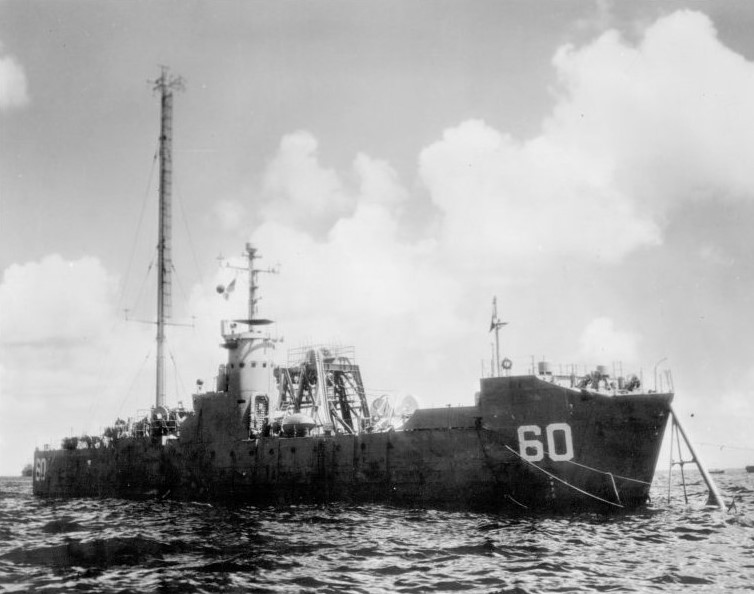
The major targets featuring in Baker were carrier Saratoga and battleship Arkansas. Blandy specifically arrayed these capital ships, among the largest in the U.S. fleet, near the detonation place.
Still, the ship closest to the explosion was USS LSM-60. The U.S Navy redesigned this ship for lowering the bomb, nicknamed “Helen of Bikini”, through a centralized well.
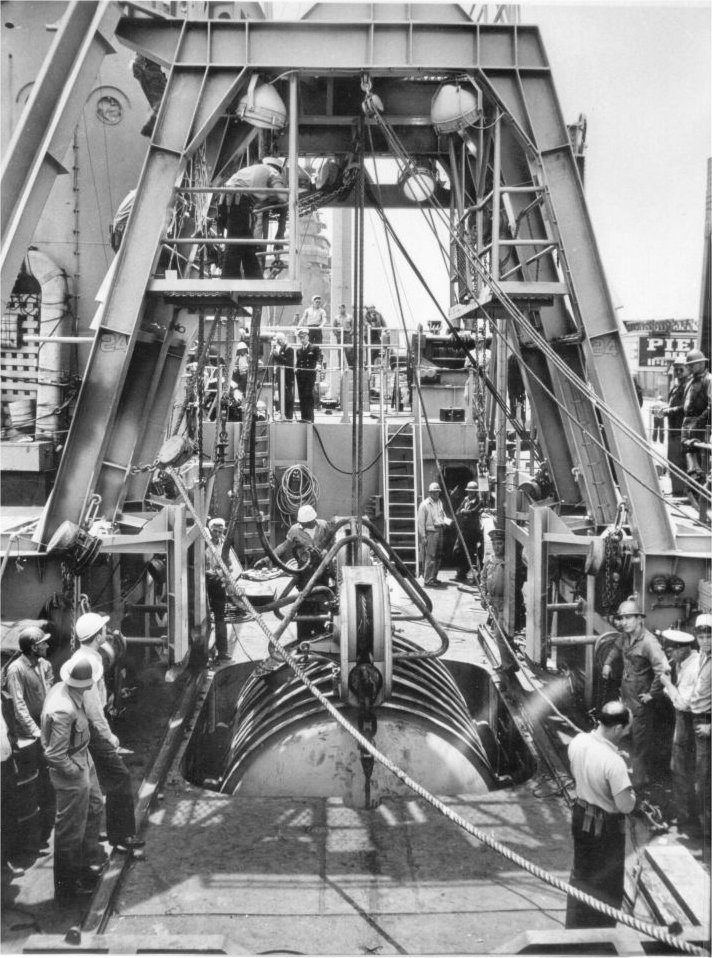
The bomb connected to the ship through wires, electrical cables, and a coaxial umbilical cable for the detonation signal. In this regard, LSM-60 had an antenna mast installed for receiving radio signals.
The bomb itself lodged inside a watertight steel caisson suspended 90 ft below the water surface. R. S. Warner Jr. was in charge of arranging the bomb inside the caisson.
The caisson, manufactured in Apr. 1946 in Los Alamos. In this regard, it had “Made in New Mexico” written on its side, as state senator Carl Hatch, who was observing the test, asked. In building the caisson, the U.S. Navy recycled the conning tower of the former USS Salmon (SS-182).
The Explosion
Surprisingly, among the observers was the former monarch of Bikini King Juda. Blandy himself invited him without much faith in his attendance. Still, Juda arrived at Bikini two days before the test in Commodore Wyatt’s seaplane and was pleasantly welcomed by the U.S. Navy officials.
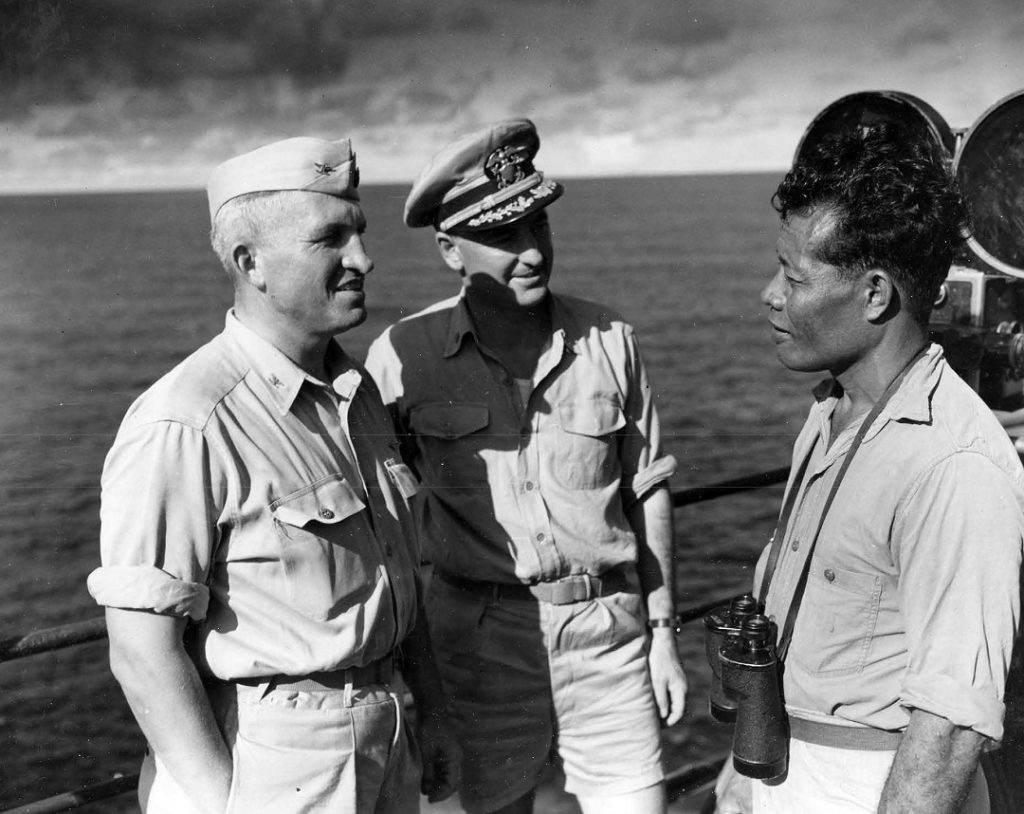
On Baker’s day, Juda, now regent of Rongerik, observed the explosion from Mt. McKinley, Blandy’s flagship.
On Jul. 25 at 5:45 a.m., the Task Group 1.1 personnel left LSM-60 after arming the bomb for the beginning of the test.
The underwater explosion took place at 8:34 a.m., followed by an intense orange fireball emerging from the water and engulfing LSM-60.
The explosion’s shockwave broke the sound barrier, reaching a speed of 761 mph. The immense energy of the shockwave made a crater on the lagoon’s floor as deep as 200 ft and 700 yards wide.
The heat condensed the humid in the air into what’s known as a Wilson cloud. Initially, this cloud covered the water column but shortly vanished.
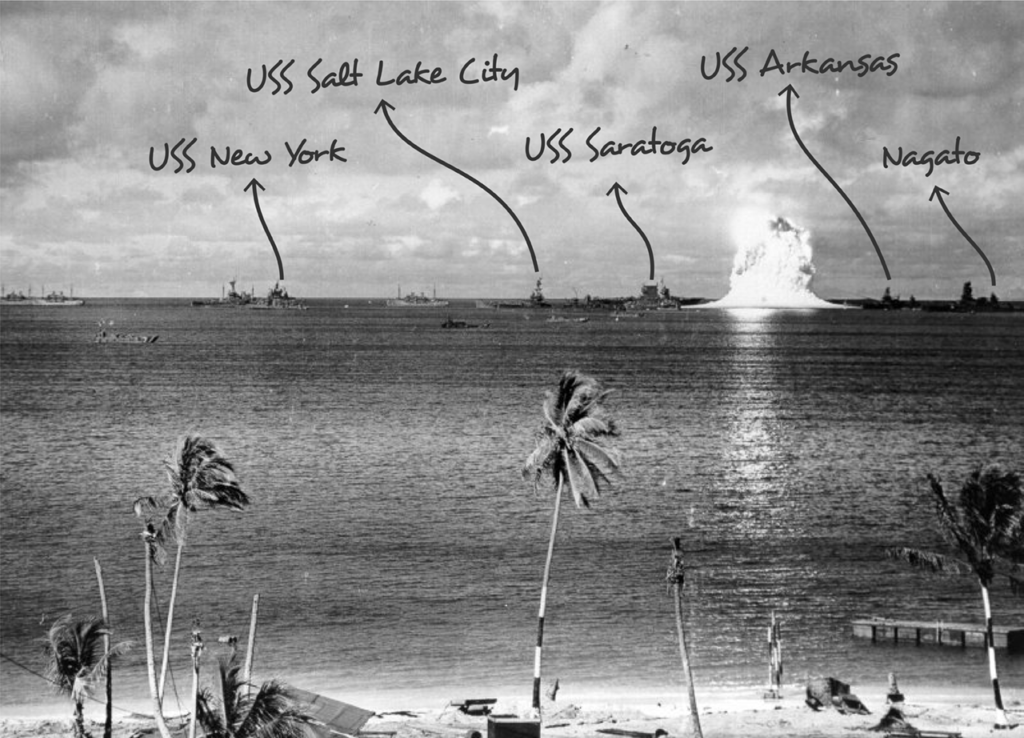
The fireball’s hot gas shortly began to rise, and the water geyser started to transform into an atomic cloud. The cloud made its way to the sky at a top speed of 2,500 fps until reaching 10,000 ft of height before leveling off.
The watersides of the explosion were 300 ft wide and formed slower than the 975 ft wide cloud’s column at its center. In only four seconds the column elevated 4,100 ft; two seconds later, it reached 7,600 ft, sizing more than a mile on its final height.
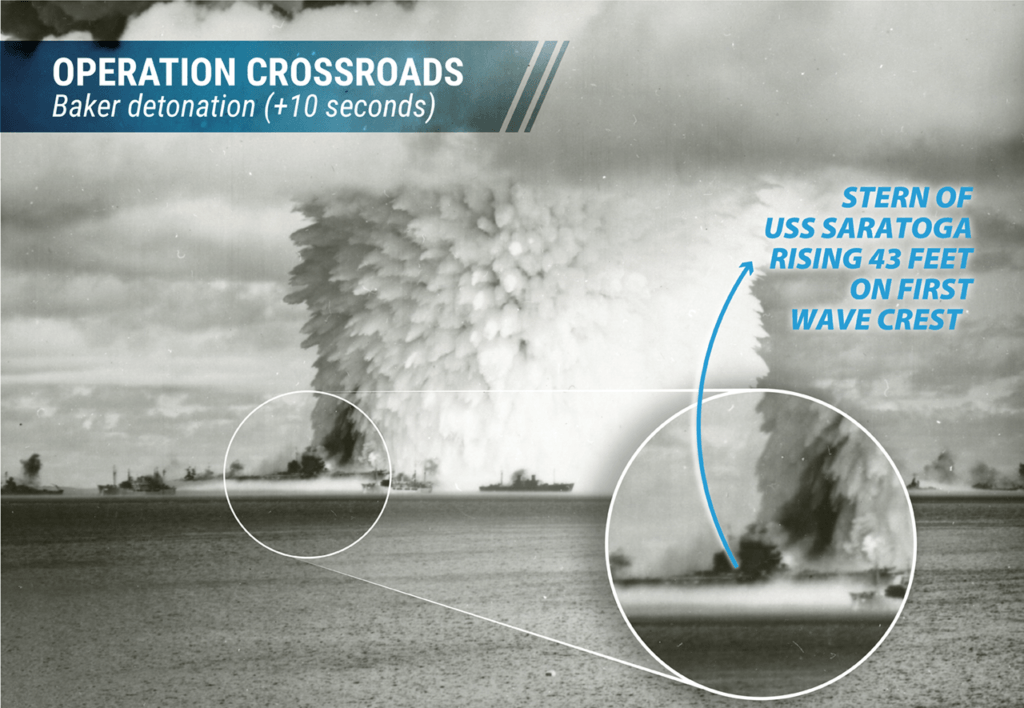
The column acted as a chimney for the explosion’s gases, vaporized water, radioactive materials, and debris, reaching top speeds of 11,000 fps. These ingredients made the cloud’s top resemble a cauliflower rather than a mushroom.
Compared to Test Able’s, Baker’s cloud was fairly darker. At the same time, it wasn’t as big since the water tanked much of the explosion.
Spectators noticed a smoking black object inside the cloud. While many thought it was one of the drones engulfed by the explosion, according to Blandy it was the remainings of LSM-60.
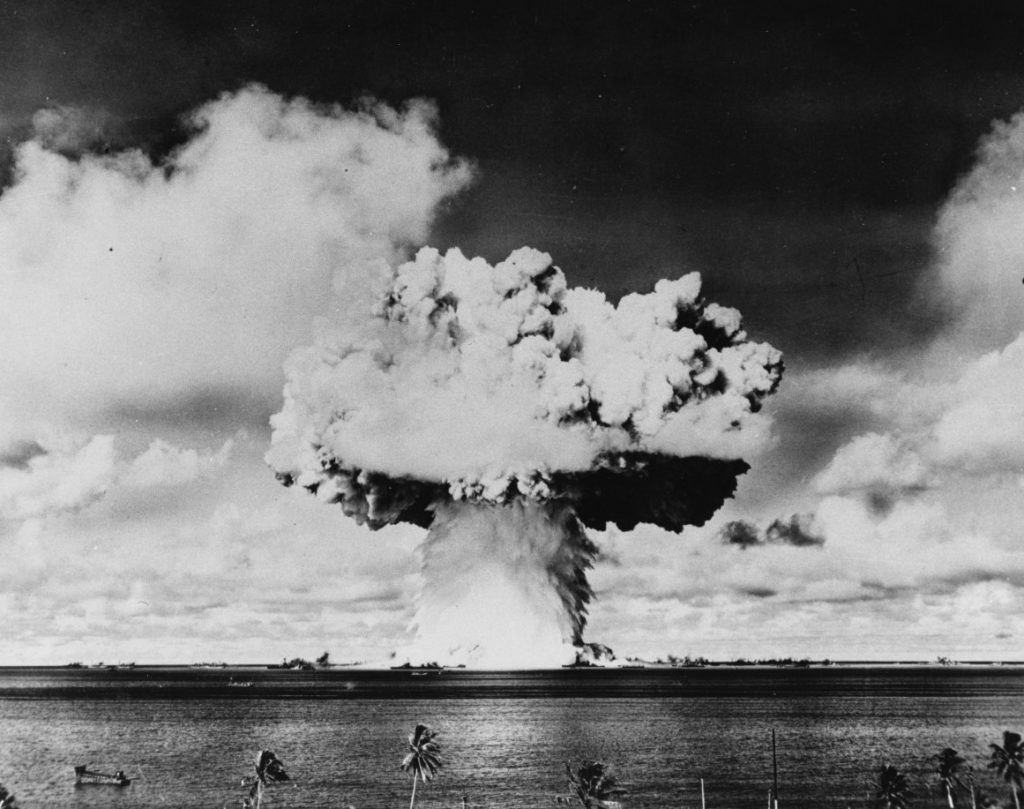
Only eleven seconds after the detonation, the lagoon water covered the space open by the explosion. Soon enough, the zone transformed into a mounding mass.
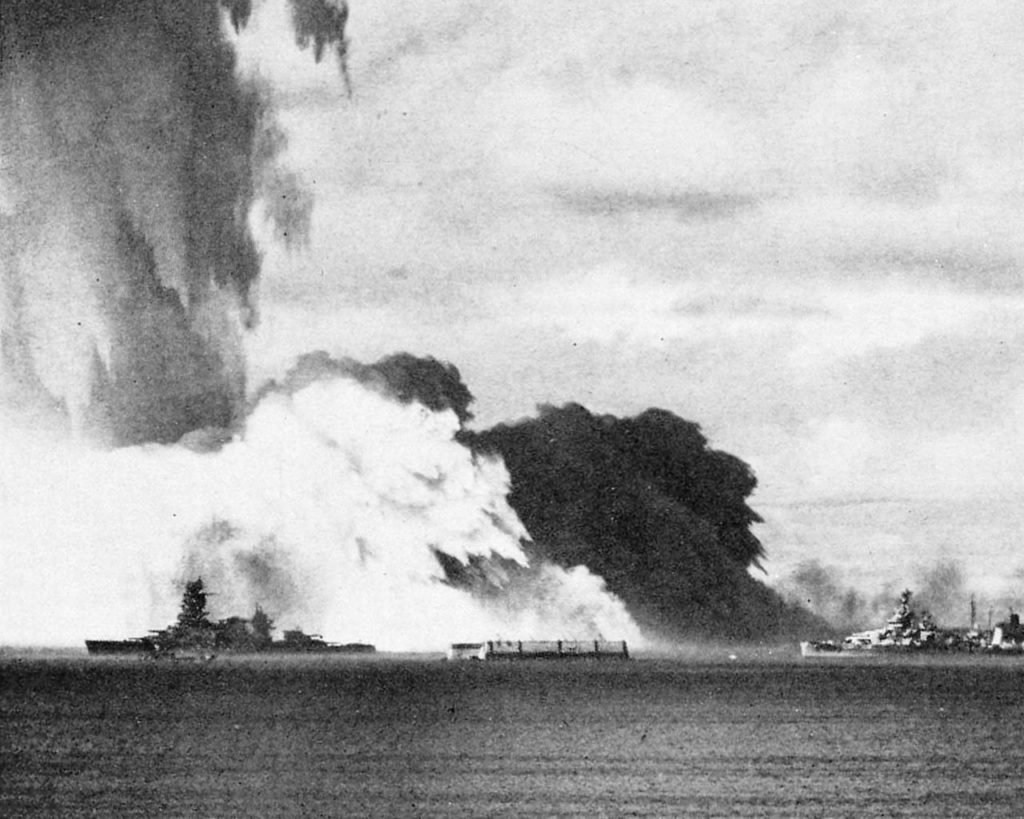
Tsunami waves followed, being the first one 94 ft tall. Yet, by the moment it reached Bikini it had diminished. At the time, this was the greatest wave register in history, aside from possibly those from Krakatoa’s eruption in 1883.
15 ft waves temporarily submerged Bikini.
Twelve seconds after the explosion the water in the sky transformed into a misty 900 ft radioactive base surge.
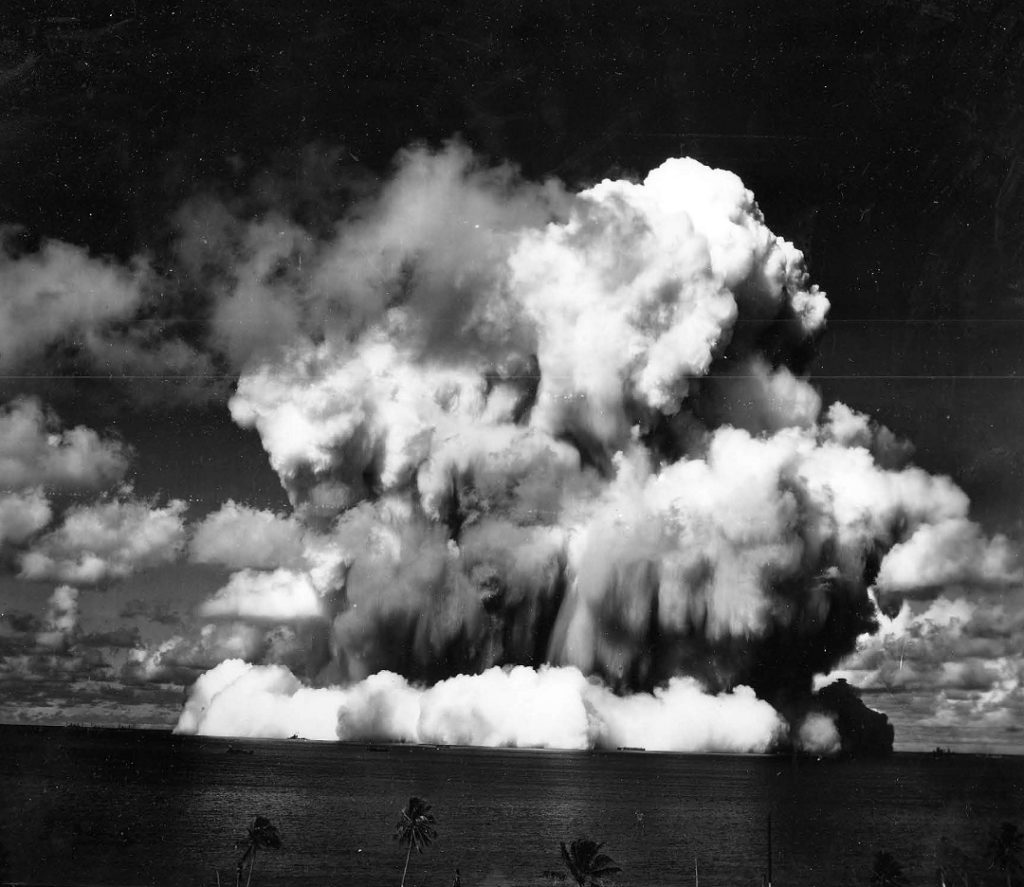
The water steamed by the explosion began to rain, returning to the lagoon in the form of an intensive typhoon. Observers could hardly see the target fleet under the heavy rain until half an hour later. Moreover, a wall of debris drifter 7 miles away and reached all target ships; Here is where most of the explosion’s radiation poisoned the fleet.
It is true that the explosion wasn’t as spectacular as Able’s. However, as we will see, the radioactive rain showed a greater deadliness than the previous test.
You can see a video of the detonation here:
Ships’ Damages
After Crossroads, there was no doubt that ships couldn’t survive against the power of nuclear weapons.
Of the target ships, LSM-60, located exactly above the bomb, was, of course, the most damaged. It simply vanished, flying up into the sky leaving but little pieces floating around.
For the rest of the ships, the explosion’s shockwave was their main source of destruction as its sudden force smashed their hulls. The explosion sank eight ships, including the two largest: Arkansas and Saratoga.
225 yards away from the explosion, Arkansas sank almost immediately. It went underwater in 19 seconds, becoming the first-ever battleship sunk by the power of a bomb without being directly hit by it.
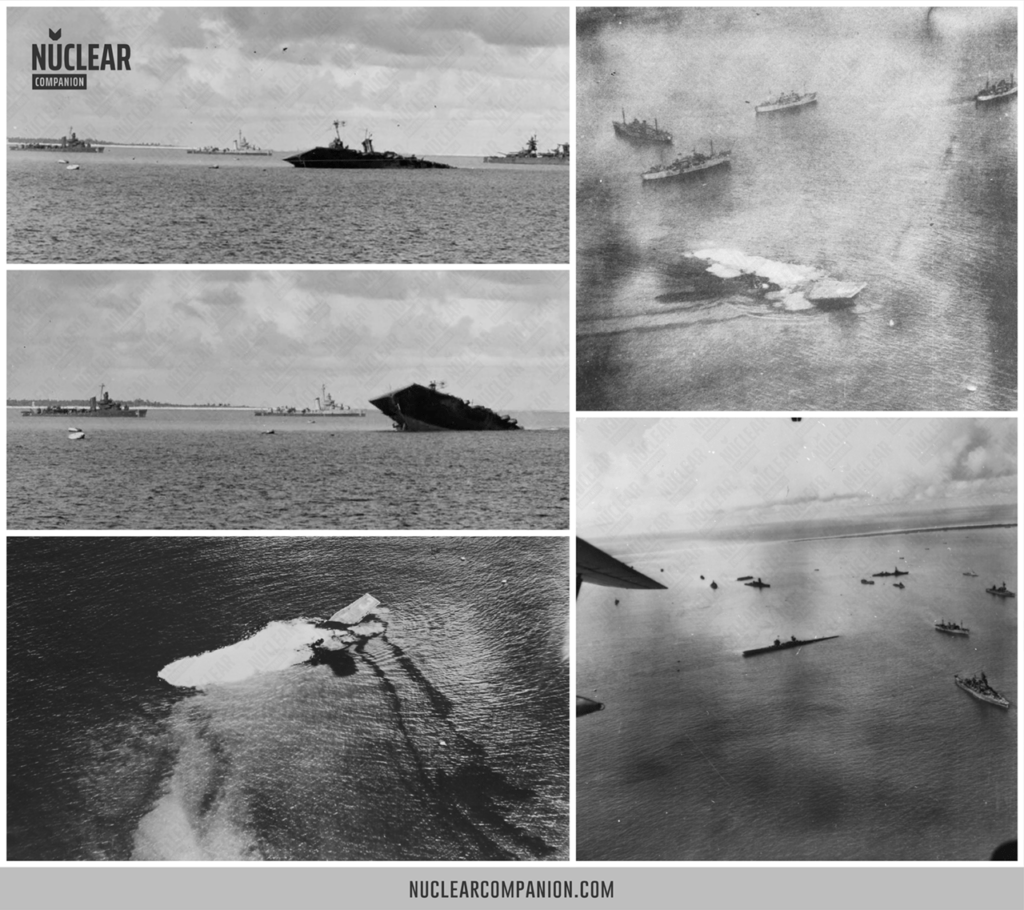
Arkansas was first believed to have been lifted by the explosion before disappearing under its column. Yet, subsequent analysis showed that the blast’s column only tore off its foremast.
Saratoga, for its part, was at 350 yards from the bomb when it exploded. It had been initially arrayed farther away from the bomb’s location yet the wind brought the carrier closer to it. After the explosion, Saratoga drifted as far as 800 yards away from ground zero.
The carrier was lifted 43 ft from the water by the first massive wave and hit again even harder by a second which destroyed its deck. When survey teams inspected the ship, they found that Saratoga was starting to sink, with its stern at water’s reach.
Aside from the eight that sank, another eight were completely disabled. Among them were battleships New York and Nevada, cruiser Pensacola, destroyers Hughes and Mayrant. They were inside a range of 900 yards from the explosion.
Interesting Fact
Arkansas was the first battleship ever sunk by a bomb that did not strike it directly.
Those in the range of 900 to 1,100 yards, for their part, suffered moderate damage. Meanwhile, ships between 1,100 and 1,500 yards away from the explosion suffered slight damage. Those ships at least 1,500 yards away did not suffer any damage.

On Jul. 28, battleship Nagato was reported at 9:45 a.m with an angle of the list to starboard of eight degrees. It was down by the stern, and by 4:52 p.m., its main deck was already at reach for the sea waves. The following day, the ship continued to list to starboard, finally sinking by 2:00 a.m. on Jul. 30.
Of the eight submarines used as target ships, three sank: Pilotfish, Skipjack, and Apogon. Submerged 168 ft below the ocean at 363 yards away from ground zero, Pilotfish, moored adjacent to Arkansas, was the closest of them to the explosion.
Apogon, for its part, was 100 ft underwater and 850 yards away from the explosion.
Baker’s Contamination
Baker was the main cause of radioactive contamination during Crossroads. While on Able radioactivity dissipated in the atmosphere, the water absorbed as much as half of Able’s fission products.
In this way, radioactivity propagated through Bikini thanks to the subsequent radioactive rain.
Drone boats showed the lethal dose of 730 roentgen per day on the target array center. This couldn’t help patrol boats reentering the lagoon only 40 minutes after the explosion. This first group only approached to measure radiation levels and retrieve a few instruments previously set.
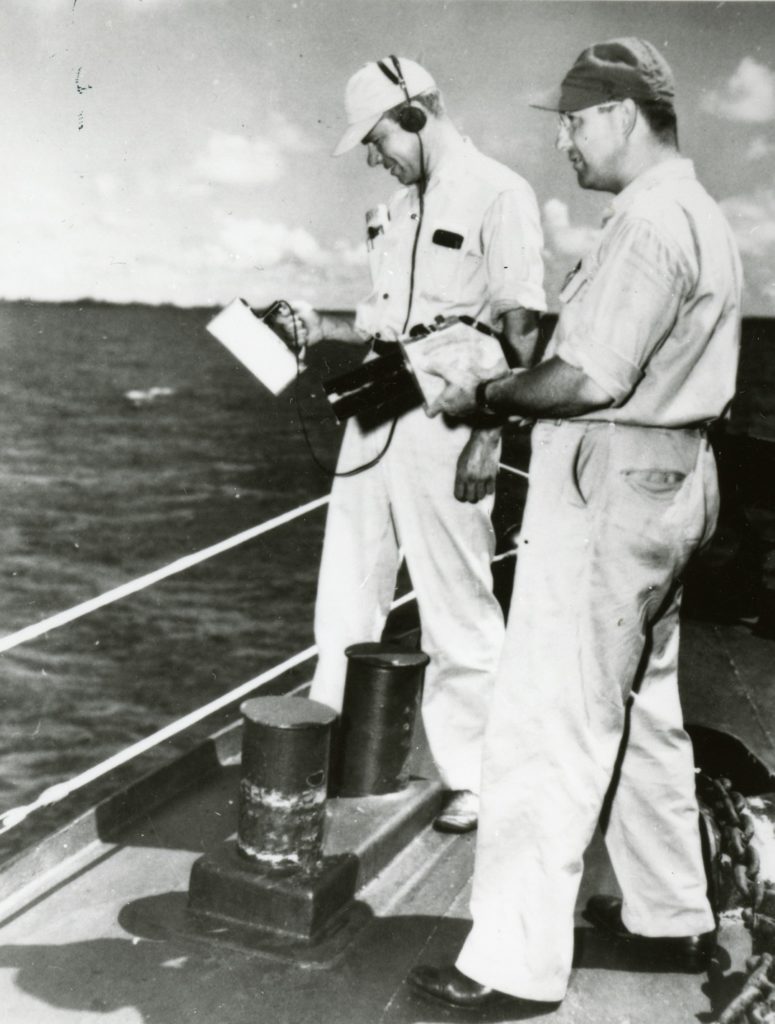
The earliest measurements showed 8,000 roentgen per day on target vessels. To put it in perspective, this was 80,000 times the standard daily radiation exposure for a human, and around twenty times the fatal dose.
Two hours after the explosion, a salvage group approached the lagoon. Shortly, another group continued taking measurements and retrieving more instruments from other ships.
Not much later, 49 ships and 15,000 crew members entered the lagoon. Navy scientists concluded that ten of the ships were safe, but this big crew limited to board only five of them. These were the farthest from the explosion: Cortland (APA-75), Fillmore (APA-83), Bladen (APA-63), Geneva (APA-86), and Niagara (APA-87).
On Able, most ships were shortly boarded, while on Baker the U.S. Navy couldn’t approach most of them closer than 50 ft. When Blandy and Warren attempted to make a tour through the fleet, radiation forced them to withdraw in half an hour.
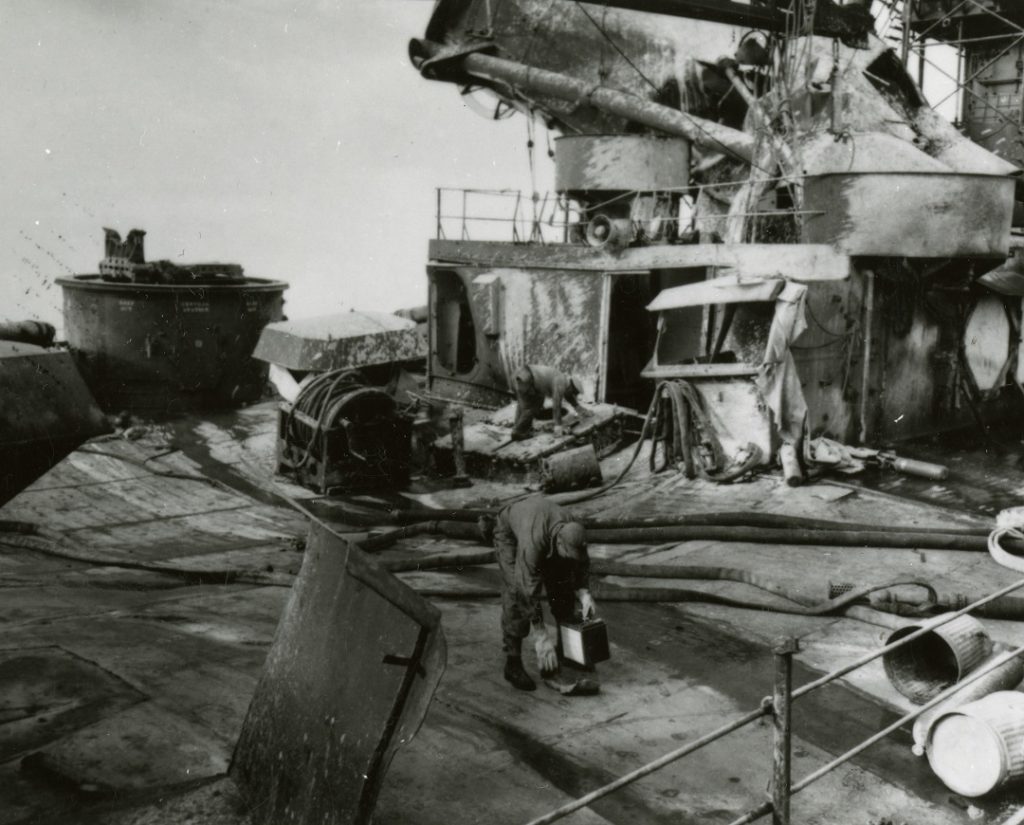
The U.S. Navy acted fast in preserving those ships that could save from sinking. Between July 26 and 27 they beached radioactive destroyer Hughes and transport ship Fallon, both close to sunk Arkansas.
Carrier Saratoga wasn’t as lucky. Rear Admiral Thorvald Solberg, head of salvage operations during Crossroads, was in charge of the rescue attempt. His plan consisted of cutting the ship’s anchorage for later towed it to Eneu Island.
But as Solberg and his team approached the ship in a fast tug, they noticed that the water was heavily contaminated. They had to retreat. The ship drifted away until sinking at 600 yards from the ground zero seven hours and a half after the explosion.
Radiation was extremely dangerous overall for those working on Crossroads. Of course, chief of the Radiological Safety Section (RADSAFE) Stafford Warren wasn’t happy. As a matter of fact, he had foreseen this scenario to an extent.
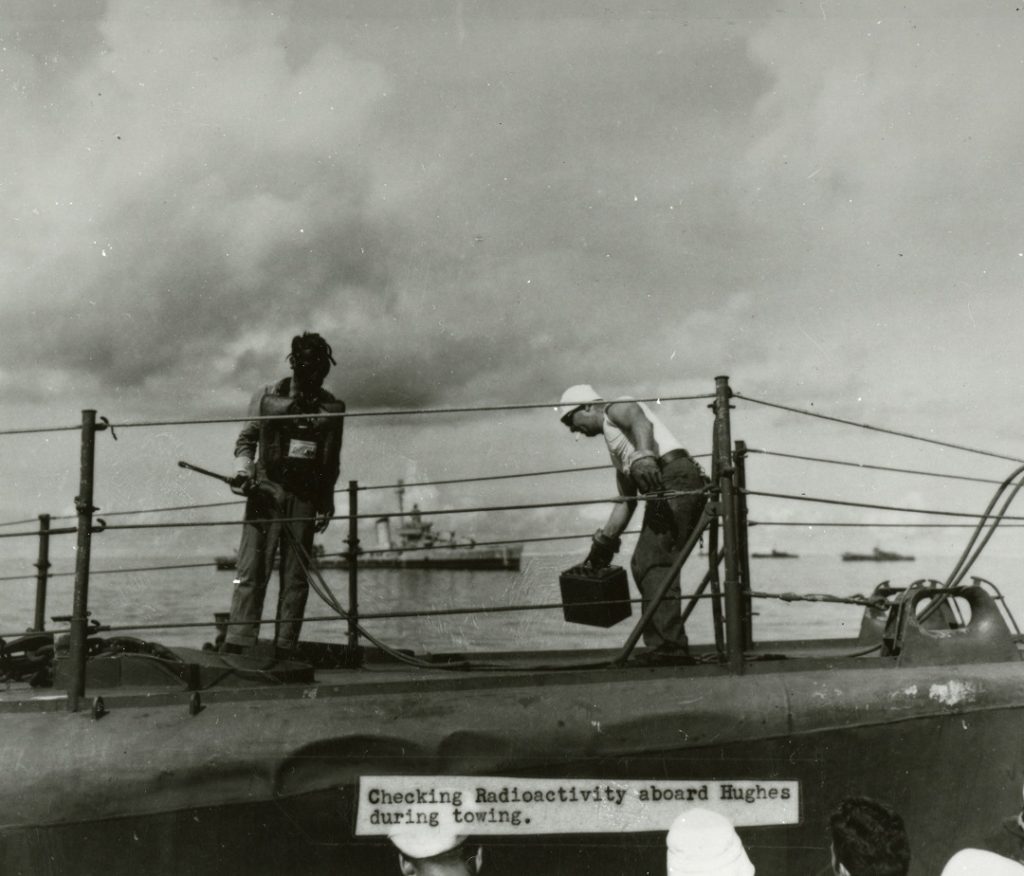
Before the test, Warren informed that the explosion’s radiation could be so severe that it would remain for a long time on the target ships. Nevertheless, no one foresaw how much the water helped for this to happen.
All the while, the U.S Navy assured that those approaching the explosion’s place had the proper gear for doing so. Nonetheless, the 1988 documentary Radio Bikini shown otherwise. The film exposed how sailors didn’t have protection while examining the deadly contaminated ships.
Even a week after the explosion radiation continued high enough for limiting visits to be as brief as possible.
Moreover, support ships began to take radiation from Bikini’s waters. In this way, RADSAFE recommended ships to deactivate their use of seawater during their time in the lagoon. Normally, ships used it for features such as their cooling system
Similarly, for whom the radiation proven terminal were the test animals. Even those under many layers of ammo died of radiation.
The U.S. Navy couldn’t retrieve the animals in the time expected. The first hours were key for studying the effects of radiation on them, but the Navy could only get to them a few days later.
At that time, many were already dead, and many others died not much after. Six of the twenty pigs died on the ships before the U.S. Navy could get to them, and two weeks later the rest died as well.
Some animals showed an immense exposition to radiation. Attack transport Gasconade had animals with levels of 2,700 roentgen per day.
Decontamination Efforts
For the U.S. Navy, not being able to adequately examine the ships was more than a setback. It was one of the operation’s main goals in the first place.
Therefore, the U.S. Navy began a series of efforts for decontaminating the ships. These were among the first attempts to clean nuclear radiation.
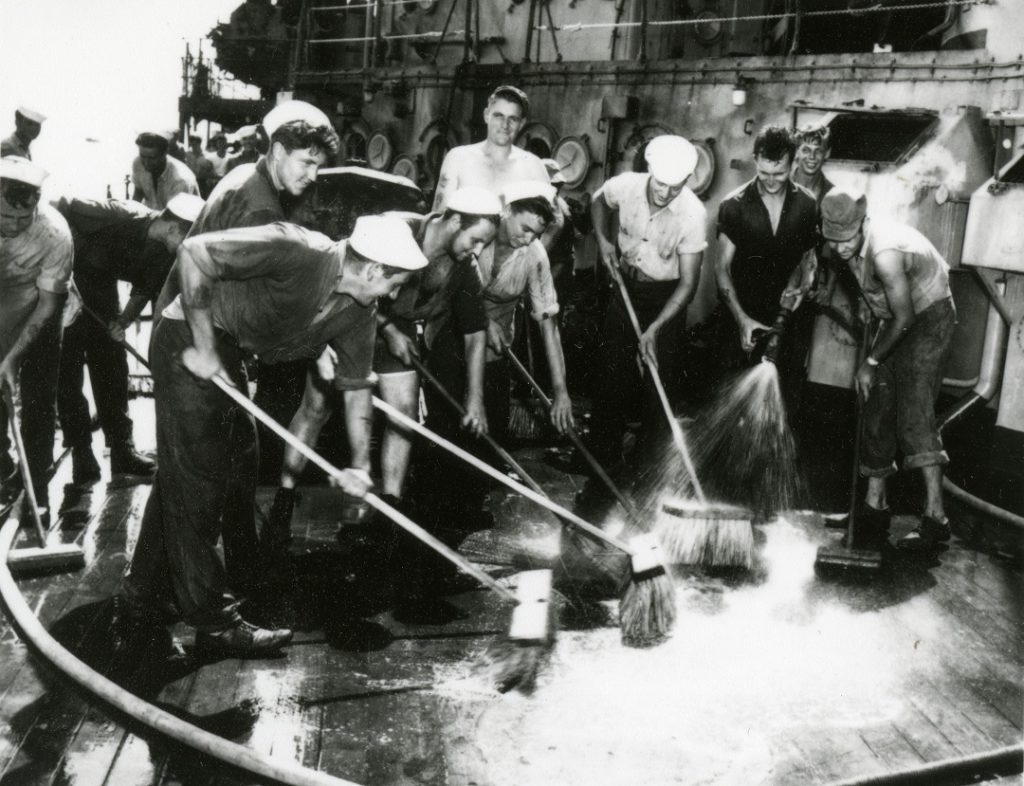
As soon as Jul. 27, the first attempt consisted of washing battleship New York using saltwater from fire fighting ships. The next day, the U.S. Navy took what they got at hand in Bikini and Pearl Harbor and used it for blasting the ships with air compressors.
Sailors used all sorts of supplies: from soap powder and diesel to sulfuric acid, sand, and charcoal. Even things like corn, rice, coffee, barley, flour, and coconut shells. Sailors took turns scrubbing the ships, and retired all organic matter present in the ships; things like canvas, rope, and wood.
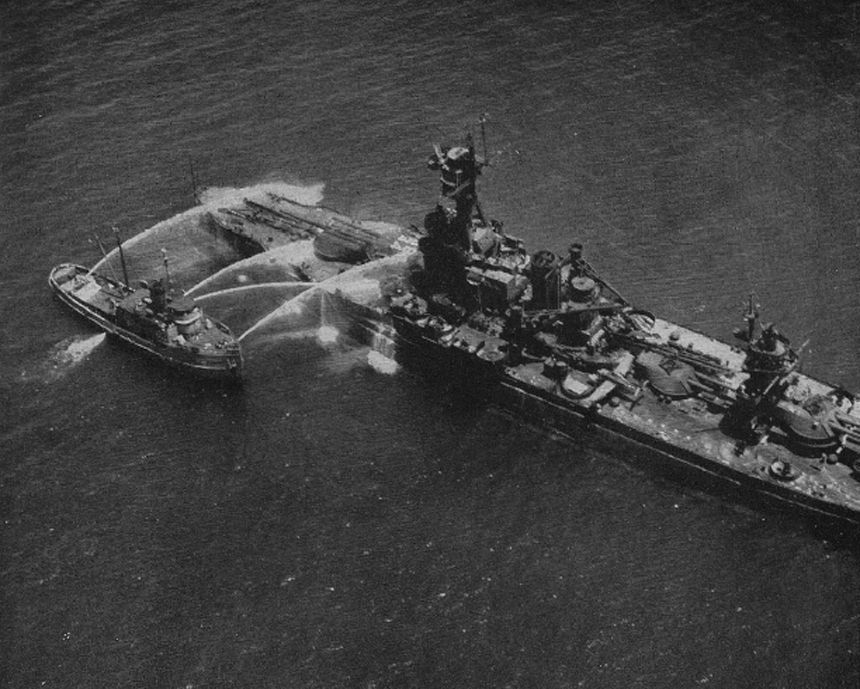
These attempts were not fruitful enough, as they could as much as remove contaminated surface elements. The only thing that showed positive results was the use of an acetic acid solution. It was, however, impossible to apply massively.
Sandblasting was effective in removing surface materials. Brass and copper, for their part, had to go through nitric acid baths.
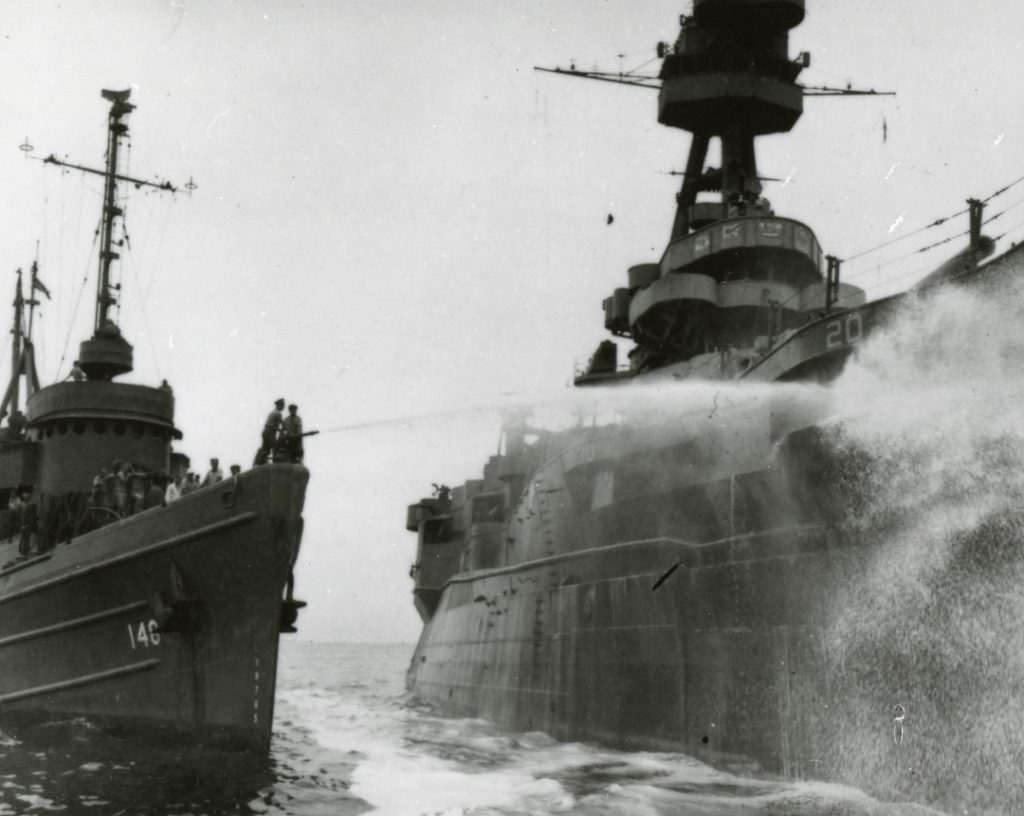
For removing the paint the U.S. Navy come up with a mix of lye, boiler compound, and cornstarch. adding this mix to water. They apply it in two washing cycles, first with a firehose and two hours later using monitor nozzles for removing the paint. For difficult spots, sailors used brushes, holy stones, and by virtually any means they could think of.
Interesting Fact
The science of ship decontamination was born at Bikini lagoon following Test Baker.
During the cleanings, those monitoring radiation levels were the most exposed to radioactivity. They were always fully clothed and used rubber gloves and boots.
The average sailor did not have much protection, though. Many did not even were aware of how dangerous was approaching the explosion’s area.
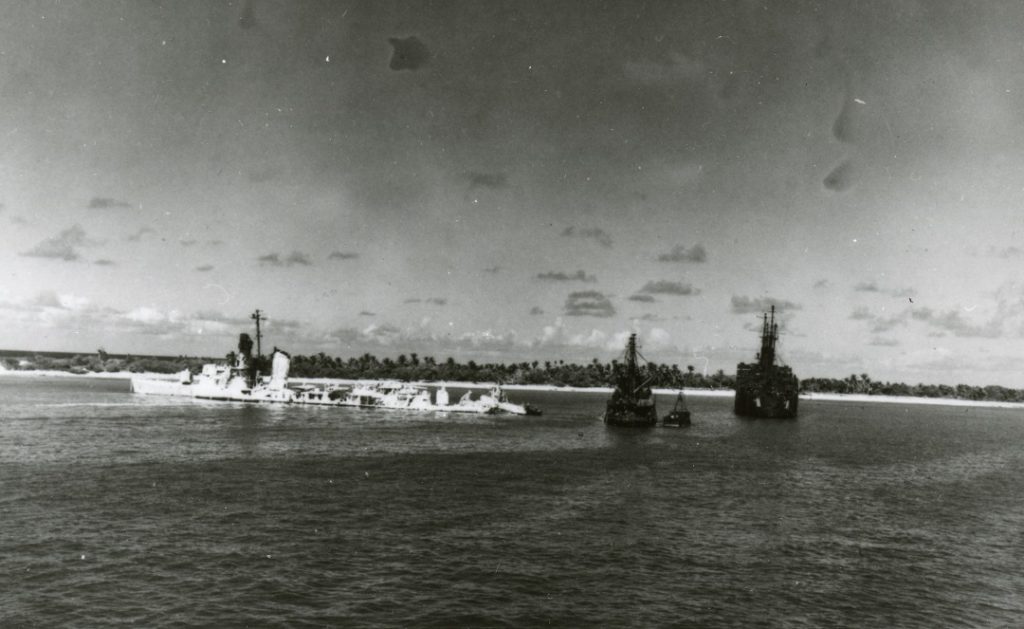
As a matter of fact, many who participated in Crossroads ended up exposing themselves to dangerous doses of radiation. Flaws in security measures were systematic as many ignored the danger they were facing.
Bad radiation protection equipment and the lack of monitors were harmful as well. In this regard, officers managed their subordinates’ time on the ships without taking account of how dangerous it was. Not a few times sailors had to work extra hours on these poisoned ships.
Plutonium and alpha emitters
For Warren, the greatest danger was plutonium, which emitted alpha radiation. Alpha radiation is easy to block, yet, if its particles happened to enter in contact with a human body, their absorption can be lethal.
The ugly part was that the U.S. Navy didn’t have any proper monitors developed for measuring this type of radiation in the ships.
The only instruments able of detecting alpha radiation were on Haven’s laboratory, Warren’s ship. However, these could only work properly in the laboratory’s controlled environment.
By Aug. 3, Warren was sure of how catastrophic it would be to continue with the decontamination efforts. He understood that without any alpha radiation measurement device Crossroads personnel wasn’t safe.
In the meantime, measuring other radiations was enough for the U.S. Navy to keep sending workers to the ships. Only later the U.S. Navy would confirm the presence of plutonium on the target fleet.
Warren followed the chain of command in exposing his concerns. He showed Blandy the presence on fish scales of alpha emitters, and by Aug. 10 Blandy arranged a meeting for discussing the matter.
Hindering their work, Warren ended up pissing off the U.S. Navy captains at Crossroads. Anyhow, he argued that he was but following Blandy and Truman’s orders on protecting the lives of those on Crossroads.
After the reunion, decontamination works ceased. Blandy insisted on continuing Crossroads’ tasks in Kwajalein and leaving Bikini behind for the time. In this way, by Sep. 26, Bikini was completely evacuated.
What Happened to the Target Fleet
The U.S. Navy battered the poisoned ships to Kwajalein and later to many different locations. From Pearl Harbor and Bremerton, Washington, to Hunters Point and Mare Island, California.
At their destinations, before abandoning them the U.S. Navy took all the ships’ ammo. Later on, as part of practice maneuvers and new-weapons testing, they were sunk one after the other.
German cruiser Prinz Eugen, for its part, sank at Kwajalein Atoll in 1946 due to the damage it had taken after meeting two nuclear explosions. Nevada and New York sunk in Pearl Harbor in 1948. Before sinking, their contamination was valuably studied.
A total of seventeen ships were directly sunk by Able and Baker’s explosions. Yet, the nuclear fallout was the true responsible for the destruction of the entire fleet.
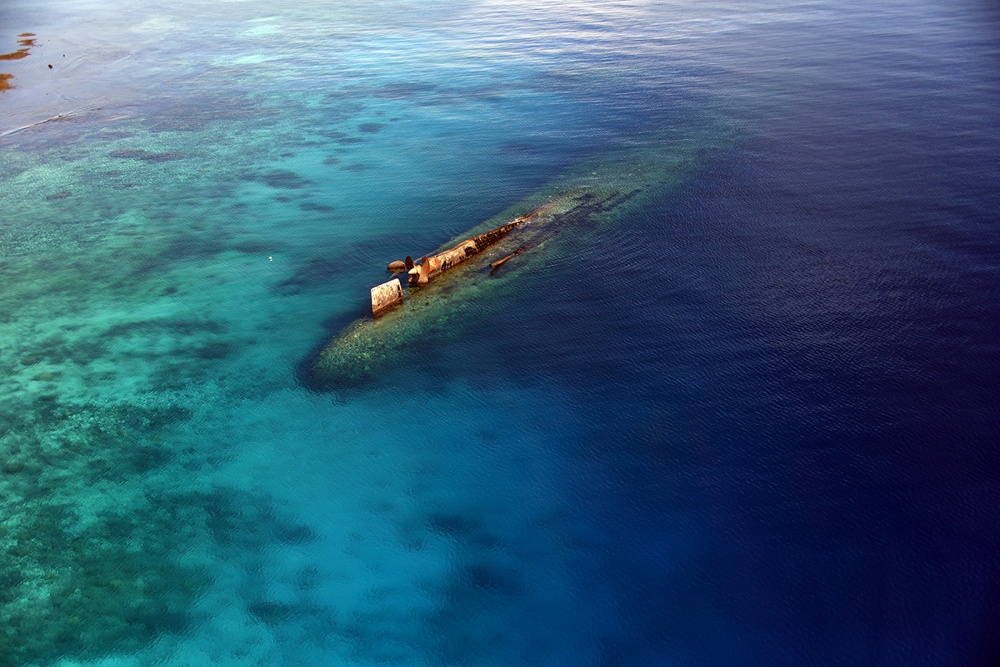
To put things into perspective, of a total of 92 ships, only nine survived Operation Crossroads and lived to tell. The rest ended up sinking, irreparably impaired, or deadly contaminated.
After Crossroads, Warren recommended abandoning subsequent decontamination efforts toward the ships. Parsons, nevertheless, ignored him and ordered to continue at each of their different locations.
A year went by and many ships still conserved high levels of radiation. Aware of this situation, not much later the U.S. Navy ordered to sink those that were still radioactively dangerous. The U.S. Navy bombarded a total of fifty, thirty-six of them at Kwajalein.
Infographic
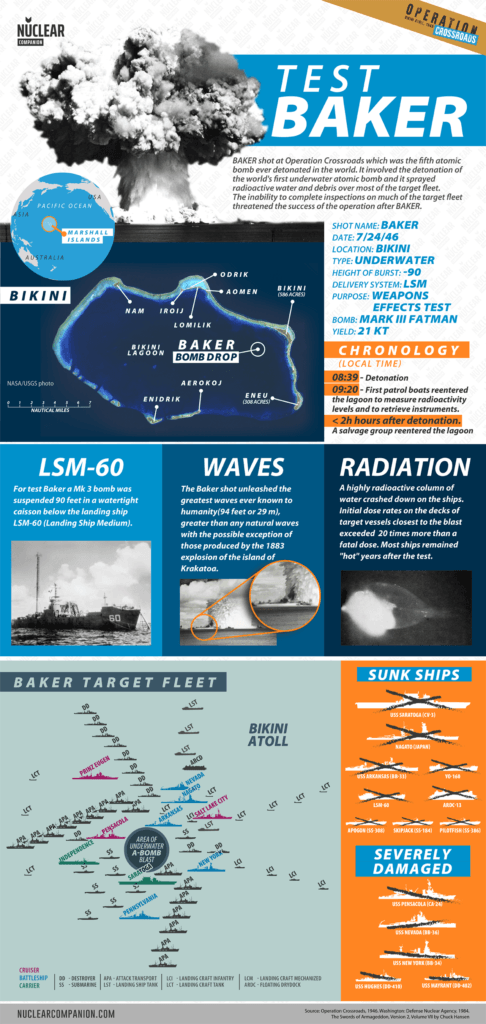
Charlie
Test Charlie, the third and final atomic explosion of Operation Crossroads, was originally scheduled to take place in 1947. With this test in particular the U.S. Army wanted to study the effects of an underwater nuclear explosion. 1,000 feet below the ocean surface, to be precise.
Los Alamos Scientific Laboratory (LASL), in charge of nuclear bombs’ designs, had faith in Test Charlie’s power. LASL considered that the explosion would particularly beat the ships’ hull structure, sinking most of those within a range of 2,000 to 4,000 feet.
In performing the underwater detonation, the greatest obstacle was carrying the bomb all the way down to the explosion point. As Blandy communicated to the congress, engineers needed to come up with a bathysphere capable of tanking a huge water pressure. At the explosion’s depth, such a vessel would have to deal with 1,000 psi of pressure.
The taxing task of designing the bathysphere caused the test to be rescheduled to the second semester of 1947.
On the other hand, the scientific team concluded that the best distance downward for the explosion was around half a mile from the surface. This was twice the depth firstly considered.
Likewise, the bomb had to be detonated about two times this distance from the bottom of the ocean. As such, the chosen place was the southwestern corner of Bikini. There, at the bottom of the ocean is located a submarine canyon deeper than a mile, perfect for the test’s required depth.
Before traveling to Bikini, Blandy appointed Test Charlie to take place Apr. 1, 1947.
In the three weeks between tests Able and Baker, preparations for Charlie continued. Blandy used this time for selecting fifteen to twenty boats and submarines for the test and for deciding how to arrange them. Among the ships for the test, Blandy picked Idaho and New Mexico battleships.
In Aug. 1946 a gigantic cable was attached to the coral of Oruk Island (codenamed Zebra) a mile offshore. Chains stretched in the deep reef were connected to this cable for mooring the ships for the test.
Opposition
Yet, while preparations for Charlie were already moving forward, LASL started having second thoughts on the test. After two rather successful nuclear detonations, was a third one worth it? What could it add to what was already achieved with the previous two?
Nuclear bombs were neither cheap nor unlimited. In fact, the U.S. didn’t have many nuclear devices. All the while, LASL had newer weaponry technologies waiting for their time to be tested.
Test Charlie‘s most prominent detractor was head of Manhattan Project General Leslie Groves. He was in charge of LASL and superior of officials such as Norris Bradbury, Roger Warner, and Marshall Holloway. Like them, Groves rejected Operation Crossroads from the beginning and especially Test Charlie.
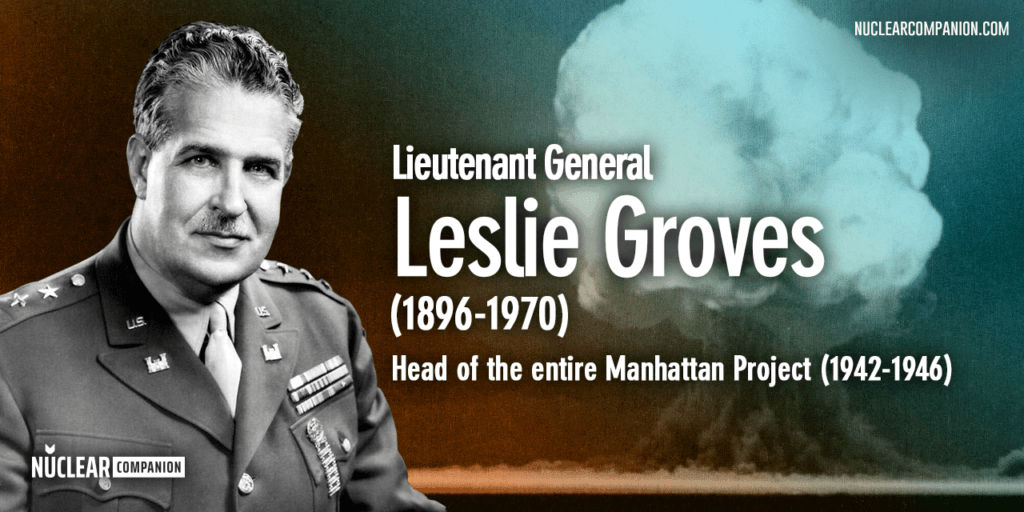
In a letter to Secretary of War Robert P. Patterson, Groves expressed his opposition to Charlie and asked for its cancelation. For Groves, there was no point in a third test after Baker provided enough data to recognize the effects of an underwater nuclear explosion.
Groves also pointed out that the test ships couldn’t be located as close to each other as in the previous tests. In this sense, he believed that the bomb would not cause any meaningful damage to them.
But Groves’ main concern was the small number of available bombs the U.S. had. For the press, the country counted with around fifty bombs and was producing new ones on a weekly basis. In reality, the army only had seven and its manufacturing rate didn’t surpass four bombs per year.
Furthermore, Groves was against using LASL engineers in the test. They were the few people able of working with atomic weapons technology. Their valuable time couldn’t be wasted in such an expendable operation.
Groves’ cancelation request reached Blandy’s ears soon enough. Blandy quickly responded in a memorandum to Admiral Nimitz, stating that Test Charlie was not about the bomb’s capacity for sinking ships.
Blandy sustained the hypothesis that Test Charlie’s explosion could scrape the bottom of the sea. This would produce a poisoned water geyser flying hundreds of feet above the surface.
At the same time, Blandy recognized the fact that LASL engineers were the only capable of working with these bombs. However, he showed himself in favor of changing this by having LASL to train new professionals for working with this type of technology.
Cancelation and Operation Wigwam
Still, Groves’ opinion prevailed. He succeeded in convincing Patterson, who advised Joint Chiefs of Staff to cancel the test. Groves’ most convincing argument was the short amount of bombs the U.S. had on stock.
It’s also worth mentioning that the higher-ups in the chain of command had a clue of the size of their own nuclear arsenal. Neither President Truman, Secretary of State James F. Byrnes nor Secretary of the Navy James V. Forrestal was aware of this situation. The fact that only Groves and Eisenhower had steady access to this information wasn’t good for a proper national defense strategy.
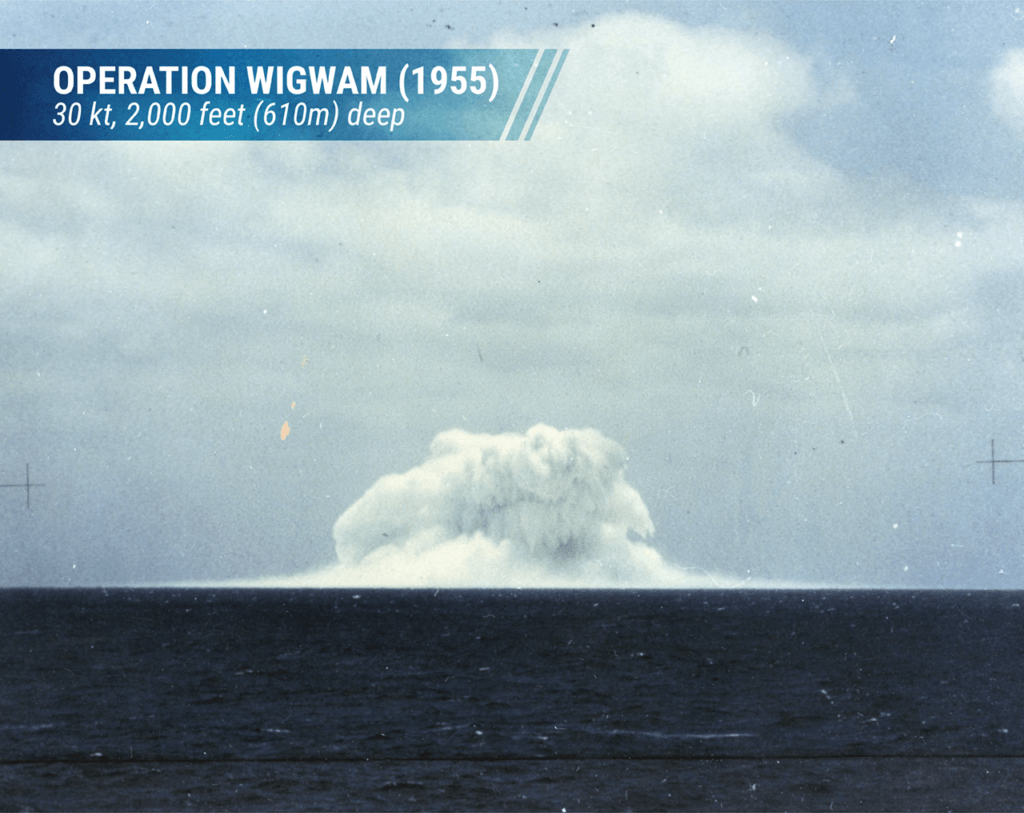
Patterson and Forrestal made official their position on Aug. 30, 1946. They wrote to Truman recommending the cancelation or indefinite postponement of Test Charlie. They stated that LASL had its hands full with the first two tests, and scheduling the test, then to early 1947, would only delay them even more.
A week later, on Sep. 7 the president postponed Test Charlie indefinitely. The test would only take place in May 1955 as part of Operation WIGWAM on the U.S. west coast. Moreover, with the shutdown of Test Charlie, Operation Crossroads was over and on Nov. 1, 1946, Joint Task Force One became history.
The Bikini people in Exile
Rongerik
After abandoning their homeland, Bikinians‘ new life was far from ideal.
They arrived at Rongerik Atoll having a diet based mostly on collecting coconuts from trees. However, these were not as fruitful in Rongerik as in their now former home. Plus, shortly after Bikinians arrived many of these trees burned in a great fire.
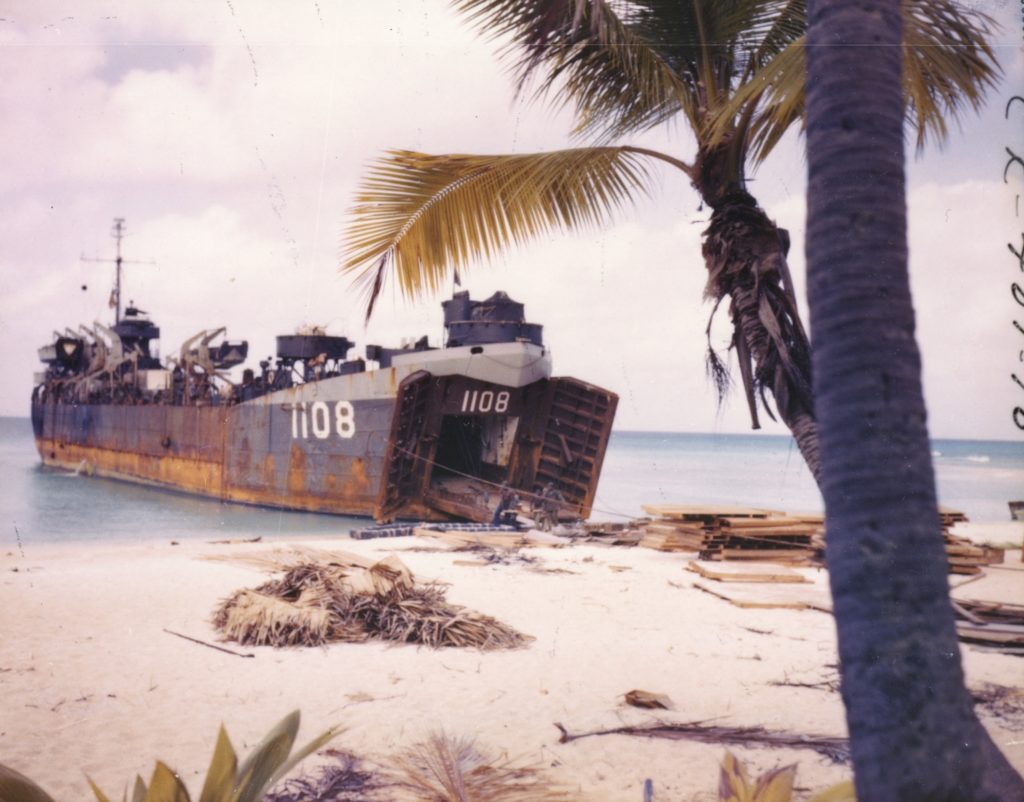
Bikinians had to rely on fishing then, but most of Rongerik’s fish was not fit for consumption. As a result, many Bikinians ended up suffering poisoning if not starving by the lack of food.
In this scenario, as quickly as two months after moving Bikinians were forced to request aid to the US. In Jul. 1947, US army physicians found many Bikinians suffering malnutrition. After the visit, they concluded that it was imperative to move Bikinians away from the island as soon as possible.
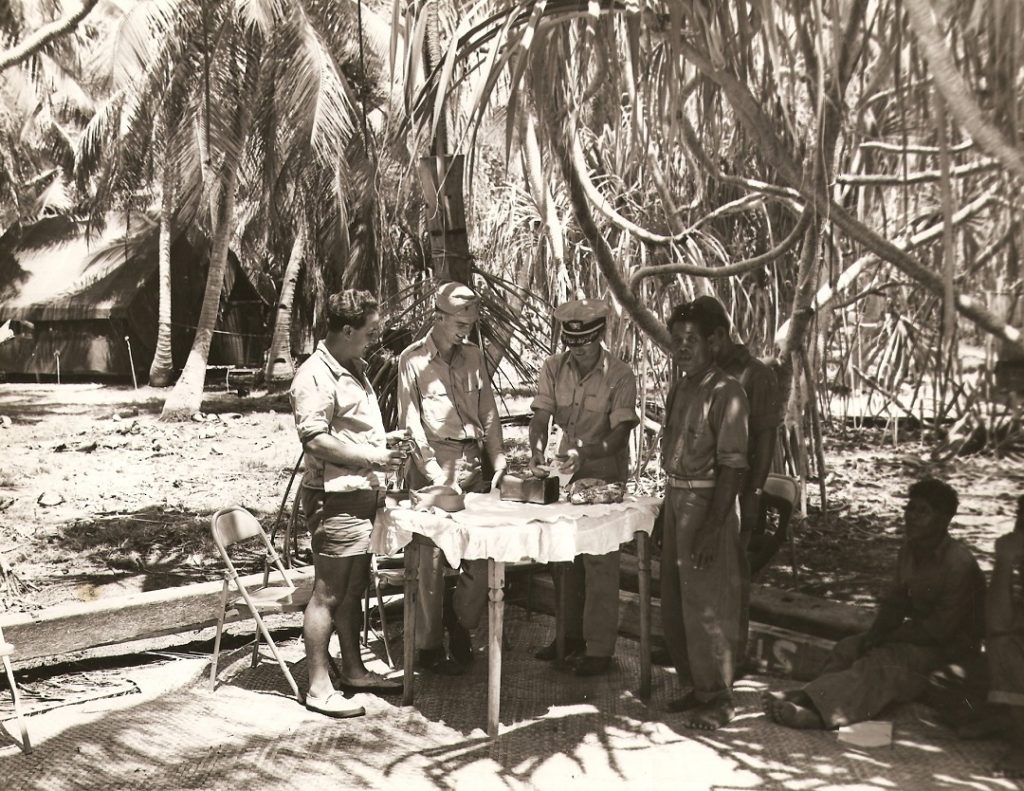
The chosen destination was Ujelang Atoll, located in the westernmost part of the Marshall Islands. As early as Nov., prior to moving Bikinians started building their new homes in Ujelang with the help of U.S. Navy Seabees.
But this suddenly changed as the army chose Enewetak Atoll as the place for a second nuclear test. Its inhabitants were the ones who moved to Ujelang.
By Jan. 1948 Bikinians’ situation in Rongerik was no longer bearable. An academic from Hawaii University reported their poor state and asked for food supplies and medical assistance.
Kwajalein and Kili
Bikinians had to wait until Mar. 1948 to move to Kwajalein Atoll, a temporary home. There they lived next to the US cement airstrip in tents and shortly after had to decide, again, where to commence a new life.
By Jun. Kili Island, on the south of the Marshall Islands, was chosen. The fact that this uninhabited island didn’t have a king or “iroji” helped with the decision.
By Sep. Bikinians and Seabees began to prepare the island for inhabiting it. In Nov., the 184 Bikinians left Kwajalein Atoll and moved to Kili. This was their third relocation.
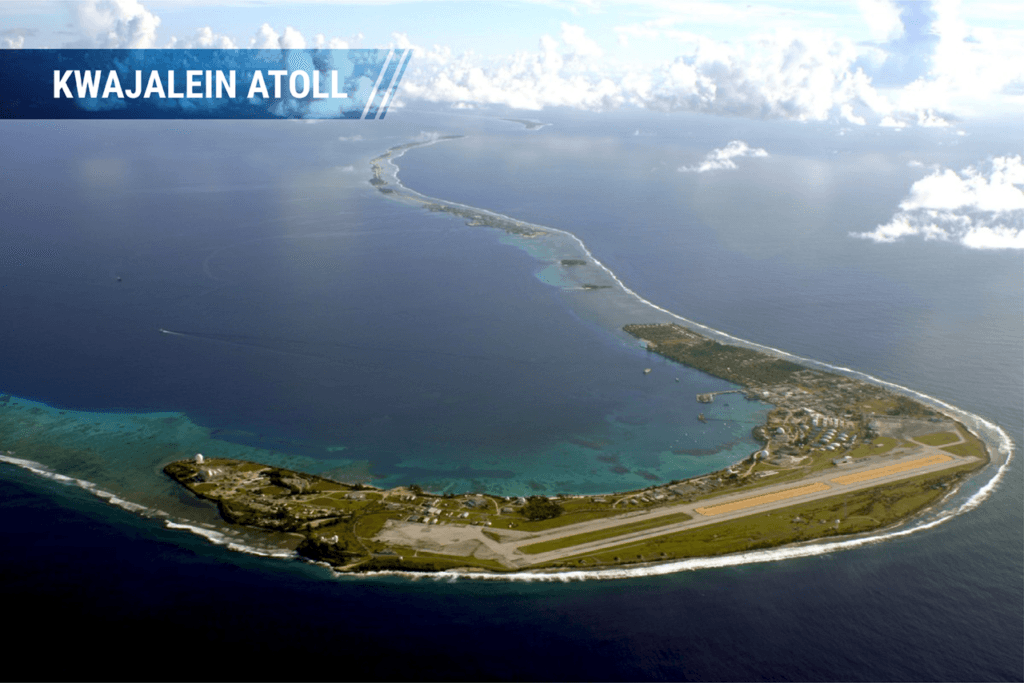
Before moving there, Bikinians thought Kili was a burial ground for royals, thereby perceiving it as a holy place. However, with their experience there, Bikinians shortly started calling it a prison.
On Kili, food was still the main problem. Even worse than before, since the island didn’t have a lagoon for fishing.
In this regard, Kili was a sole island and only had one-third square mile of land while Bikini had 3.4 square miles. Its weather was terrible as well, with 20-foot waves during most of the year. As such, Bikinians had to rely again on the U.S. for something as basic as food.
The sea hindered making a living out of it and for outer visits to reach the island. Food supplying was so difficult that one time supplies had to be airdropped.
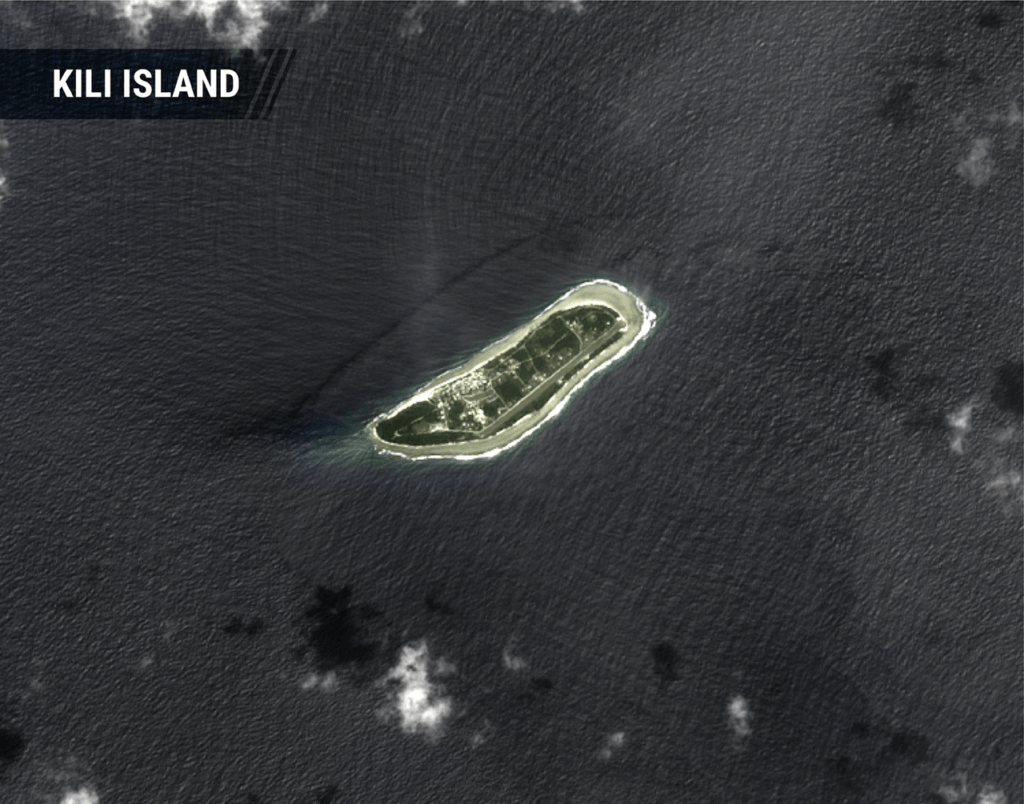
The extreme weather was also responsible for sinking their ships and destroying their buildings. In 1956 U.S. granted them the settlement of a satellite community at Jaluit Atoll, thirty miles north of Kili.
They also received a ship for transporting copra between their new home and Jaluit Atoll. However, a few years later, in 1951, they lost the ship as it clashed fully loaded with the island’s coral reef.
Many families moved to Jaluit to manufacture and commercial copra. Yet these constant storms ended up making it uninhabitable.
On the other hand, during this time Bikinians sign an agreement with the U.S. regarding their rights on Bikini Atoll. The document stated that any claim made on Bikini had to be delivered to their own leaders and not to the U.S. government. As part of the agreement, Bikinians formally received their rights on Kili and other islands in Jaluit Atoll.
Operation Castle
Bikini Atoll, for its part, had not finished its military role. In 1954 it became the scenario for Operation Castle. This nuclear test featured the detonation of the U.S.’s most powerful hydrogen bomb and was the first airdropping of this type of weapon.
The dropping took place on Mar. 1. Known as Bravo, it exploded at the surface level of the reef at the northwestern corner of the atoll.
The explosion illuminated the whole region. Its fireball of millions of degrees grown at 300 miles per hour. In a matter of minutes, a radioactive cloud covered 20 miles thanks to the explosion’s rapid winds.
The blast reached the near islands Bokonijien, Aerokojlol, and Nam, and took down all branches and fruits from trees. Along with them, water, sand, coral, and wildlife of Bikini were sent flying.
The observing ships from the Joint Task Force were located about 40 miles from east to south of Bikini Atoll. Soon after the explosion, radiation levels in their positions became so high that they had to move below decks and hatches and seal their doors.
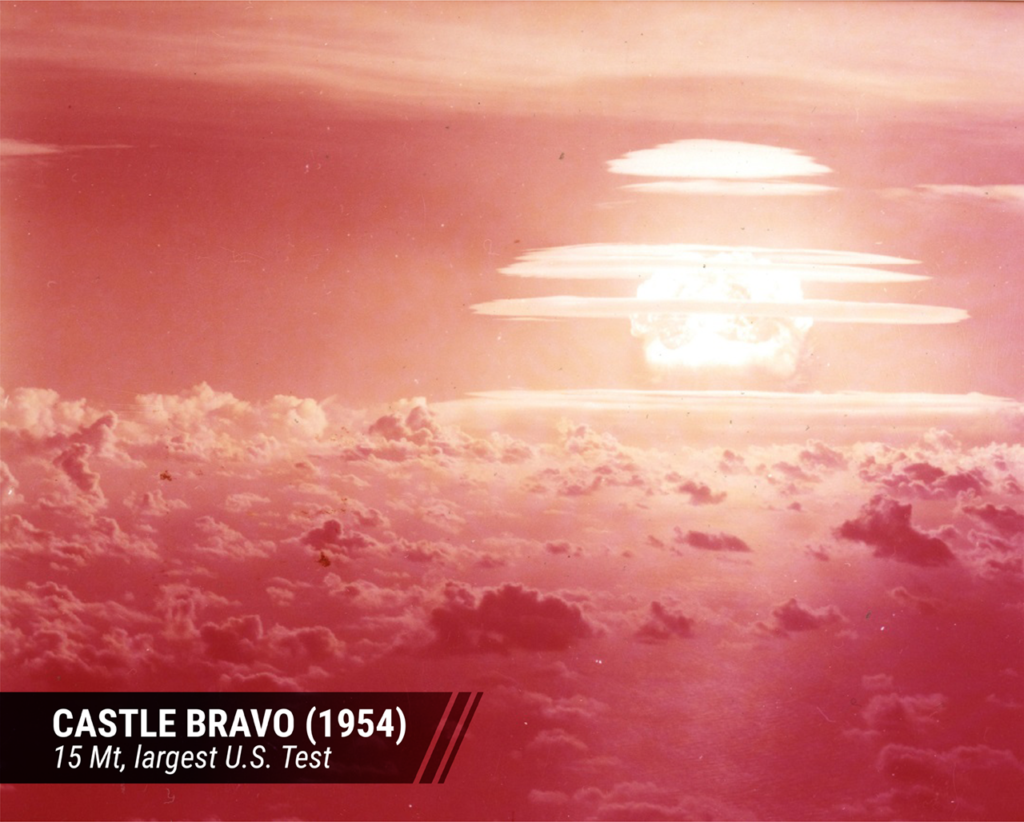
The cloud continued moving and an hour and a half after the explosion found a Japanese fishing vessel in its way. The ashes fell on the 23 crew members of Lucky Dragon.
The crew didn’t know anything about the explosion, yet they couldn’t help suffering first hand the effects of it. Their skin reacted to the radioactive cloud, which also provoked vomiting and nausea. One of them died from exposure to these ashes.
The fishermen were not the only people that bumped into the radioactive cloud unaware of what it was. Around three hours from the explosion, at 125 miles east the white ashes felt on Rongelap and Ailinginae atolls.
The explosion’s unusual light was visible from Rongelap. Yet locals didn’t figure out that the ashes were related to it. Neither they thought they were dangerous.
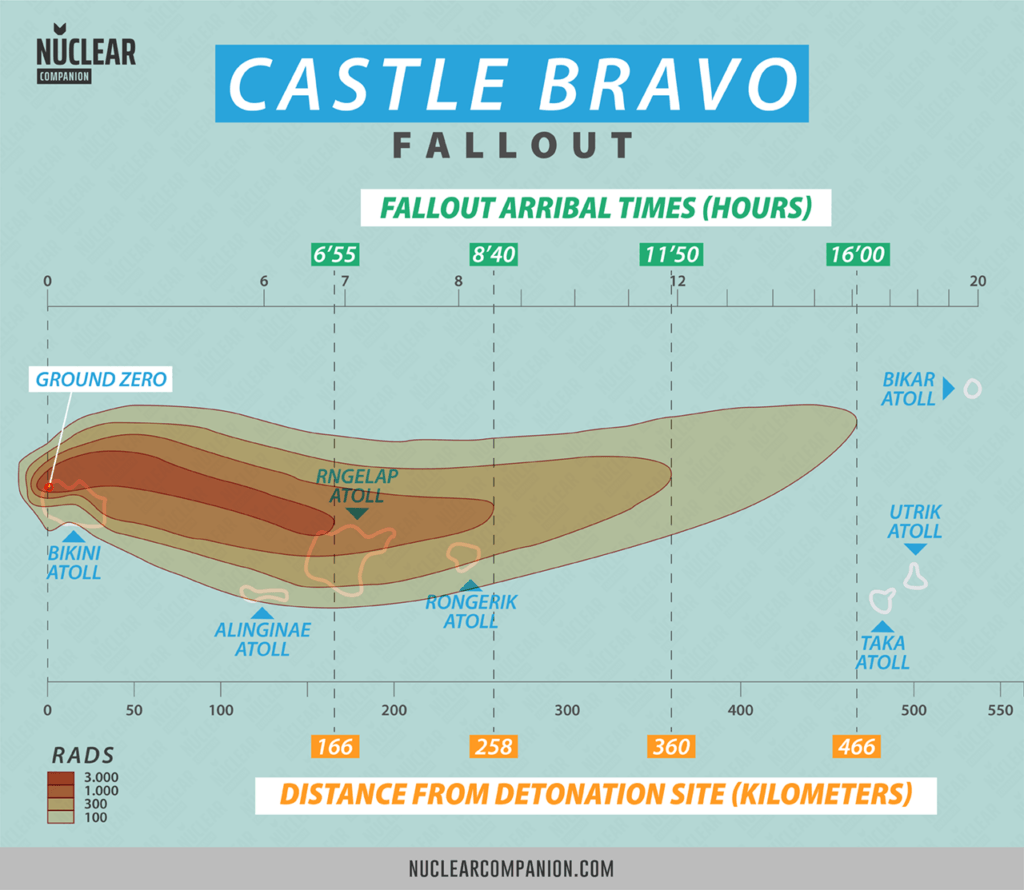
Soon enough, the radioactive ashes formed a yellow layer above Rongelap water’s surface. That same day the poisoning became visible. Locals suffer the same symptoms as Japanese fishermen.
Two days after, Rongelapeses were moved to Kwajalein for receiving medical treatment. They affected a total of 72 people on these two atolls.
As such, Bikini was not the only atoll radioactively contaminated by the bomb. By Mar. Rongerik, Utirik, Ujelang, and Likiep had shown the effects of radioactivity.
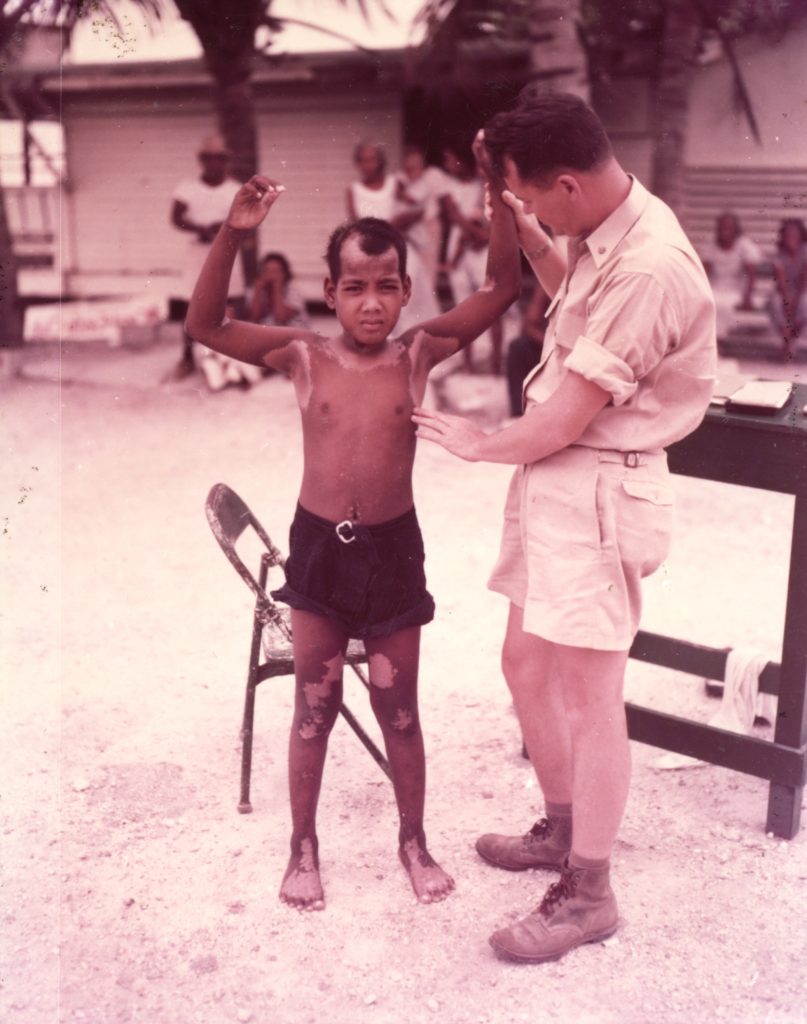
But why these islands were not evacuated before the test?
This was because despite scientists expected the bomb to produce a 3 megaton explosion, the blast ended up producing 15 megatons. Far more than what they anticipated. Bravo was a thousand times more powerful than the two bombs dropped on Japan during World War II.
Yet these islands weren’t evacuated either for the next immediate tests featuring Yankee and Union bombs. By 1954 it was determined that Bikar, Ailinginae, Rongelap, and Rongerik were under the poison of these bombs as well. As Bravo, they were extremely powerful, with 6.9 and 13.5 megatons of power respectively.
Return to Bikini
Neither the sixties were great for Bikinians in Kili. In fact, by the end of the decade, they began to seriously consider returning to Bikini. With this purpose in mind, the U.S. scientific community started measuring Bikini’s radiation.
In 1968 the New York Times featured a story in which the then-president Lyndon B. Johnson promised to move Bikinians back to their homeland. His word took shape next year in the form of an eight-years long reconstruction plan.
The first and most important part of the plan consisted of fully cleaning the radioactive debris from the explosions. The cleaning job, carried out by the Atomic Energy Commission, finished in 1969. As a guarantee, the commission signed a statement assuring that there were no traces of radiation left that could affect life forms.
The second phase, on the other hand, consisted of sowing new crops. But this phase wasn’t as smooth as the first one. The U.S. shortened its resources on the reconstruction project and only by late 1972 the coconut trees replanting ended.
Most importantly, during this time scholars found evidence of abnormal radioactivity on Bikini. On crabs, to be precise, and advised not to consume them in more than small quantities. However, the evidence of persisting radioactivity was enough for the Bikini Council to vote against moving back.
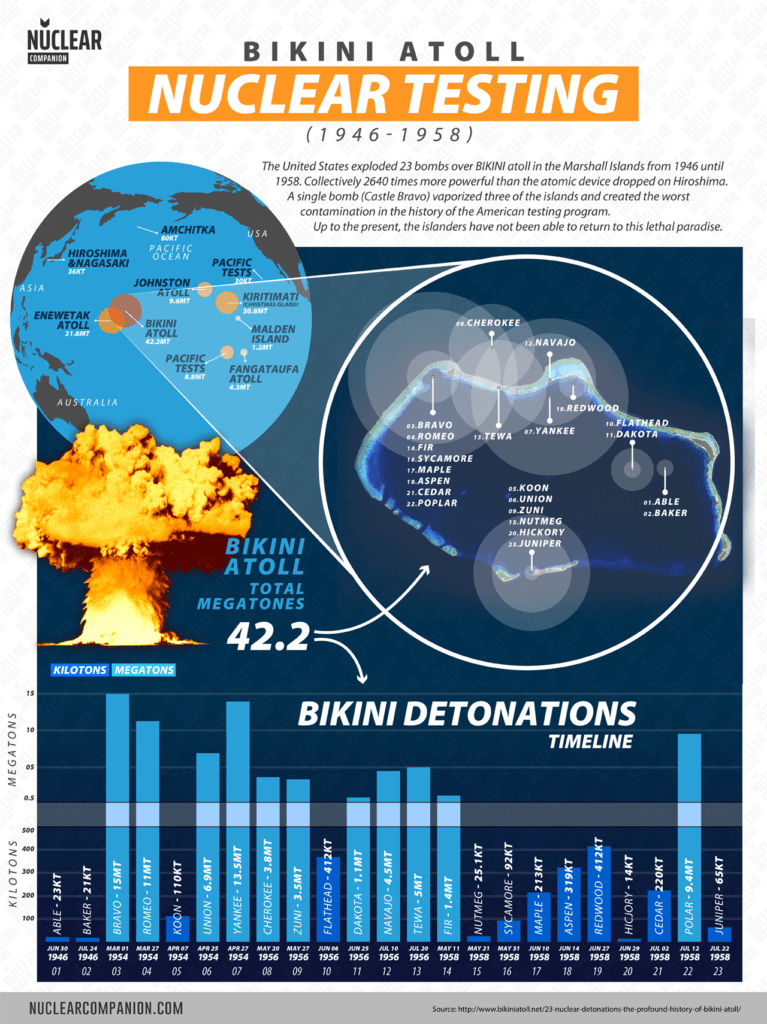
Three Bikinians families, nonetheless, decided to return. With the help of Marshallese workers, they went through the final phase of the project and started reconstructing their homes.
Perhaps they were too optimistic, as in 1975 higher radiation levels were noticed. In this sense, many wells had no drinkable water, and locally grown food was similarly toxic. A urine analysis made to the 100 inhabitants of Bikini shown the presence of plutonium 239 and 240 in all of them.
A spokesman of the Energy Department guaranteed that the radiation levels weren’t dangerous. Still, Bikinians demanded the U.S. government a throughout report. They wanted to know the radiological condition of Bikini and other near atolls on the Marshalls Islands.
Their demands were presented as a lawsuit insisting on the use of newer technology for the task. Bikinians based such a claim on the prominent studies made on Enewetak’s radiation levels.
Who was to make this new study? Different state institutions (Departments of State, Interior, and Energy) relinquished their responsibility. In the meantime, Bikinians continued exposed to radiation.
In fact, the long-awaited radiological study only took place after Bikinians were (again) moved out of their homeland.
The situation at Bikini shown to be worse than initially estimated. In 1977 it was found that Bikini water’s radiation exceeded the U.S. limits for radioactive strontium-90. The Department of Energy (DOE) concluded that Bikini’s radiation was equal to the dose a person could expect to be exposed to in a total of thirty years.
Scientifics also found in most Bikinians an abnormal increase of radioactive cesium-137. As a desperate measure, the DOE recommended to limit coconut consumption to only one a day and started shipping them food.
The next year physicians found on 139 Bikinians radiation levels above what the U.S. established as healthy. Shortly after, the Interior Department communicated their plan to move them out of the atoll within 90 days. The evacuation took place in Sep. 1978.
Today
In the present, Bikini is far from being clean enough for anyone to live in it. A proper cleaning would require funds that no one seems to be interested in paying.
Bikinians, for their part, continue living on the Marshall Islands, but they have also scattered around the globe.
As we have seen, Bikinians’ journey was equally difficult and taxing for them, not to mention their health problems due to radiation. For all the difficulties they went through, they received multiple economic compensations.
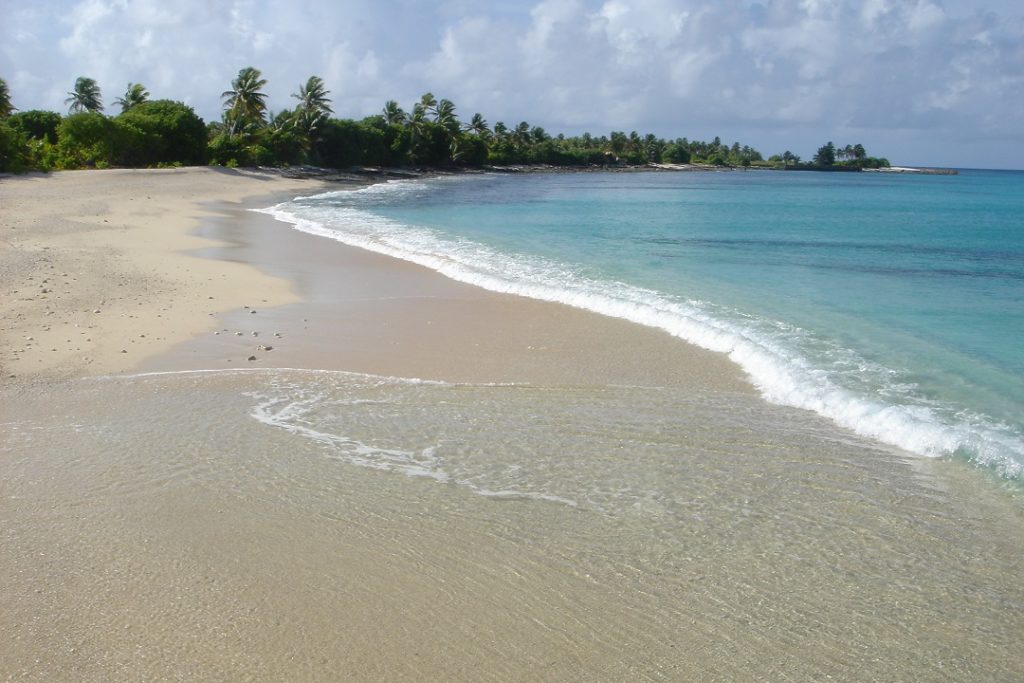
Adding to the initial $6 million for reparations, in 1986 Bikinians received $75 million and later on an additional $110 million.
At the same time, on Mar. 5, 2001, the Marshall Islands’ Nuclear Claims Tribunal awarded Bikinians more than $500 million in compensations. This number, determined after deducting previous reparations, was the verdict of a trial that lasted seven years.
Still, as the tribunal didn’t have that kind of money, Bikinians were forced to ask U.S. Congress for it. As of today, the dispute concerning this payment remains open.
Conclusions
Finished Crossroads, Joint Task Force One concluded that the atomic bomb was a game-changer. But despite being the greatest military exercise yet in history, its results remained inconclusive. At least, for the involved forces.
In this way, the U.S. Navy and the U.S. Air Force couldn’t grasp much from it regarding their role in the nuclear warfare future. At least immediately.
U.S. Navy
The U.S. Air Force repeatedly pointed out how only nine ships survived Crossroads. This was in order to fortify its claim that the U.S. Navy wouldn’t be of much help in the brand-new nuclear age.
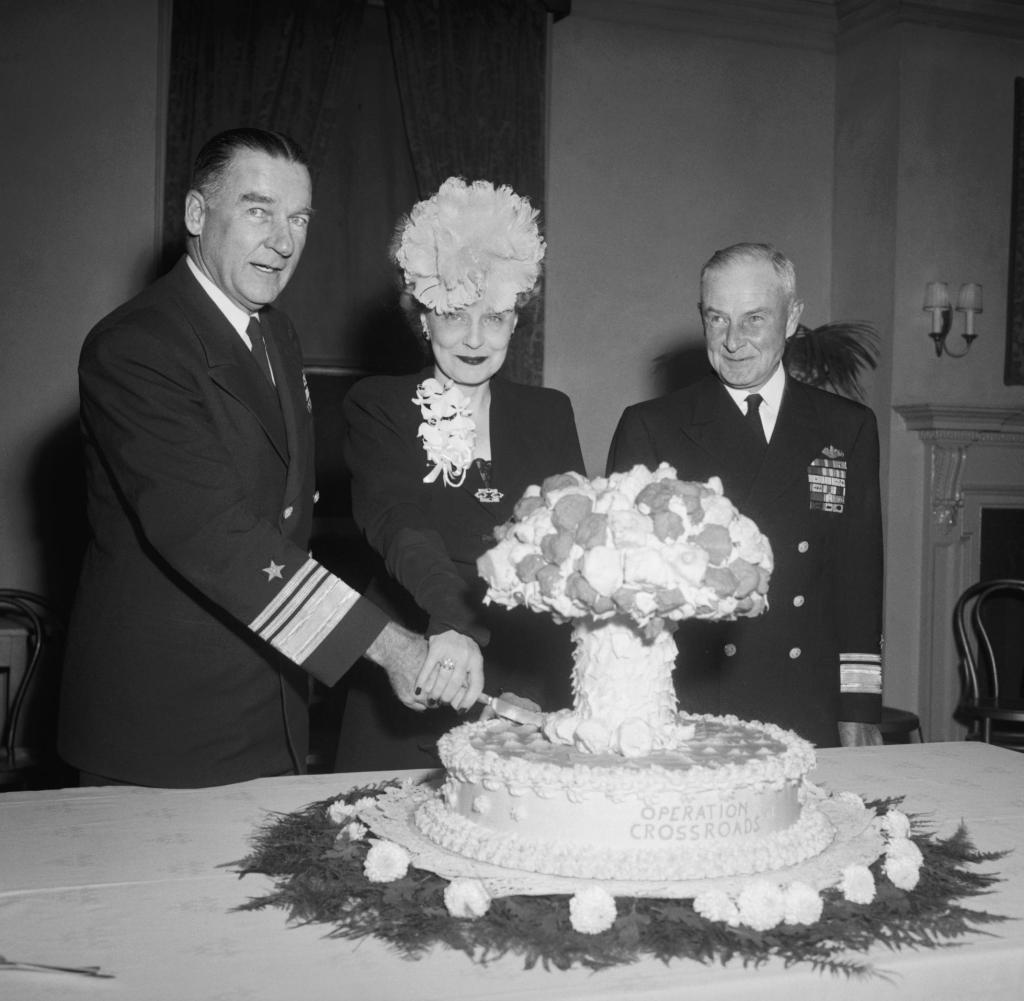
Therefore, in the following months after Crossroads, the U.S. Navy saw in the position of having to justify its military assets. While the U.S. Air Force spoke of the small number of ships surviving the explosions, the U.S. Navy spoke of how few sank. This, of course, overlooked the fact that most ships ended up deadly poisoned.
According to the U.S. Navy, its fleet was not as vulnerable to nuclear weapons as Crossroads presented it. They argued that the test fleets conditions were not fair and far from a proper, real-world scenario.
The target ships neither were able of defending themselves nor were arrayed on a real military formation. Instead, they were tightly close to each other for maximizing damage. If the target fleet had implemented all of these factors, it would have suffered less damage from the blast.
Besides, on Crossroads more modern ships proven much better in supporting nuclear blasts than the older ones. In this way, despite carrier Independence’s superstructure and deck took so much damage, its hull was not greatly affected. Not to mention that new ships could maneuver fairly more efficiently.
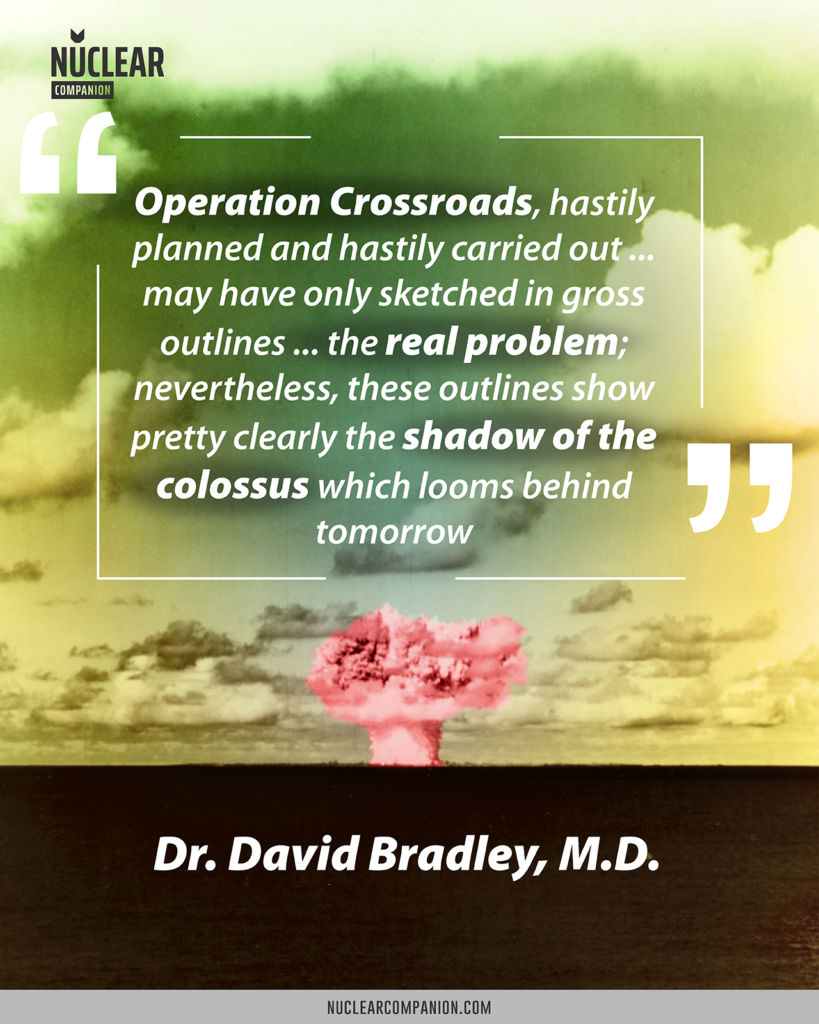
Blandy, for his part, understood that the U.S. Navy obtained tactical value from Crossroads. He learned that, in nuclear warfare, fleets had to move and anchor even more widely spaced one from the other. This lesson in particular, however, was far from justifying the enormous material and human cost of Crossroads.
Finally, by 1946 the U.S. Navy added three new technological agencies. The criticism towards the U.S. Navy only draught up the necessity of upgrading ship designs for facing nuclear explosions. Such a conclusion ignored the fact that the blast of a nuclear bomb was not as destructive as its radiation.
All things considered, if the U.S. Armed Forces learned something from Crossroads was how dangerous a nuclear fallout could be. In this sense, scientific authority Glenn Seaborg described Baker as the world’s first nuclear disaster.
In 1948, famous writer E. B. White said that the U.S. Navy wasn’t fond of this type of invisible threat, as it dishonored the ways of conventional warfare.
The “invisible” part of nuclear devices was a new and, more importantly, deadlier weapon. Especially, thanks to plutonium and its alpha particles.
Still, developing technologies for protecting U.S. Navy crews from radioactivity wasn’t off the table. New craft designs included hulls and equipment more resistant to radiation, as well as systems for washing it down.
These efforts came despite knowing that sailors couldn’t handle radiation completely. It was rather the U.S. Navy‘s way of acknowledging that its sailors had to prepare themselves to face such a scenario.
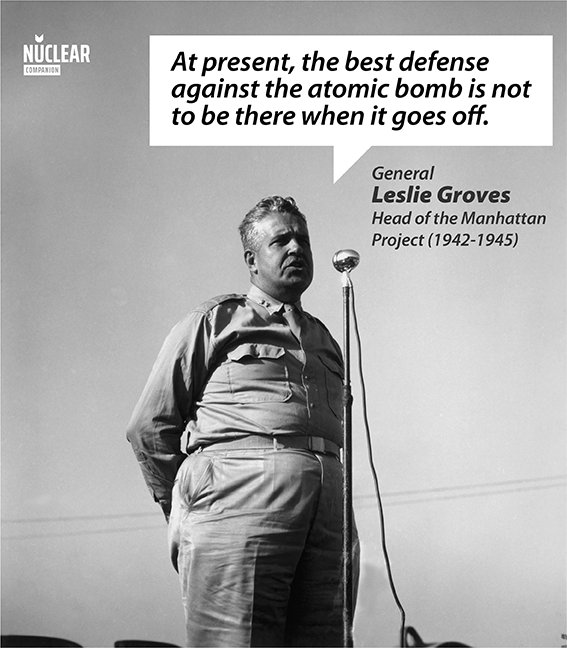
Still, this dreadful message was exclusively for the military. For civilians, the U.S. Government came up with a civil defense program for nuclear protection that belittled the gravity of a nuclear war.
U.S. Air Force
After Crossroads, the U.S. Air Force was not left behind either. While the U.S. Navy had to prove that carriers could launch nuclear weapons, the B-29 was already up and running.
Despite missing its target during Able, the B-29 was the main if not the only vehicle capable of delivering nuclear bombs. The prevailing opinion was that only newer aircraft still under development could match or surpassed it. This granted the U.S. Air Force a leading role for the time being on the U.S. Nuclear Arsenal.
In this sense, the U.S. Air Force got a thing or two from Crossroads. The operation was its door to the nuclear program, even more than Trinity, Hiroshima and Nagasaki detonations.
These bombings occurred during the high-paced nature of war. Crossroads, on the other hand, took place during peacetime. As such, it was mostly a training experience on nuclear weaponry and technology for the U.S. Air Force and its personnel.
Before the operation, it had but a few nuclear expert officers. Nonetheless, the selection process for the bombing crew resulted in more nuclear-skilled pilots. Moreover, it allowed the U.S. Air Force to familiarize and establish ties with Los Alamos’ nuclear experts.
Los Alamos Laboratory
Regarding Los Alamos, we saw earlier how Crossroads massively halted its nuclear projects. Its participation, nonetheless, paid off as invaluable experience on nuclear operations.
It’s important to notice that Crossroads took place in a time of reconstruction for Los Alamos. After the end of the war left the laboratory without a clear objective.
In this way, Crossroads was a large-scale operation handy for testings Los Alamos’ ability under the pressure of public opinion. Moreover, the recent farewell of many senior members made Crossroads a perfect scenario for newer technicians to step up.
Among the things Los Alamos learned from Crossroads was that nuclear weapons worked underwater as intended. Technicians were also able to observe the effects of nuclear weapons and their radiation on water. Furthermore, reports of the explosions linked nuclear fallouts with the presence of materials such as dust.
And for the rest of the World it was a clear taste of the things to come.
Selected Bibliography
- Atomic Audit: The Costs and Consequences of U.S. Nuclear Weapons Since 1940, Stephen I. Schwartz
- Bombing the Marshall Islands: A Cold War Tragedy, Keith M. Parsons, Robert A. Zaballa
- Bombs at Bikini; the official report of Operation Crossroads, W. A. Shurcliff
- Bombs over Bikini: The World’s First Nuclear Disaster, Connie Goldsmith
- Ghost Fleet: The Sunken Ships of Bikini Atoll, James P. Delgado
- Manhattan District history Project Y the Los Alamos Project: vol. II, August 1945 through December 1946, Edith C. Truslow
- Nuclear Dawn, James P. Delgado
- Operation Crossroads: The Official Pictorial Record, Office of the Historian Joint Task Force One
- Operation Crossroads: The Atomic Tests at Bikini Atoll, Jonathan M. Weisgall
- For the Good of Mankind: A History of the People of Bikini and Their Islands, 2nd Edition, Jack Niedenthal
- The Swords of Armageddon, Version 2, Volume VII, Chuck Hansen
Now It’s Your Turn
I hope you enjoyed this article.
Now I’d like to turn it over to you:
What is your opinion about Operation Crossroads?
Either way, let me know by leaving a comment below right now.
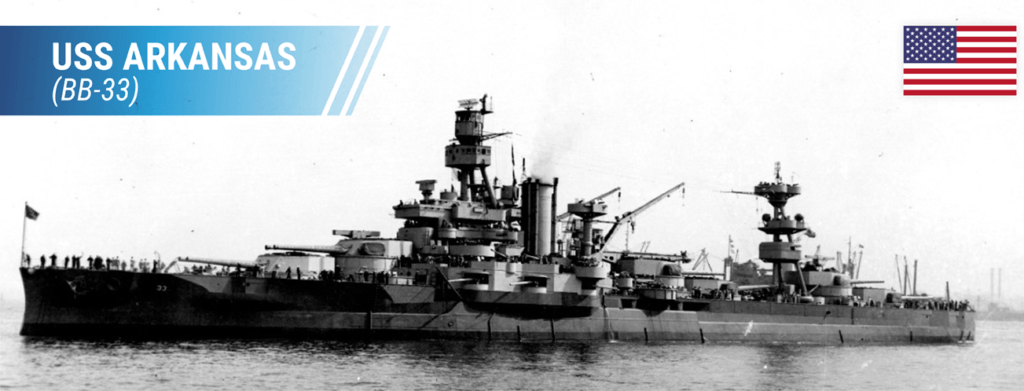
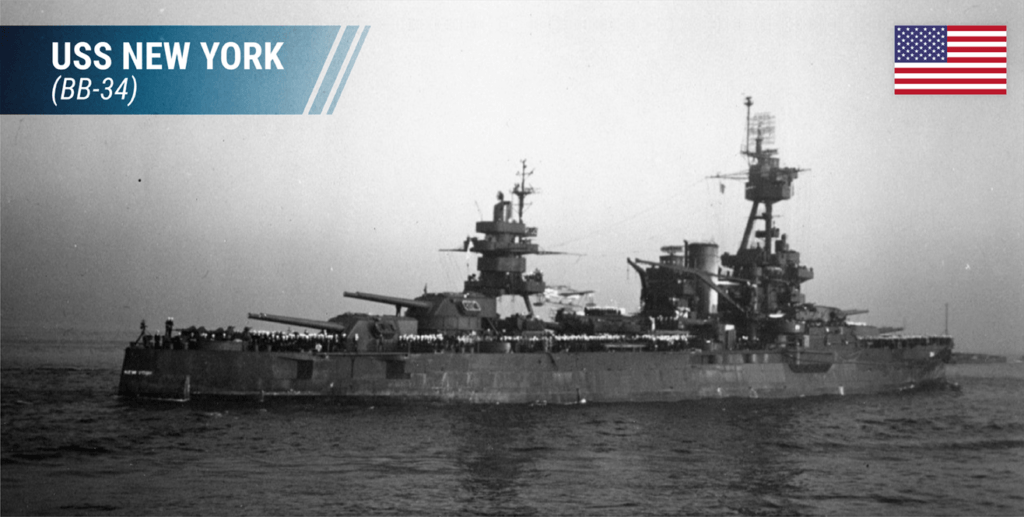
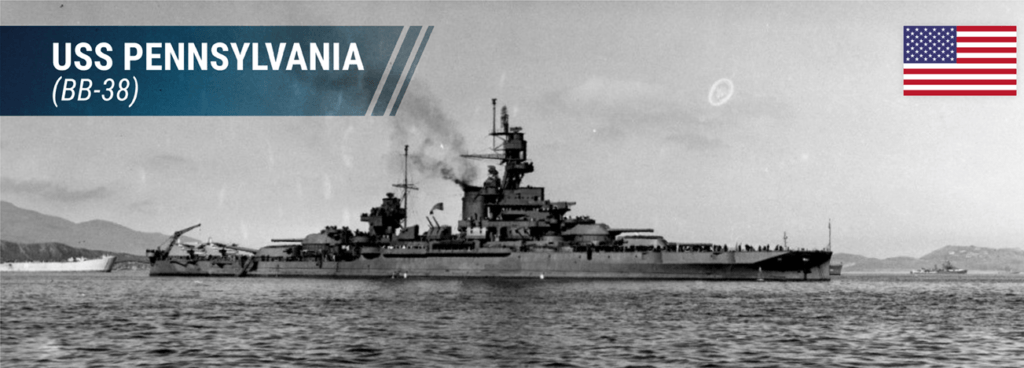
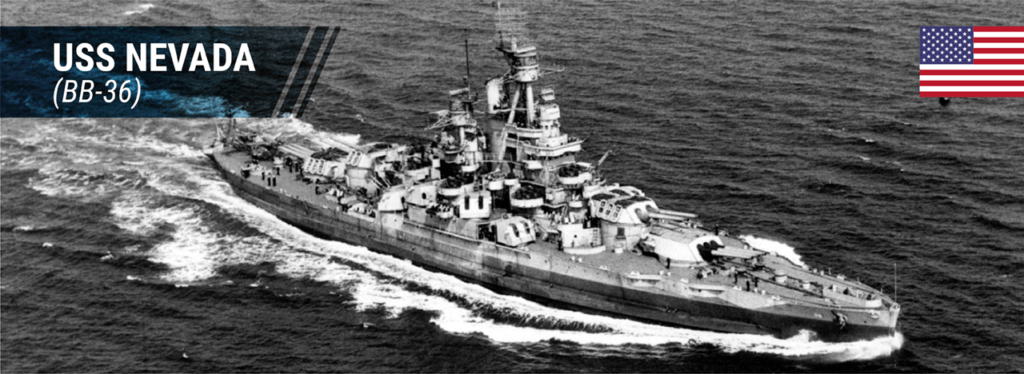
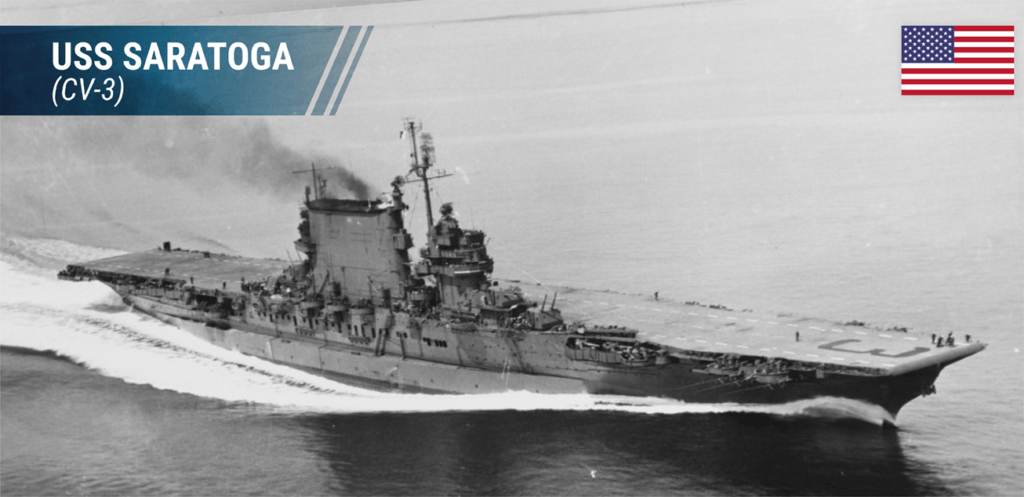
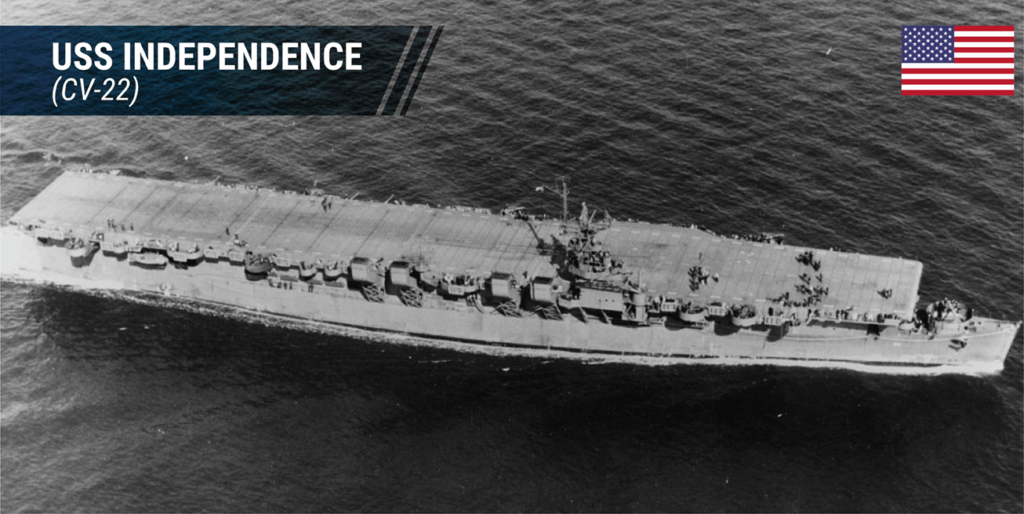
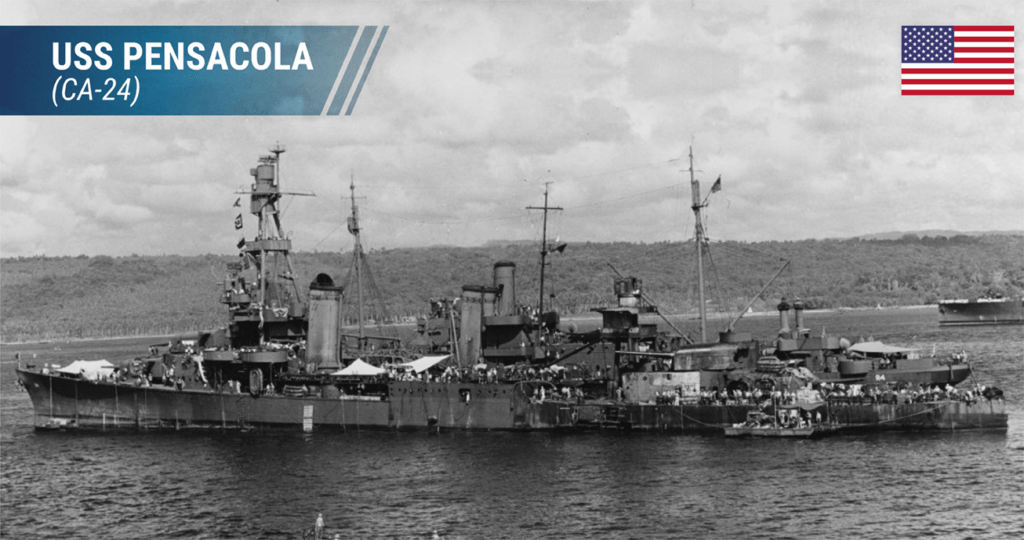
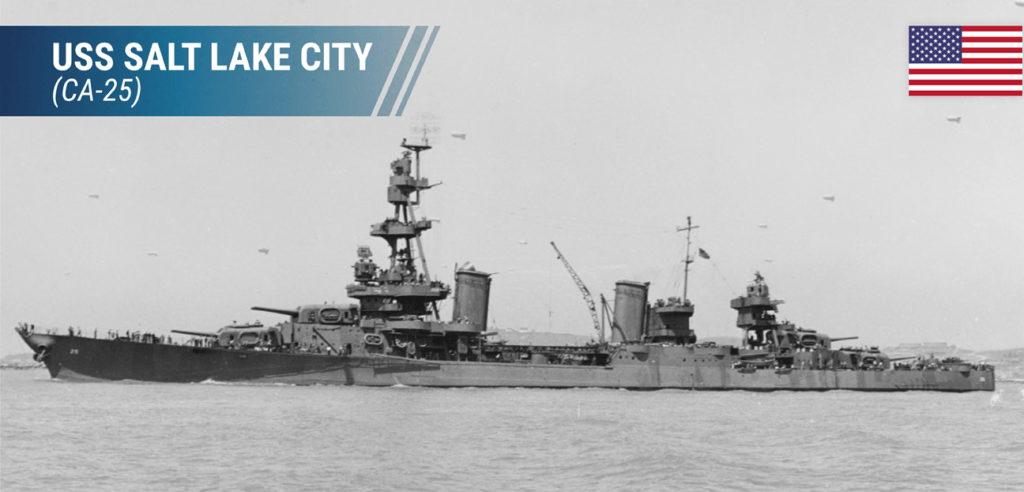
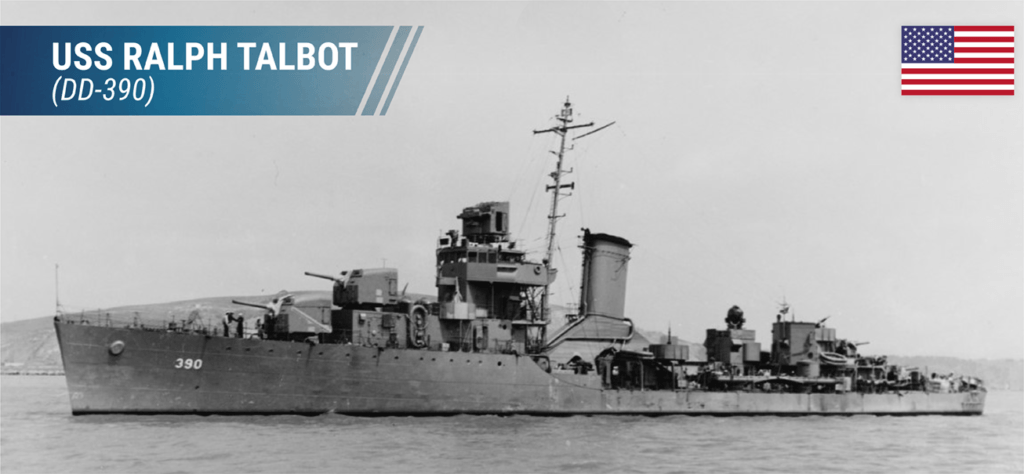
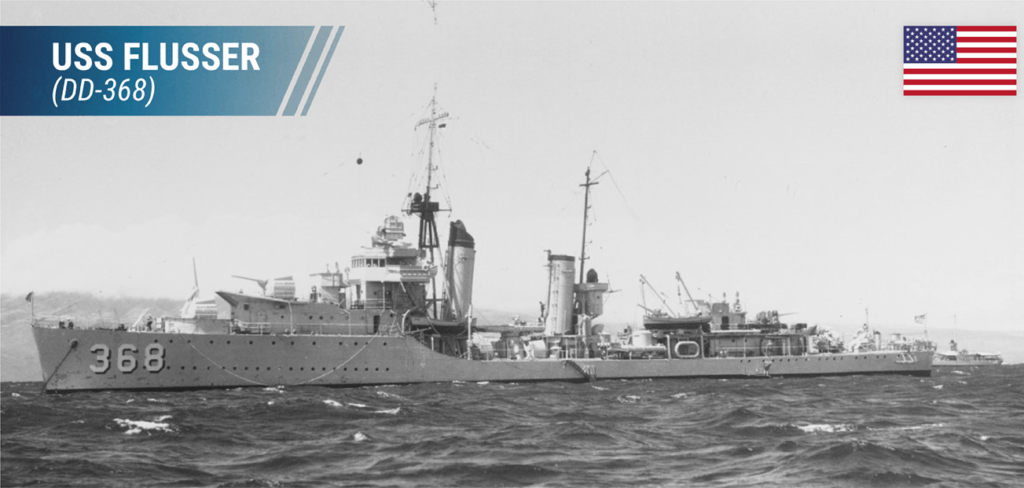
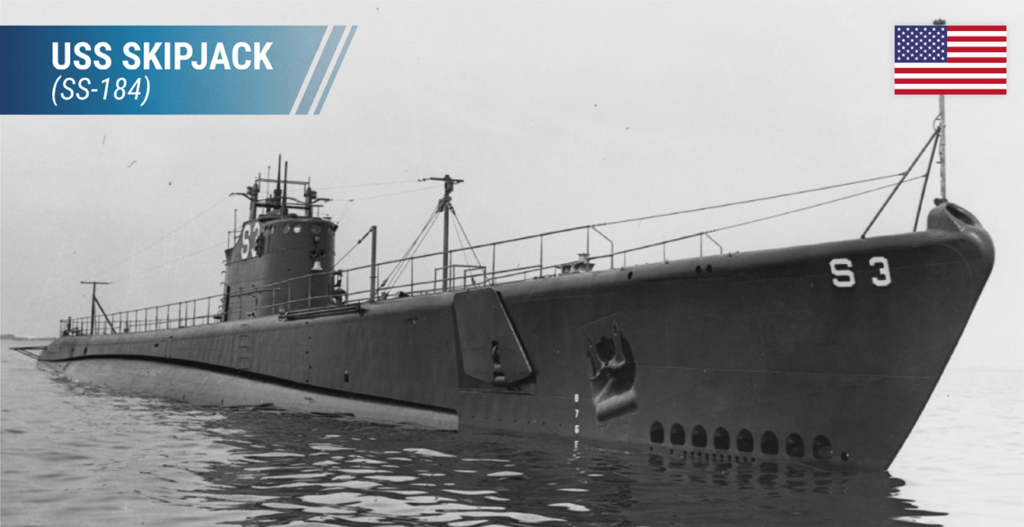
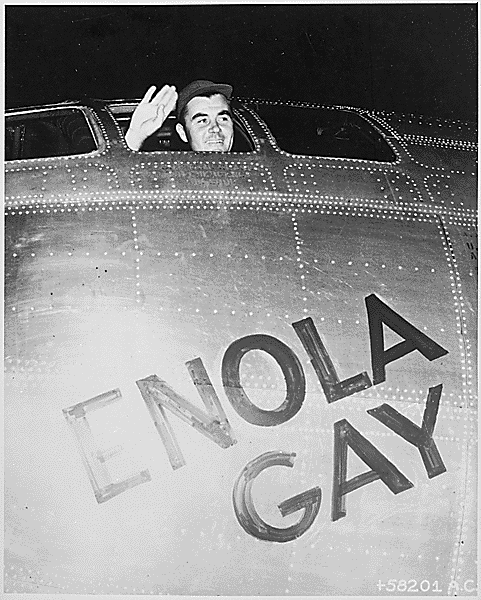
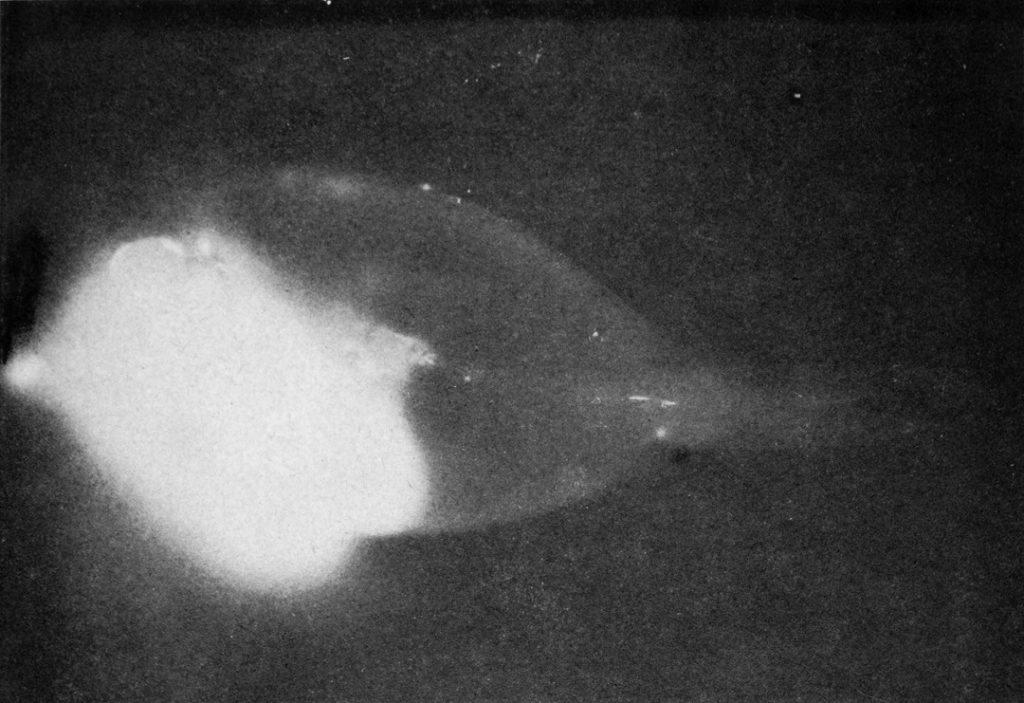
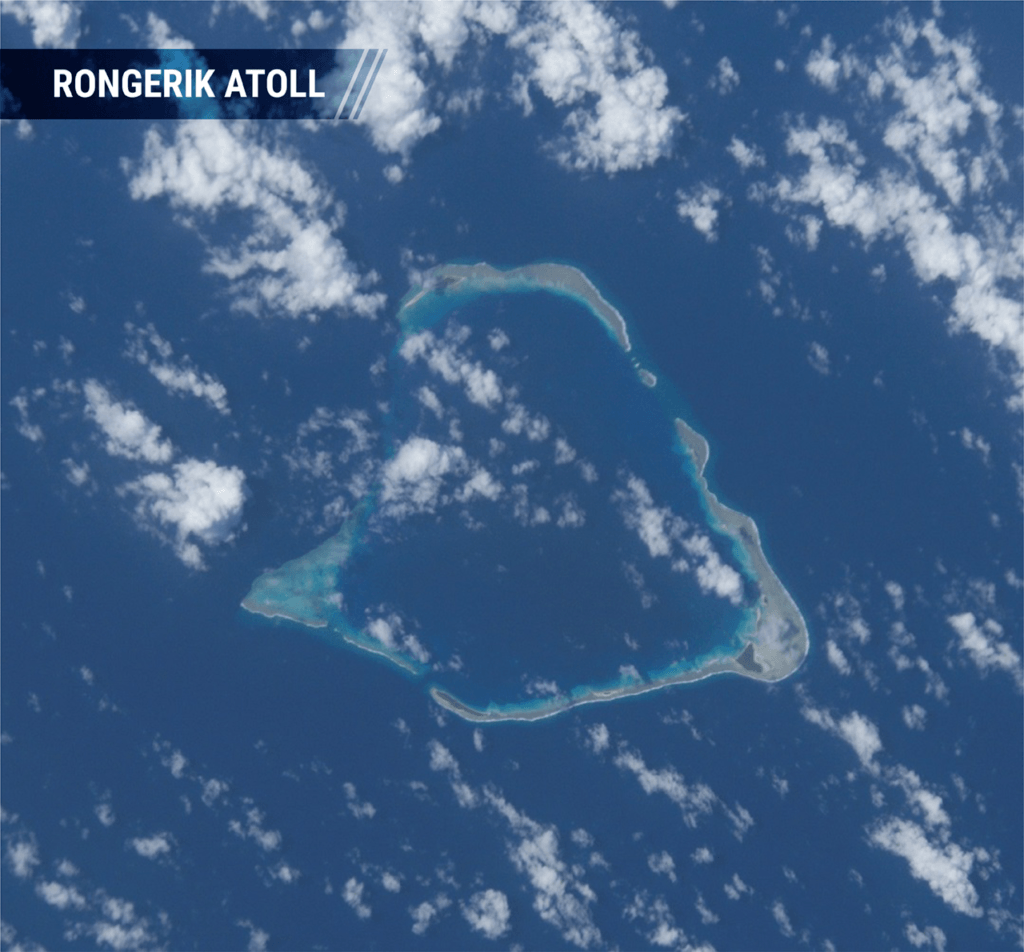
Nowhere else can you dive such a fantastic collection of wrecks, including battleships, submarines, destroyers, and most notably the aircraft carrier USS Saratoga. Over 60 years later, the nuclear ghost fleet (as these wrecks are known) rest in crystal blue waters that have since become home to an abundance of marine life with thriving reefs and corals. Only since 1996 has Bikini Atoll been open to diving, making this destination a one-of-a-kind combination of spectacular historic wrecks in a remote and otherwise untouched tropical paradise.
Our Father was there on the USS Enoree ao-69, we were lucky to have him in our lives till 2004.
He had shared with us his times there as we also knew many of his shipmates. He passed of his cancer that was growing inside for many years. He had seen many of his fellow buddies pass of various forms of cancer. They were all proud men, as they said they were just doing their job. He detailed how they had to clean and paint the ships, before going into Pearl Harbor, but were still so “HOT” they weren’t allowed. Swung Around went back to San Francisco repainted the ship. But were denied there so it was back to Philly and there it sat and I believed finally decommissioned in 1977. Thank you for great read, it is spot on.
I am fortunate to have all my fathers and Grandfathers Naval history and belongings from 1906 to 1953..
The USS BURLESON APA – 67 was used by the US Army to train troops being sent to Vietnam in the early ’60’s. How many Agent Orange casualties were really from fall-out? I would be glad of a reply.
Hi Trevor. Thanks for your comment on the USS Burleson APA-67 and its connection to Vietnam. Determining the exact number of Agent Orange casualties due to fallout is challenging. Sorry I can not help you on that. I recommend looking into official sources and research reports for more information on this complex issue.